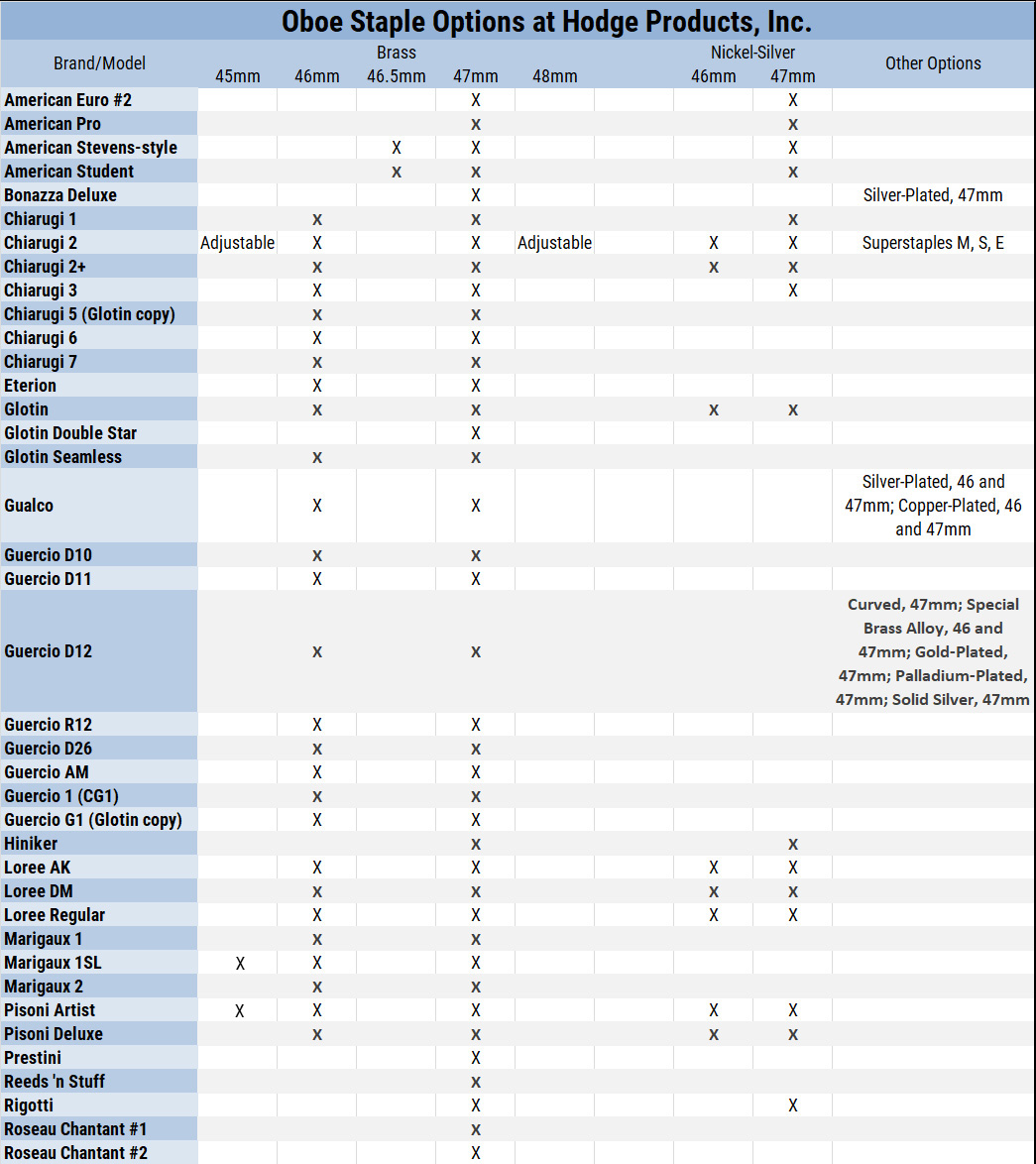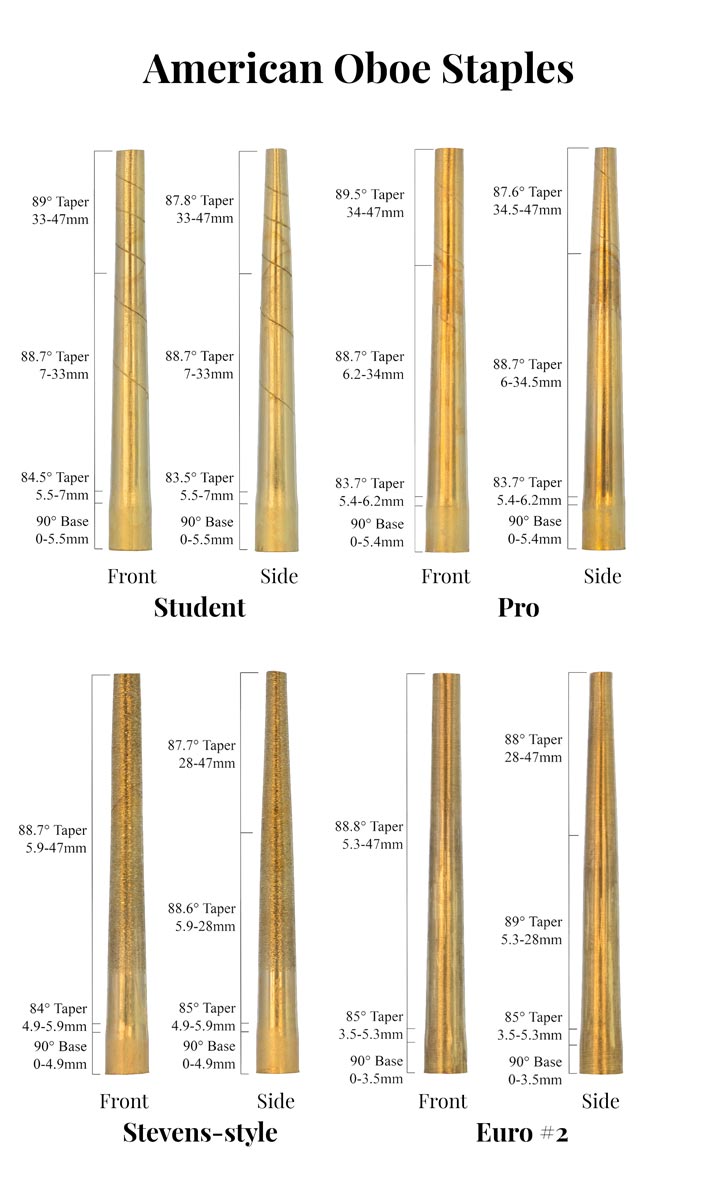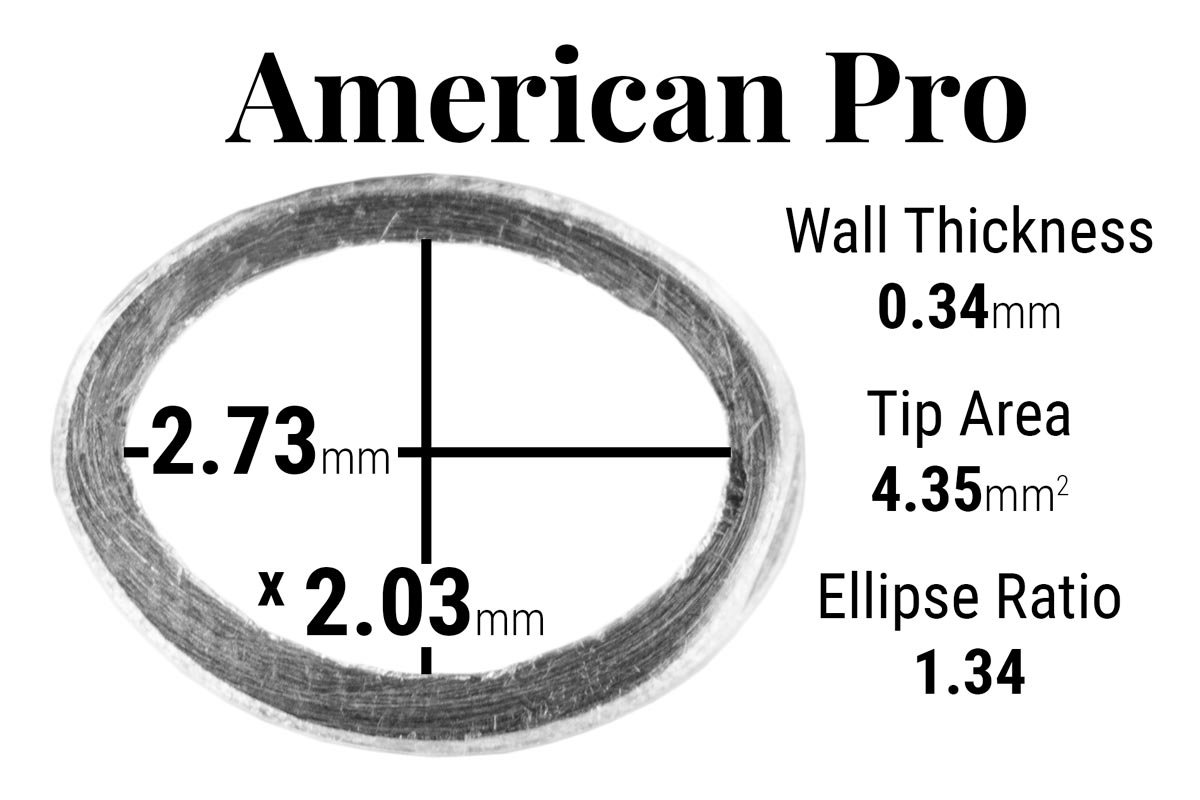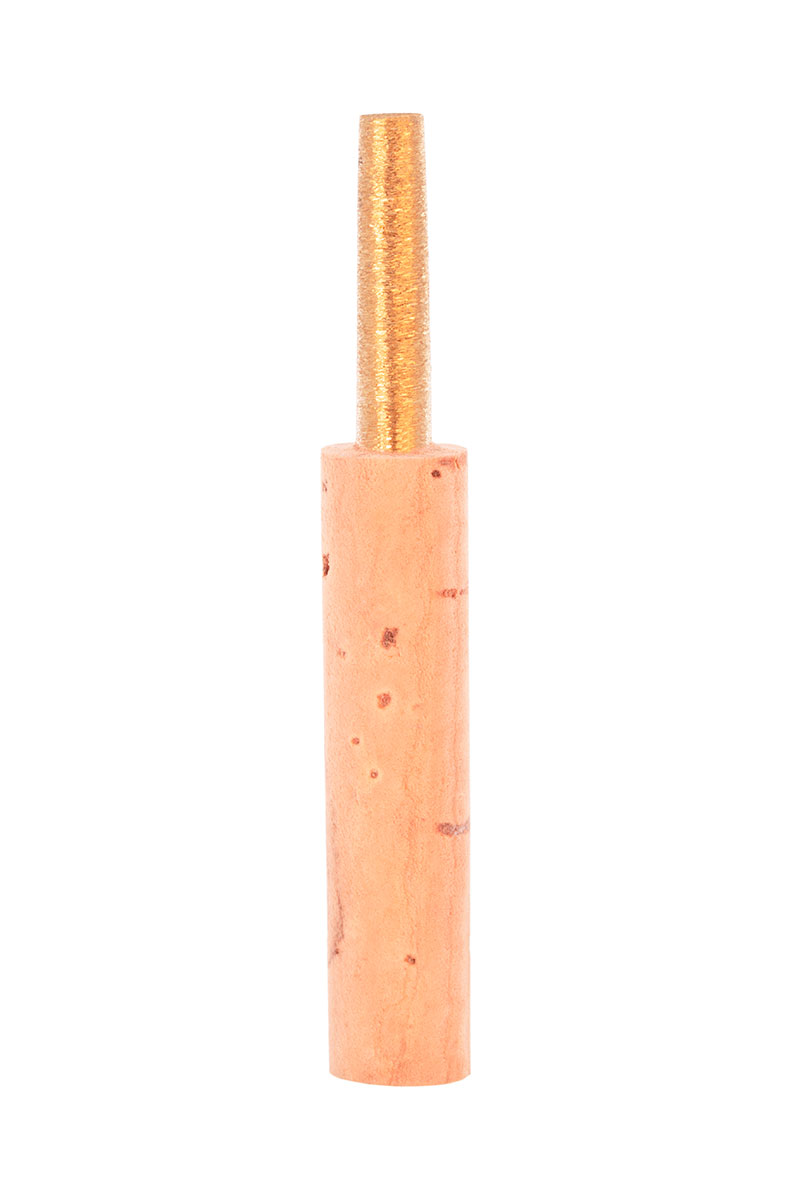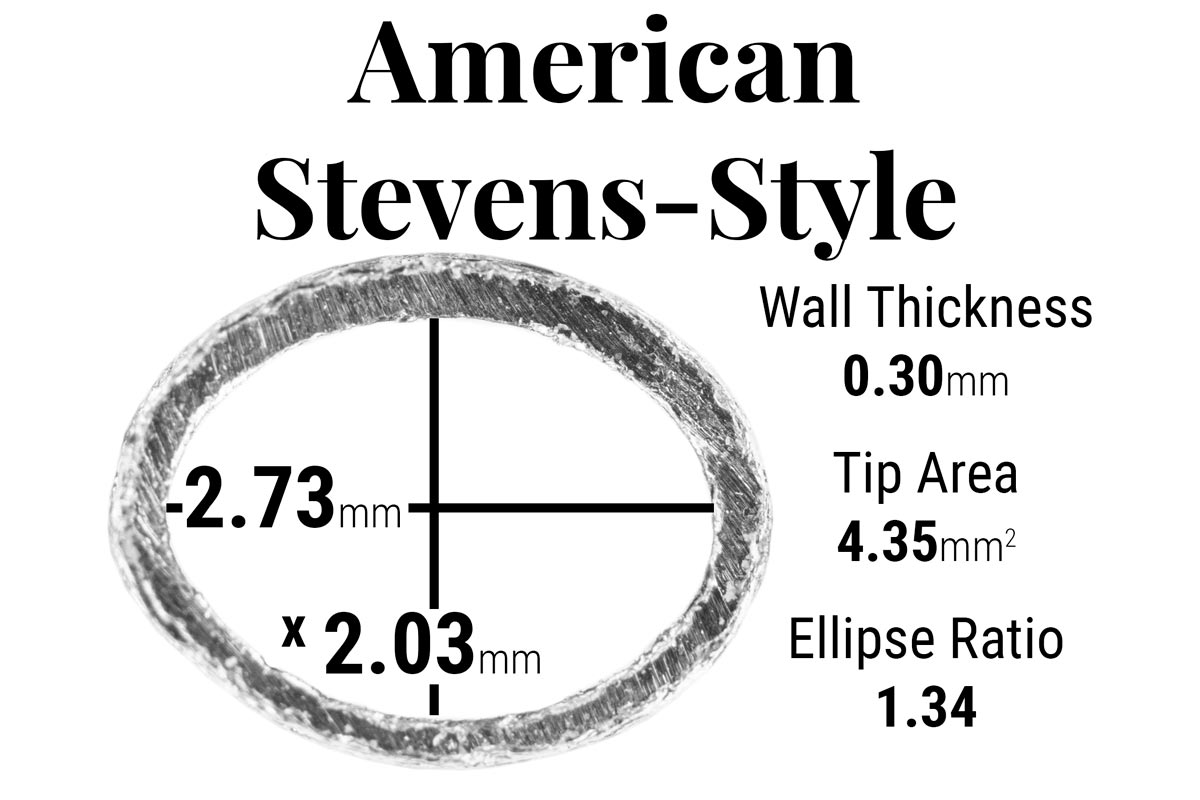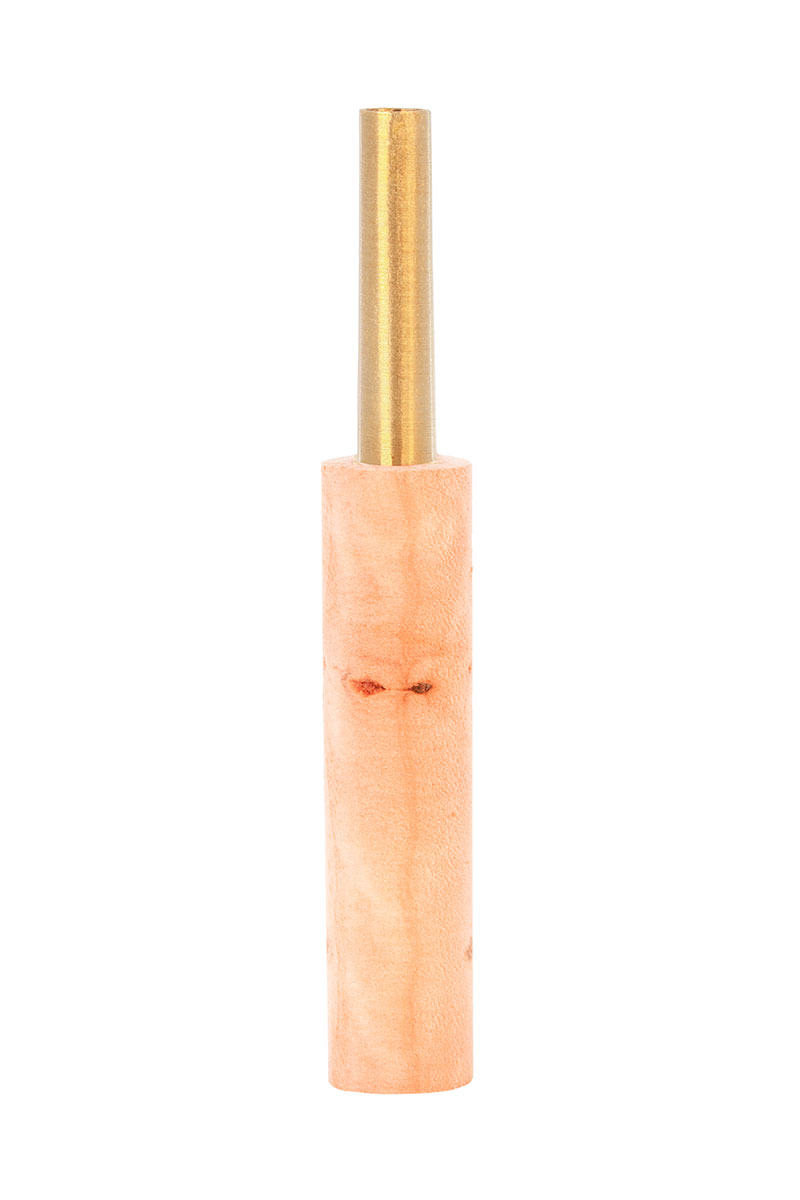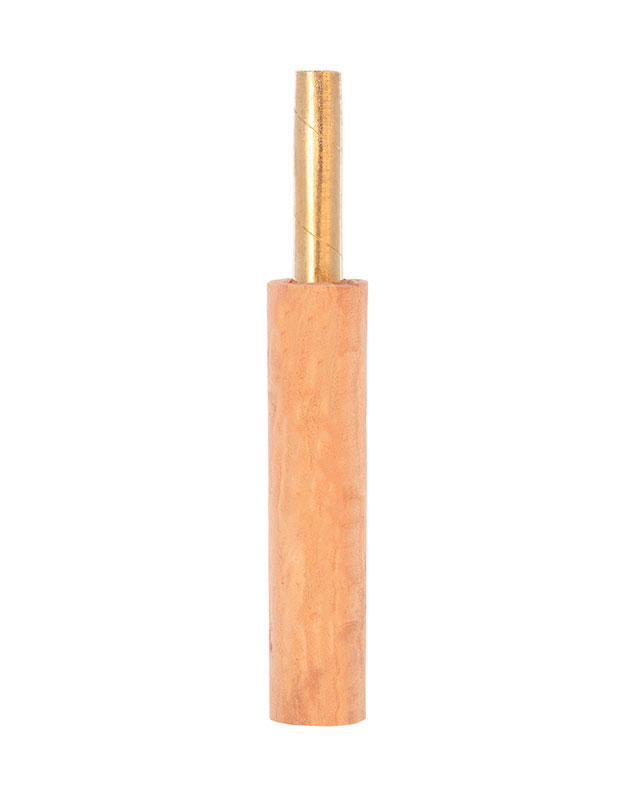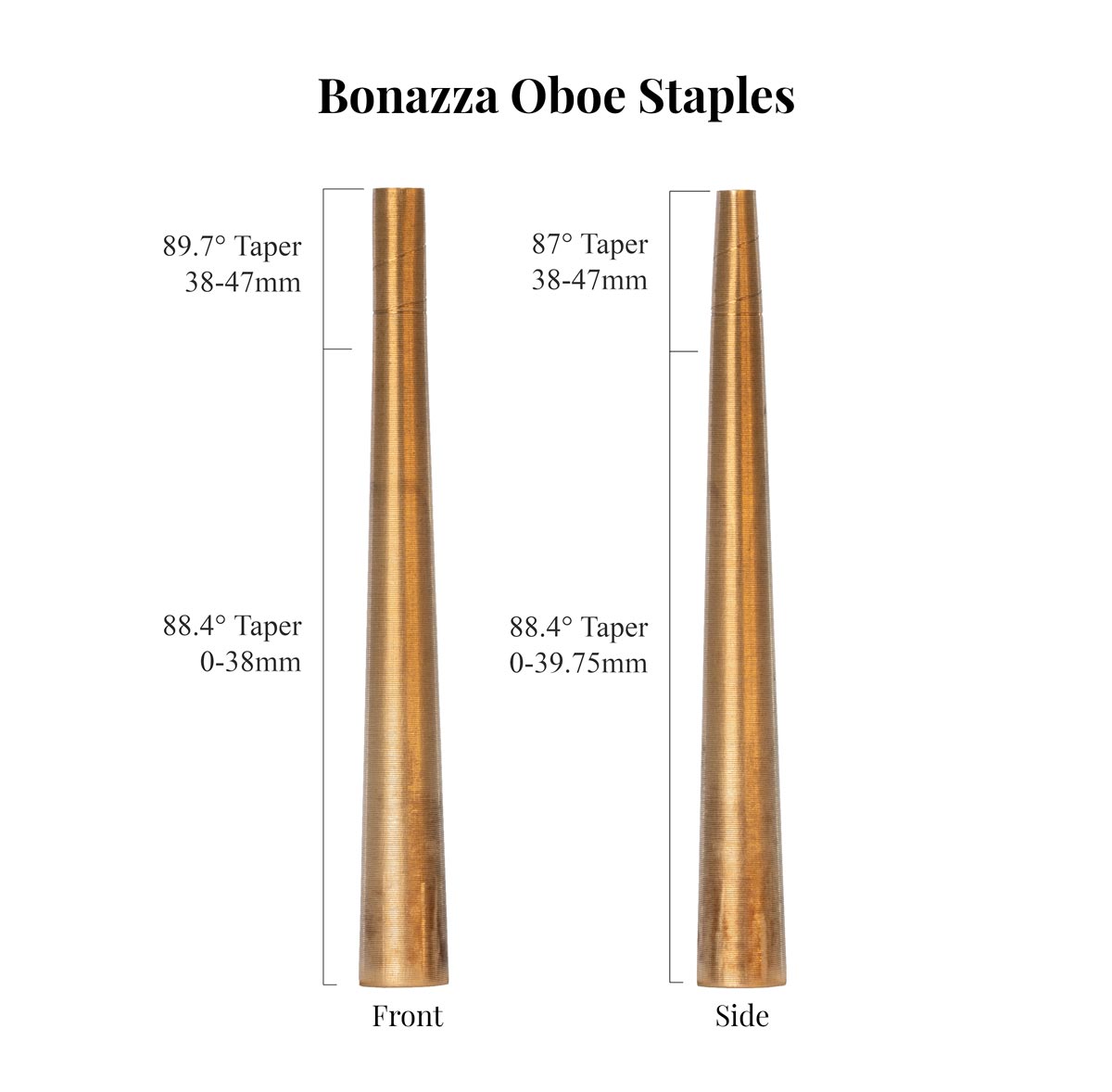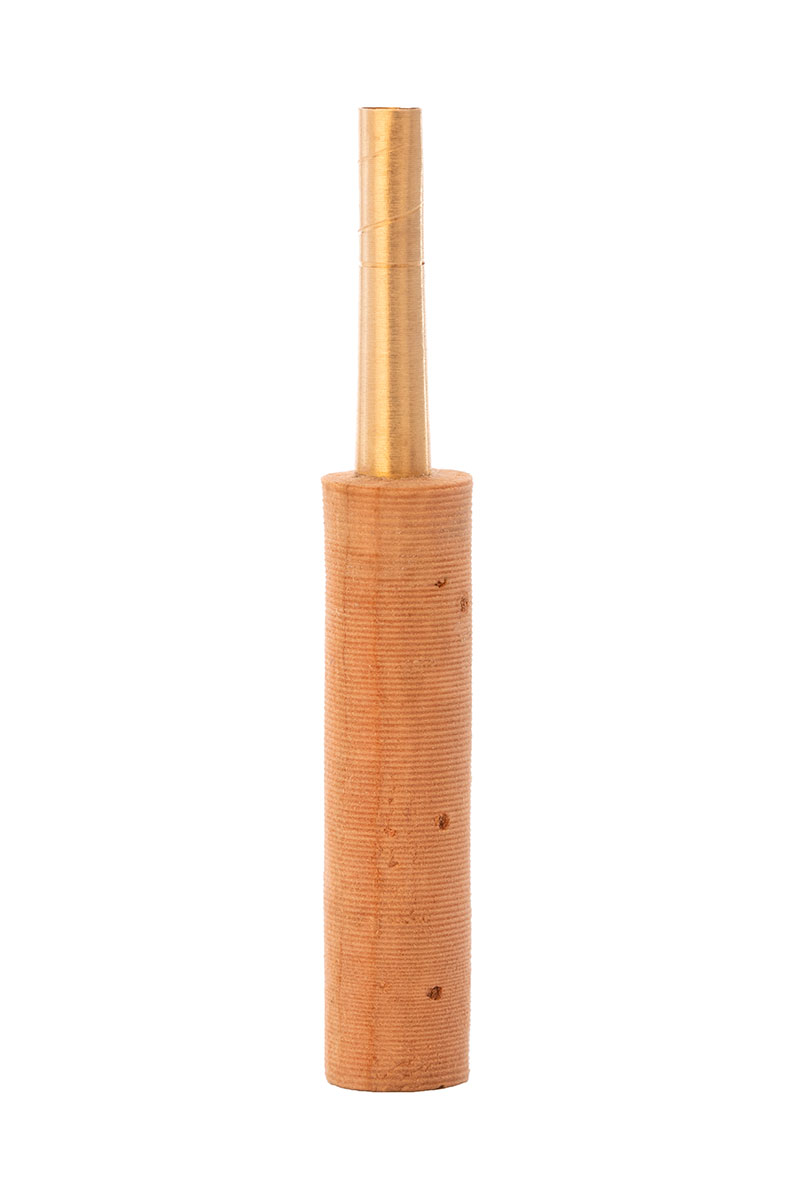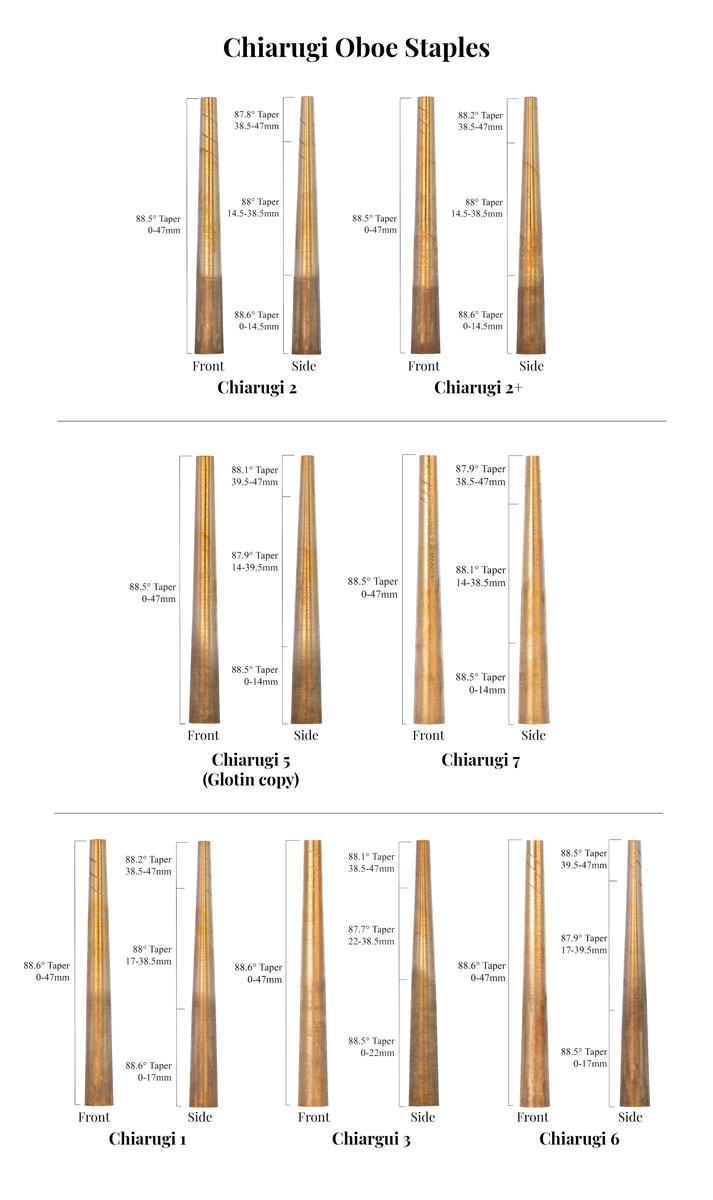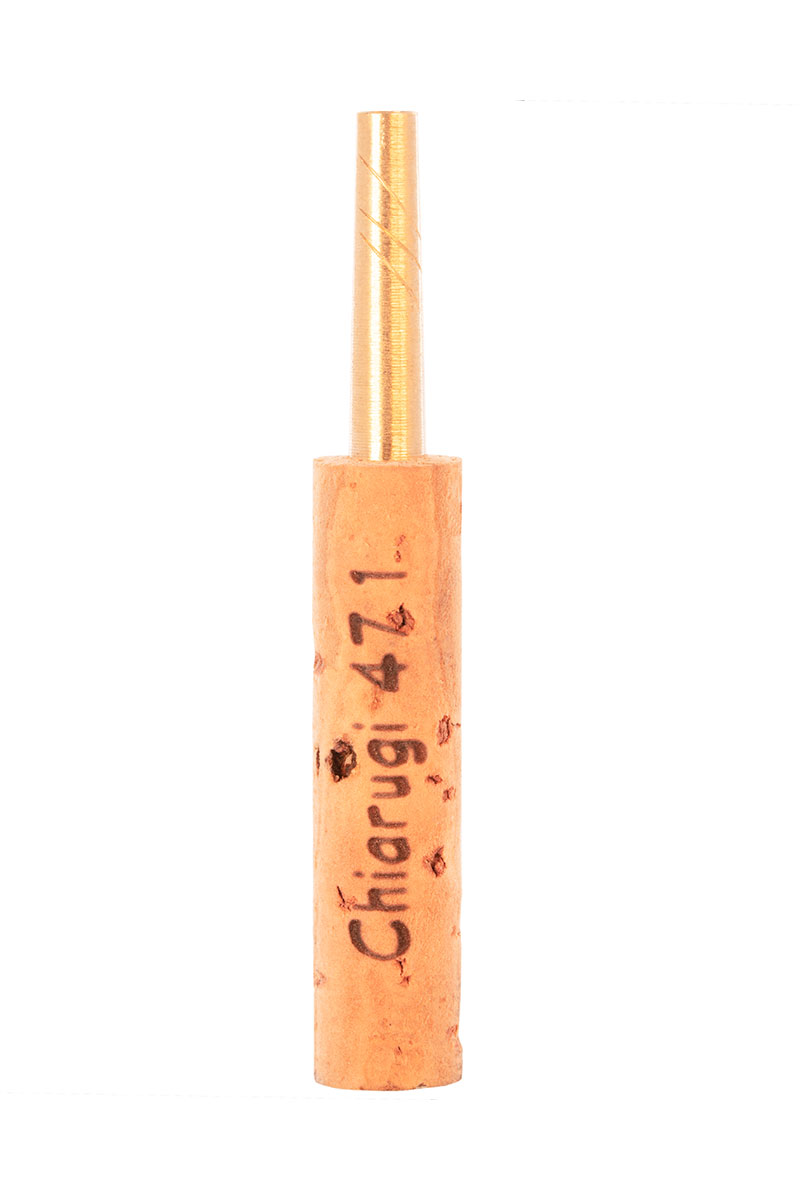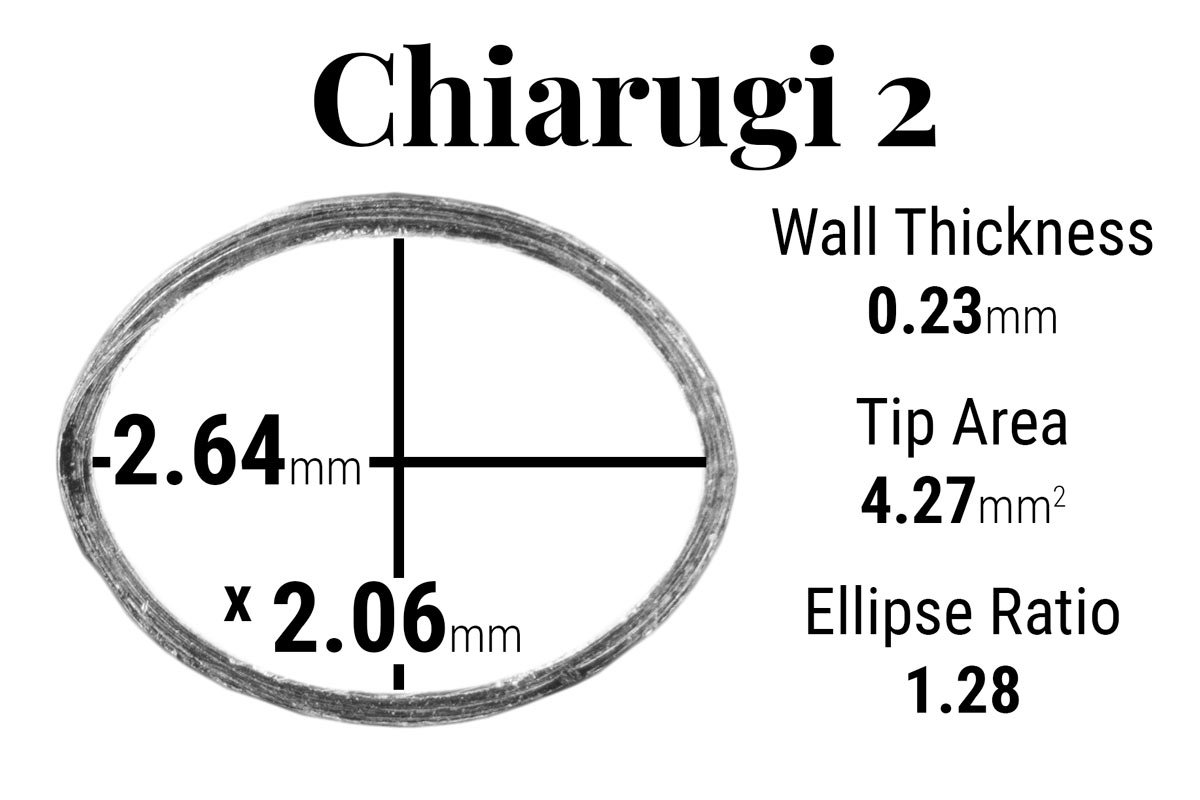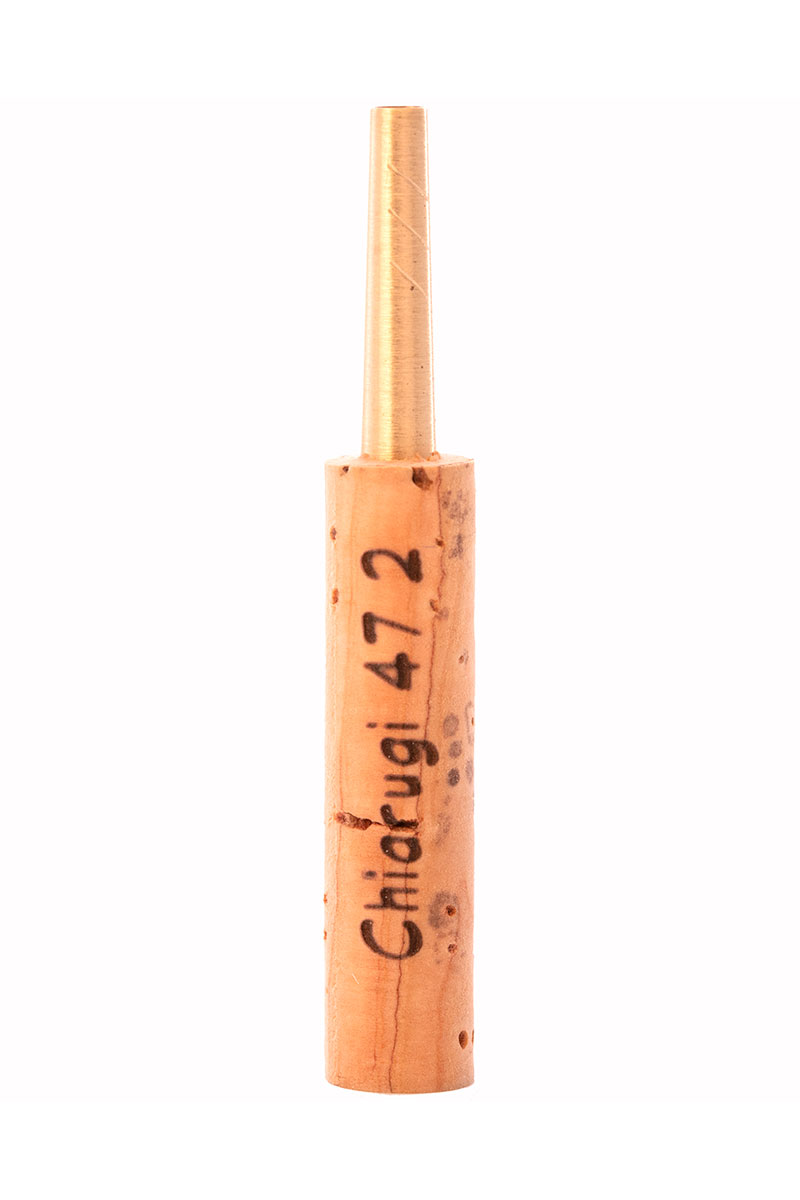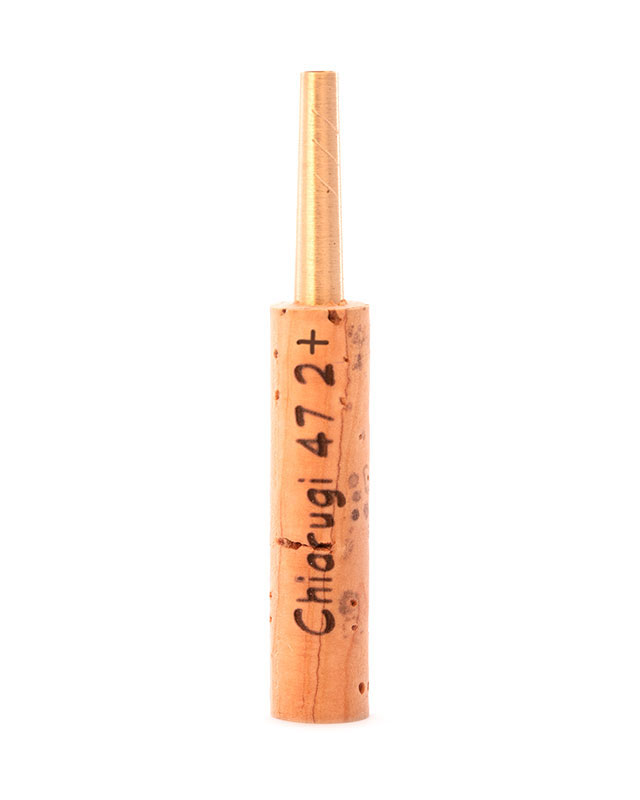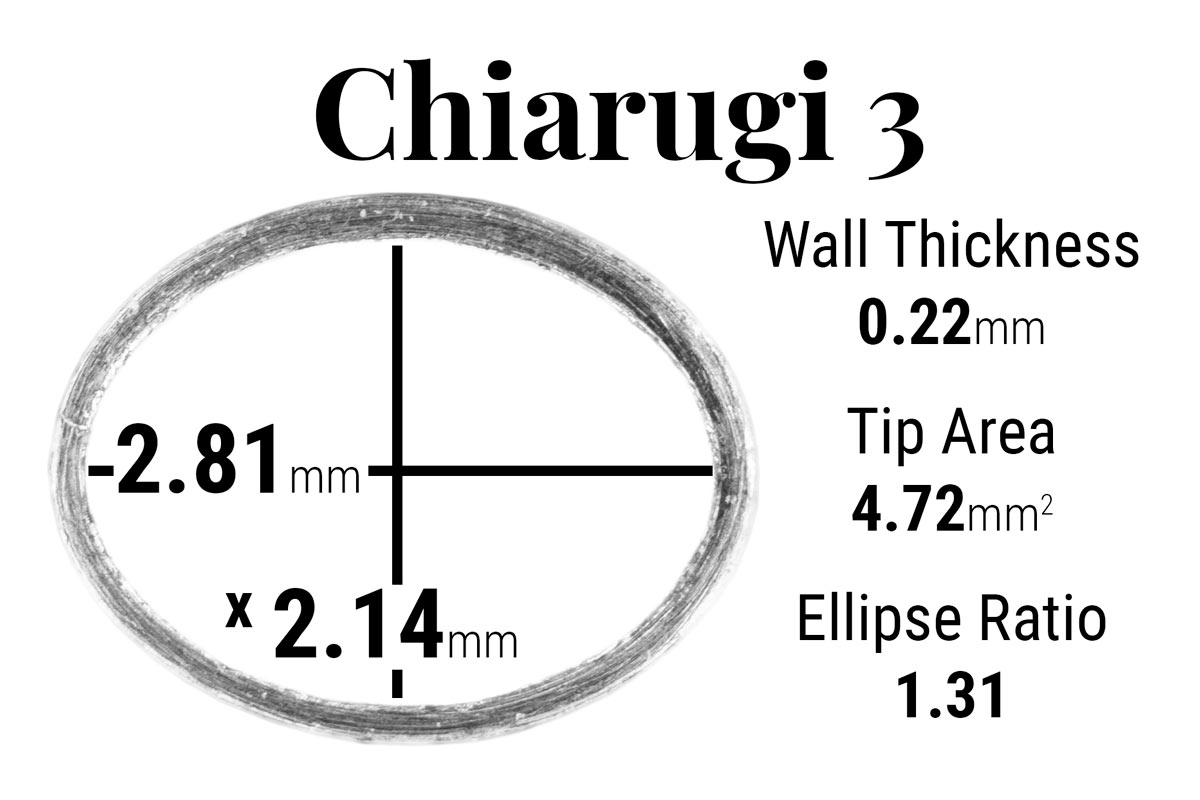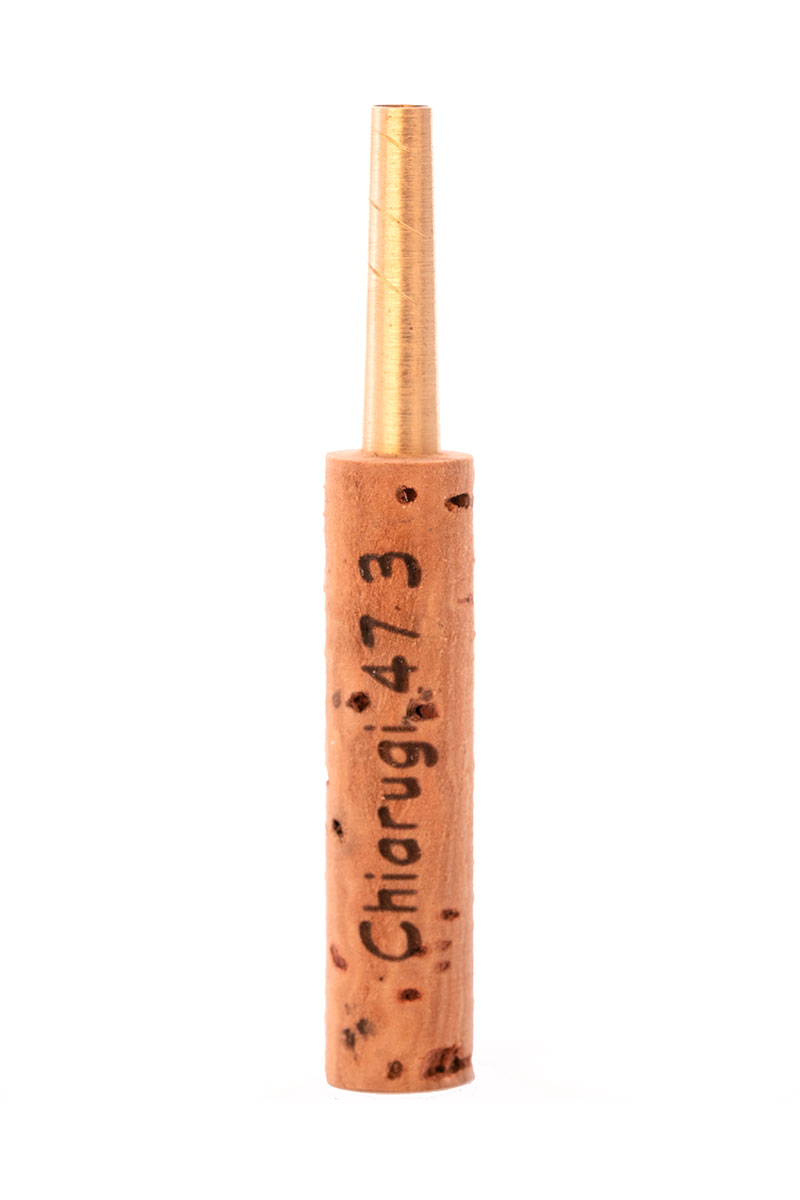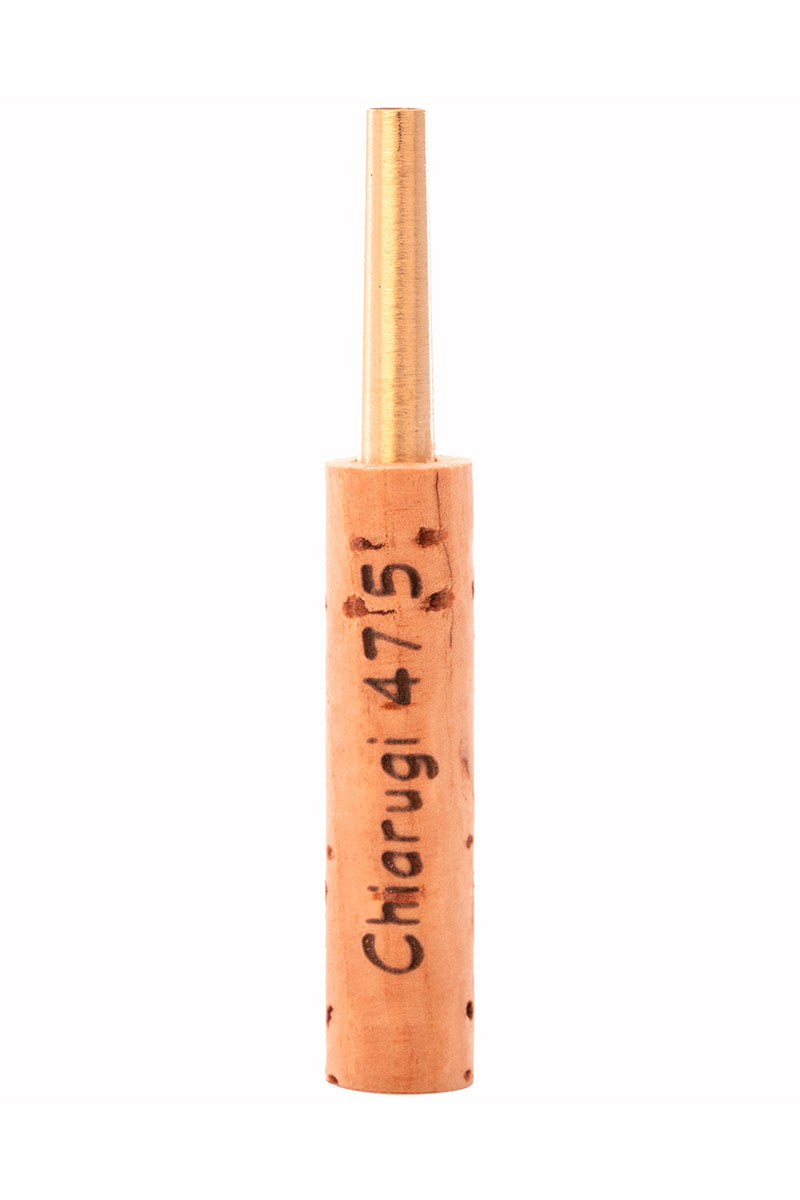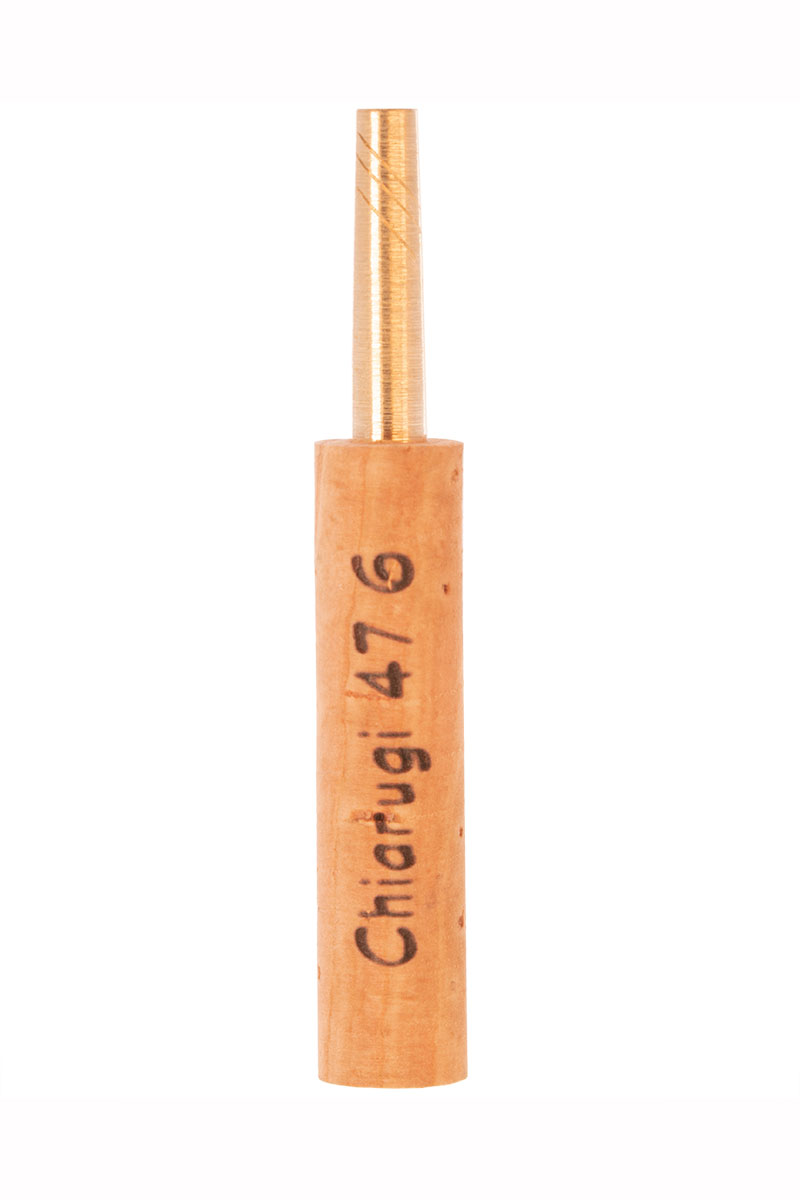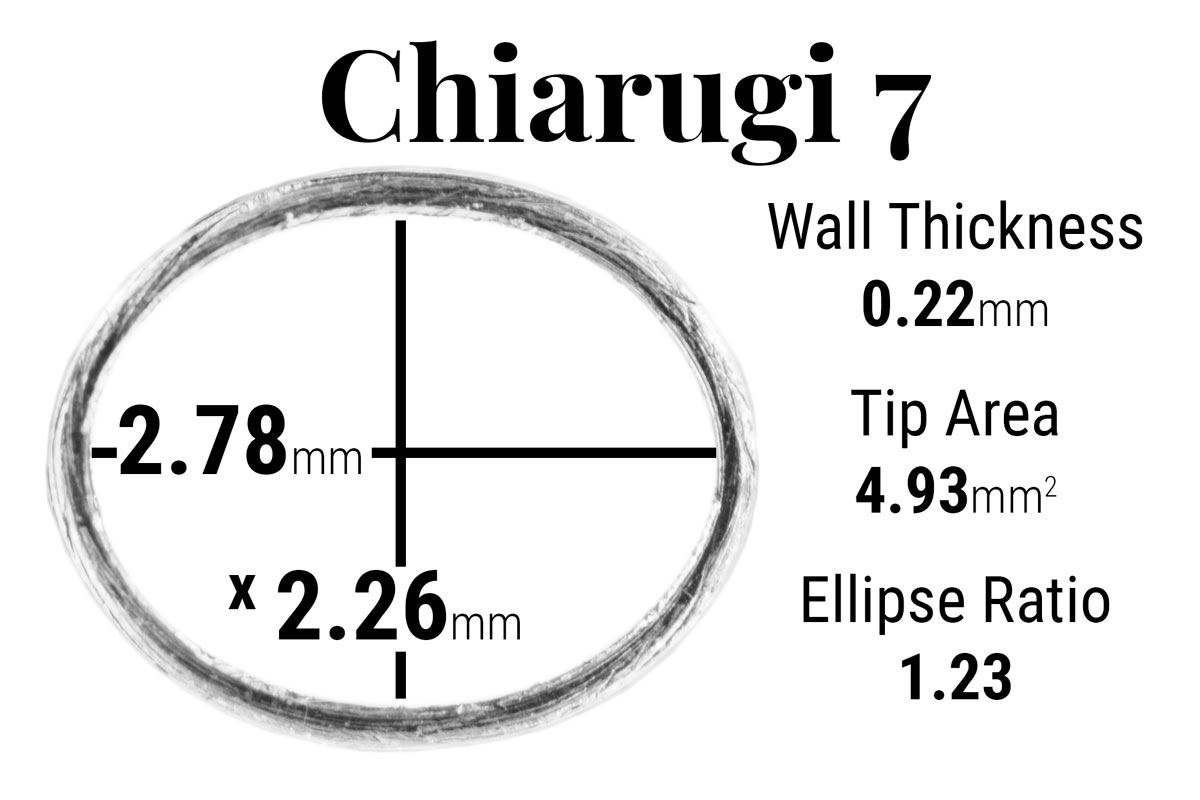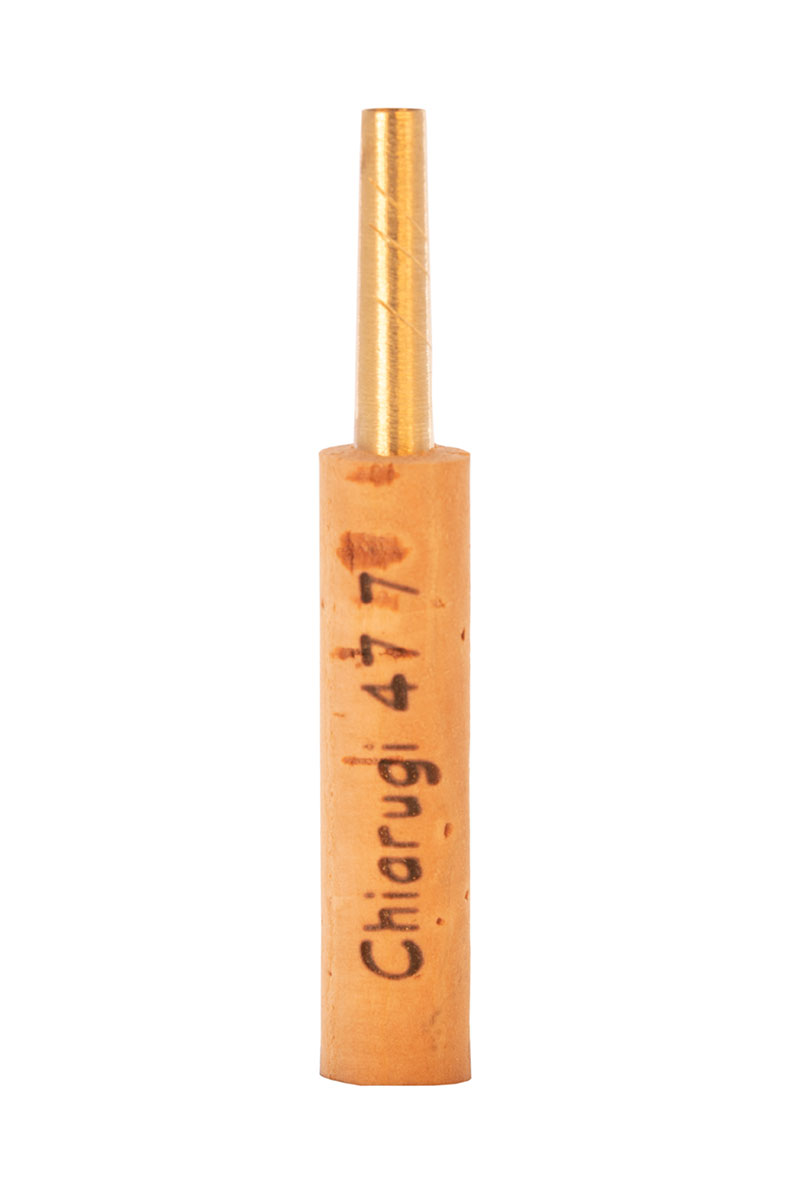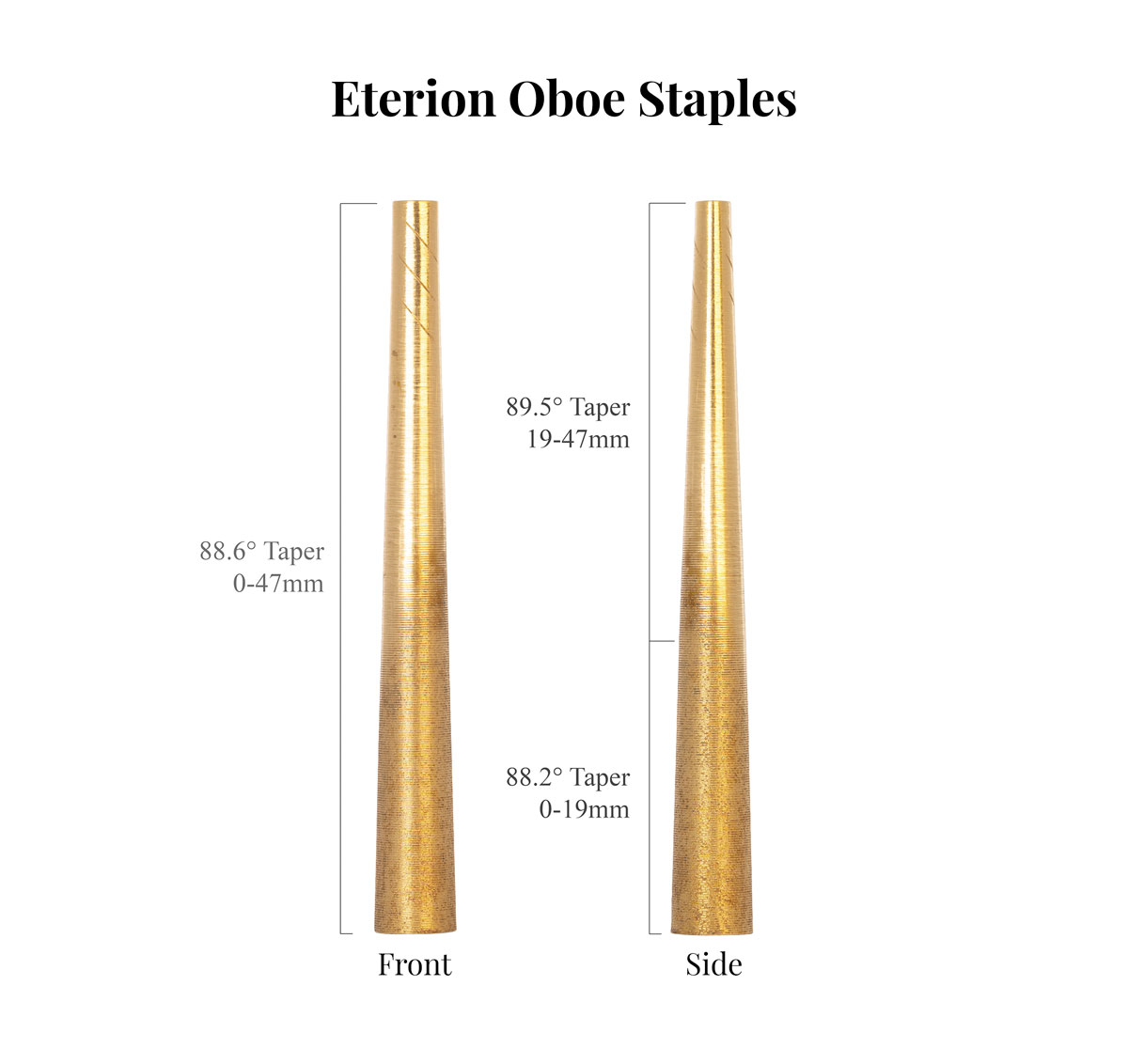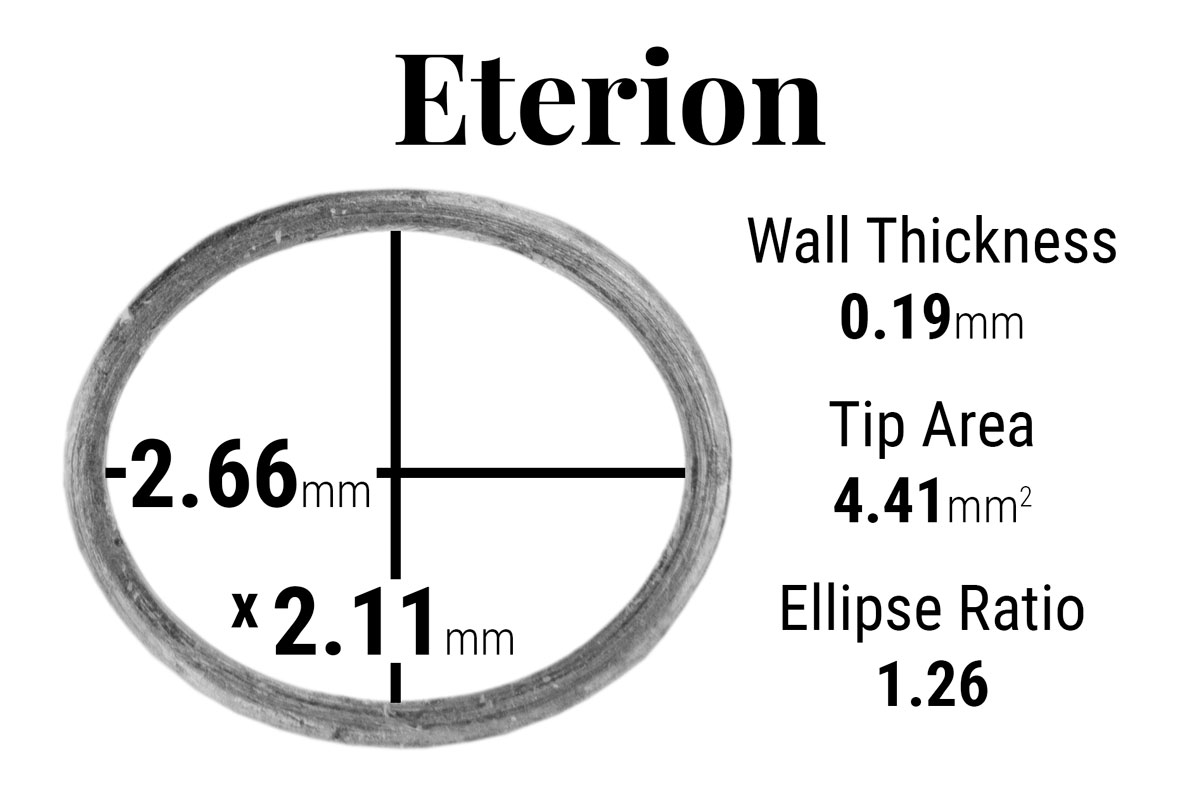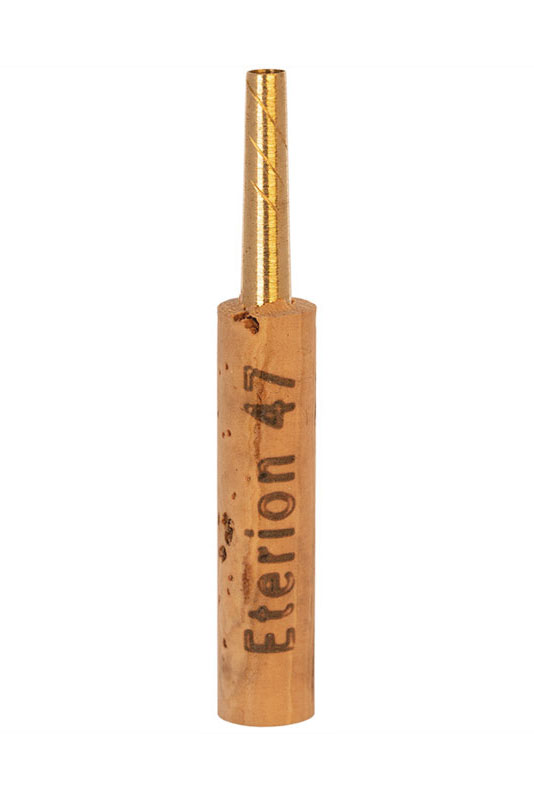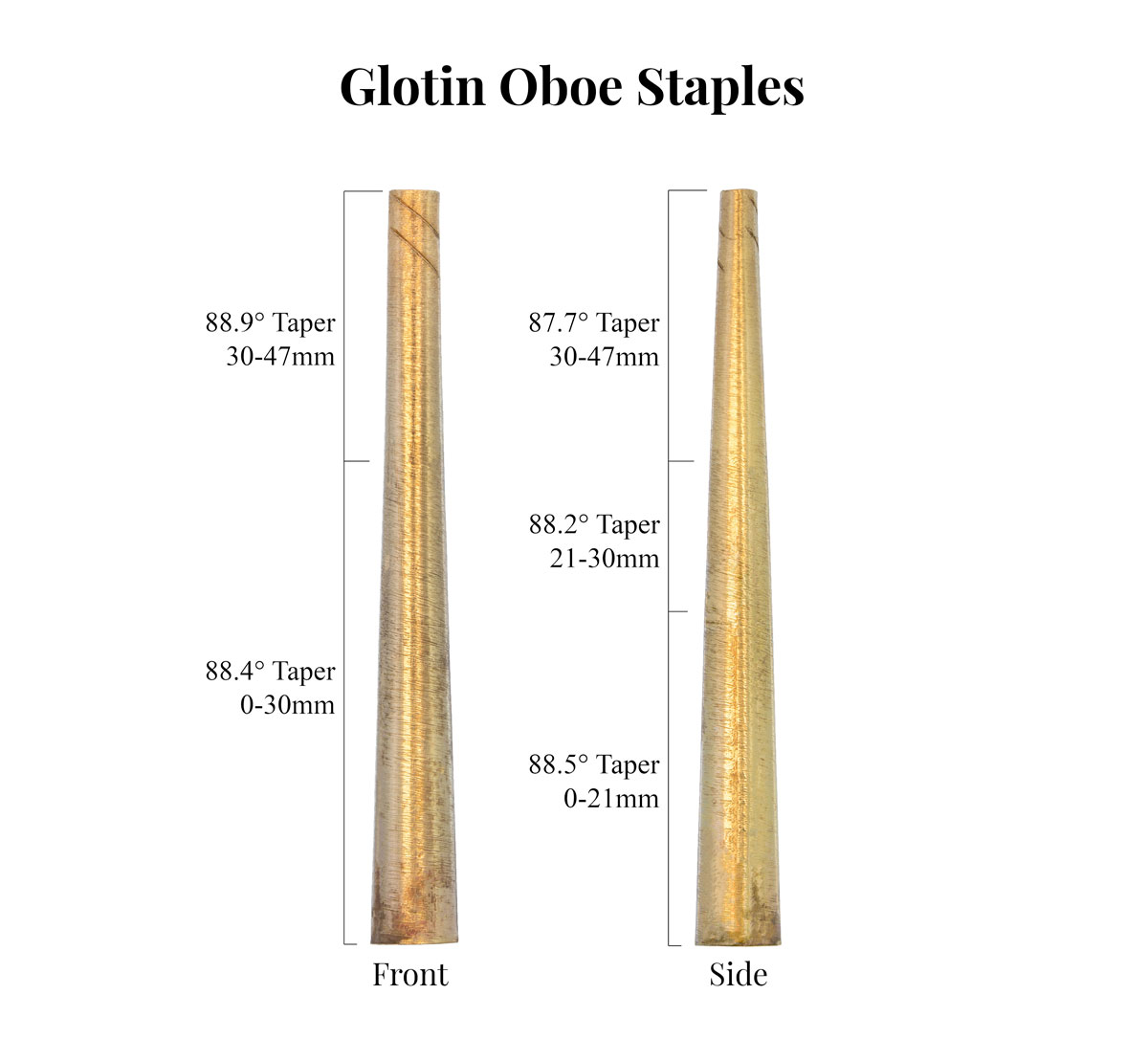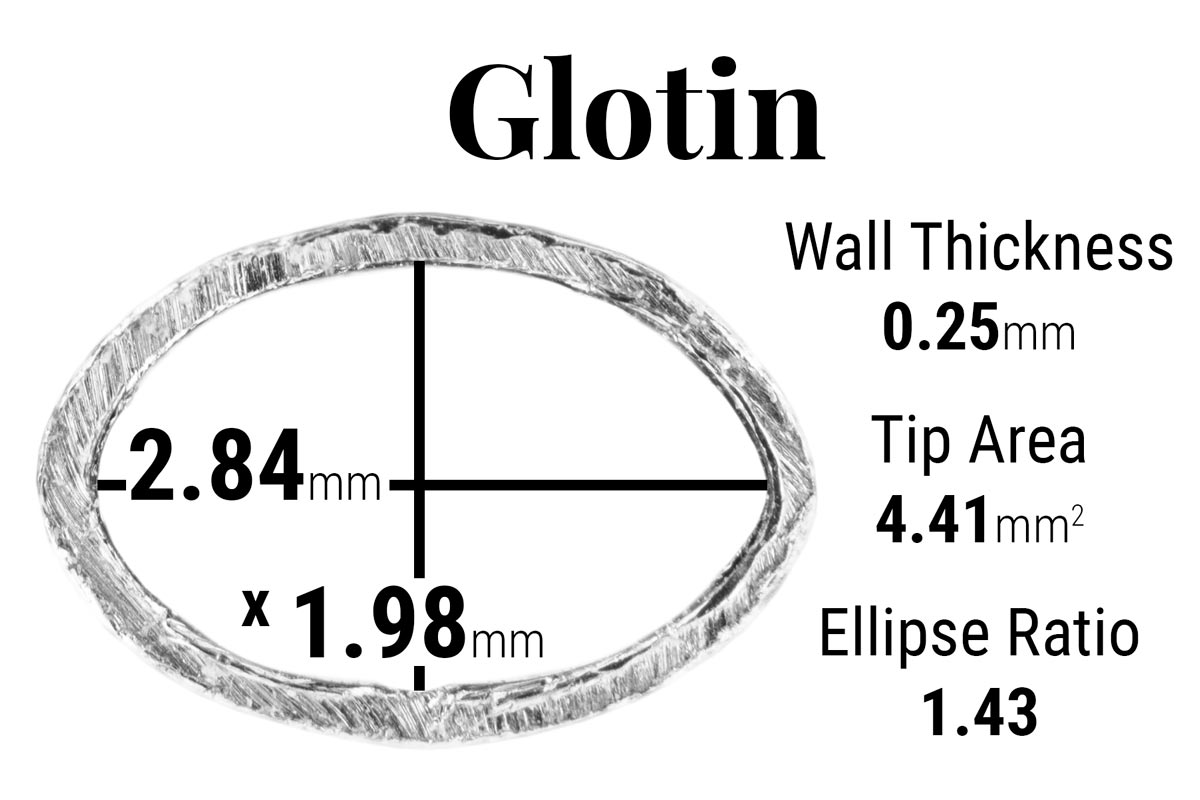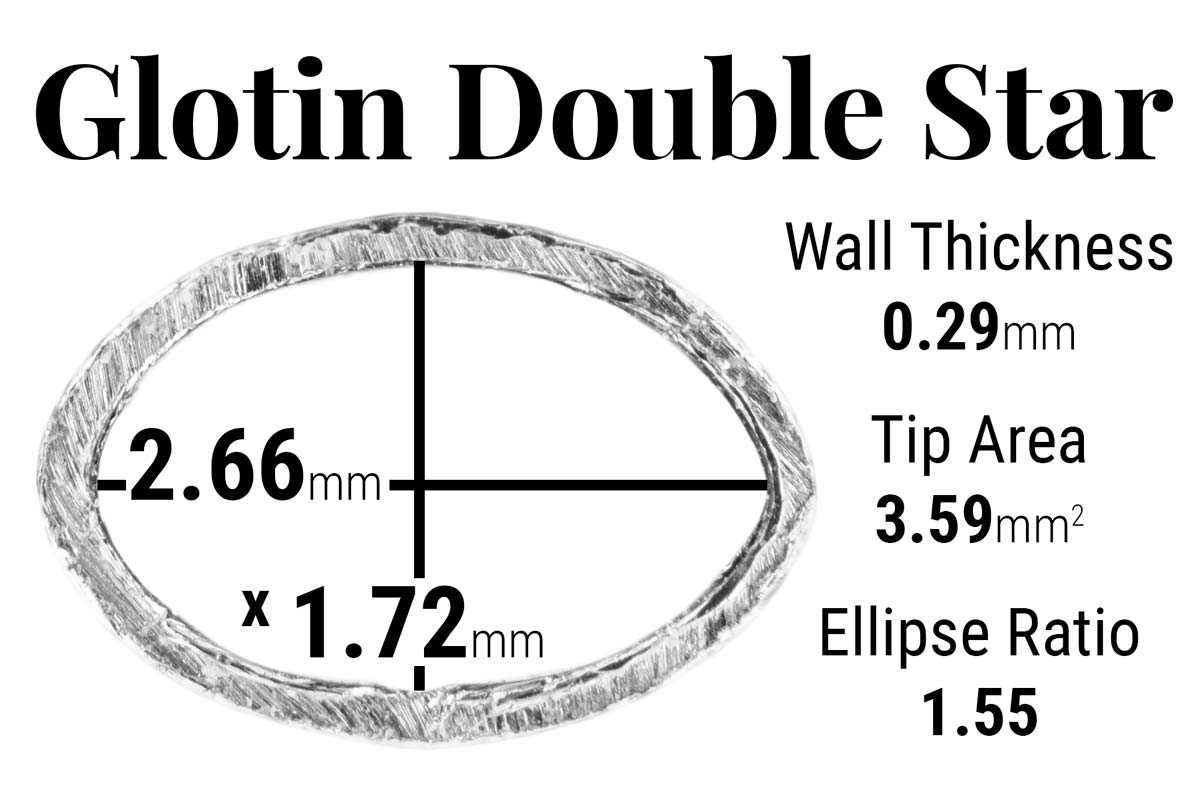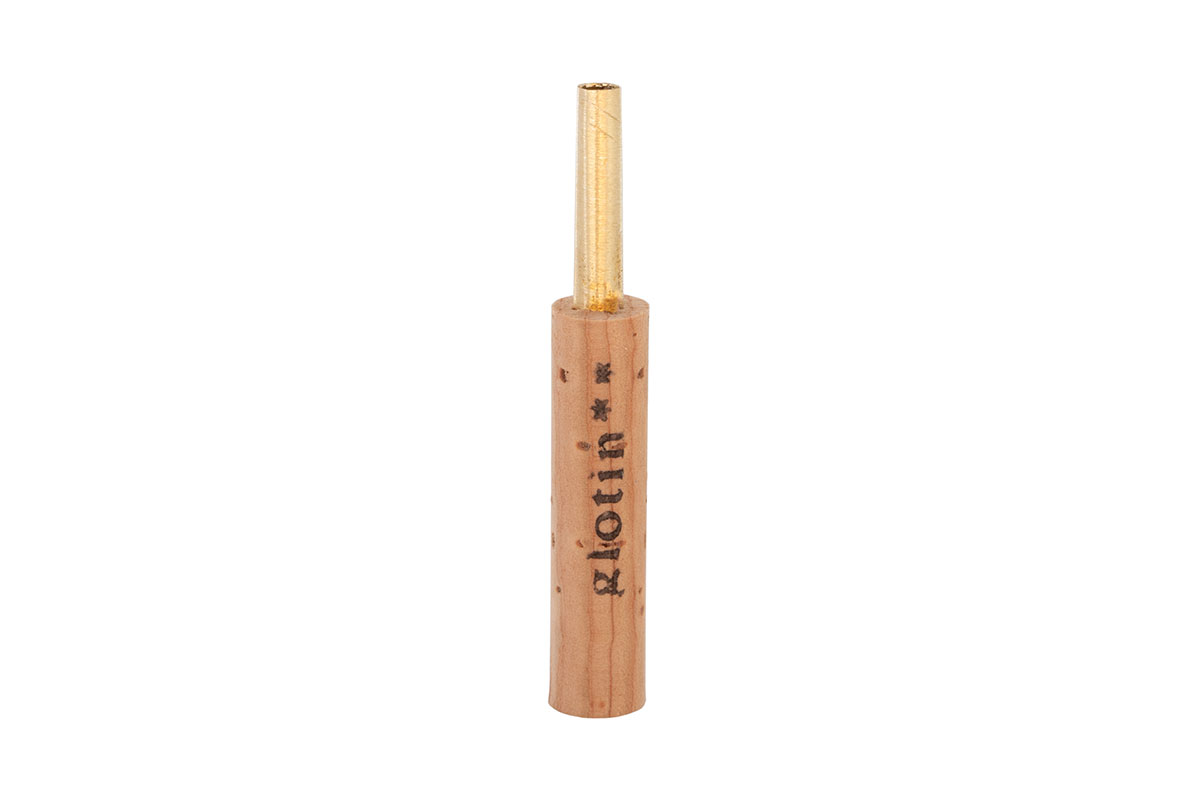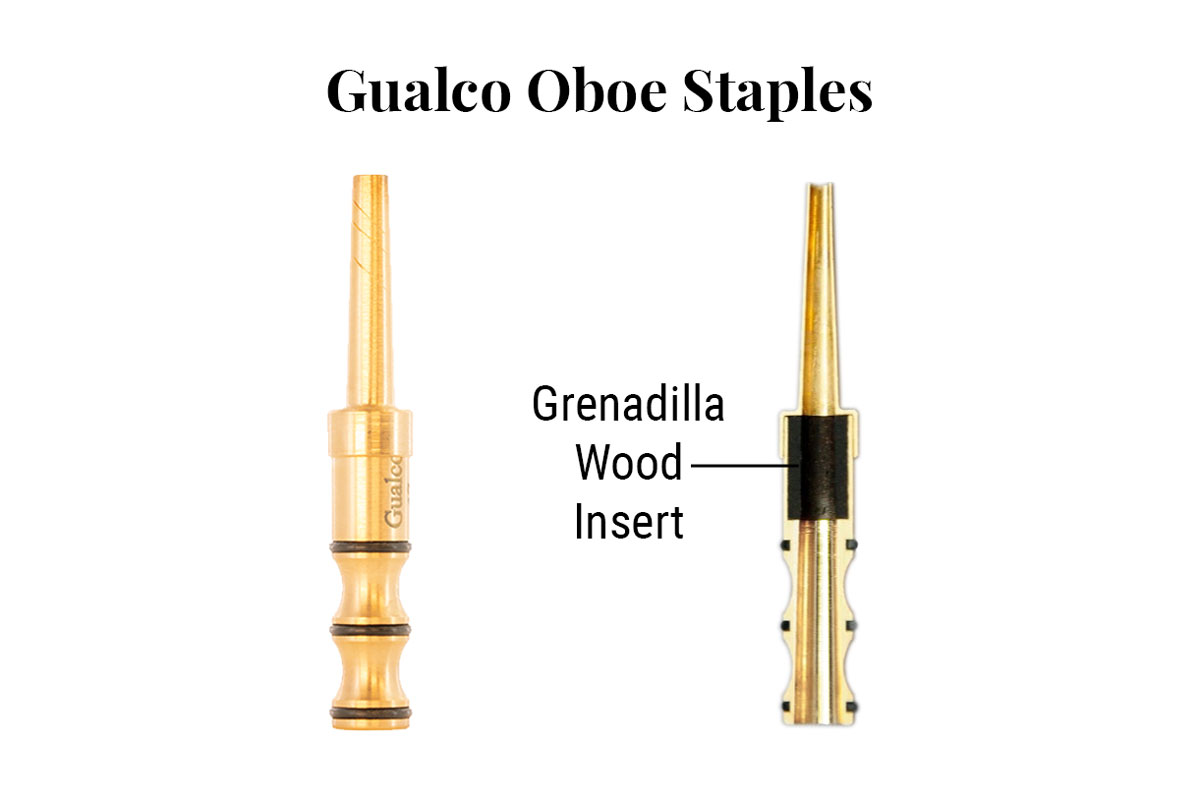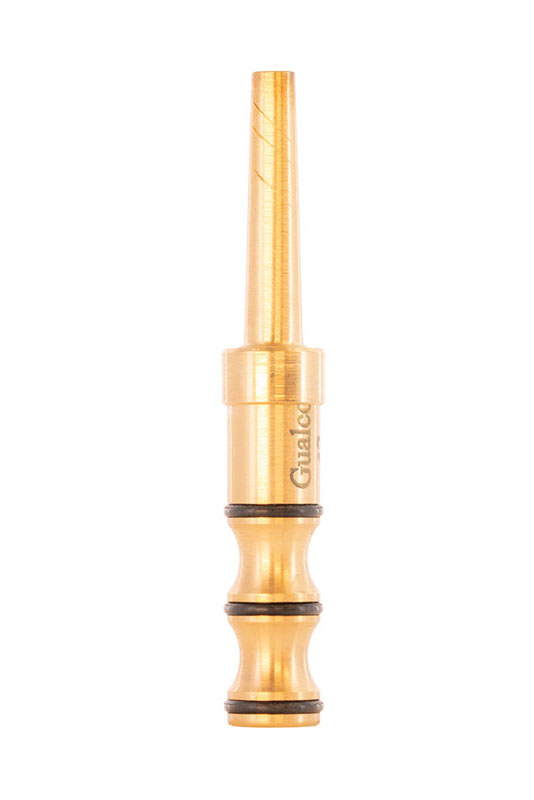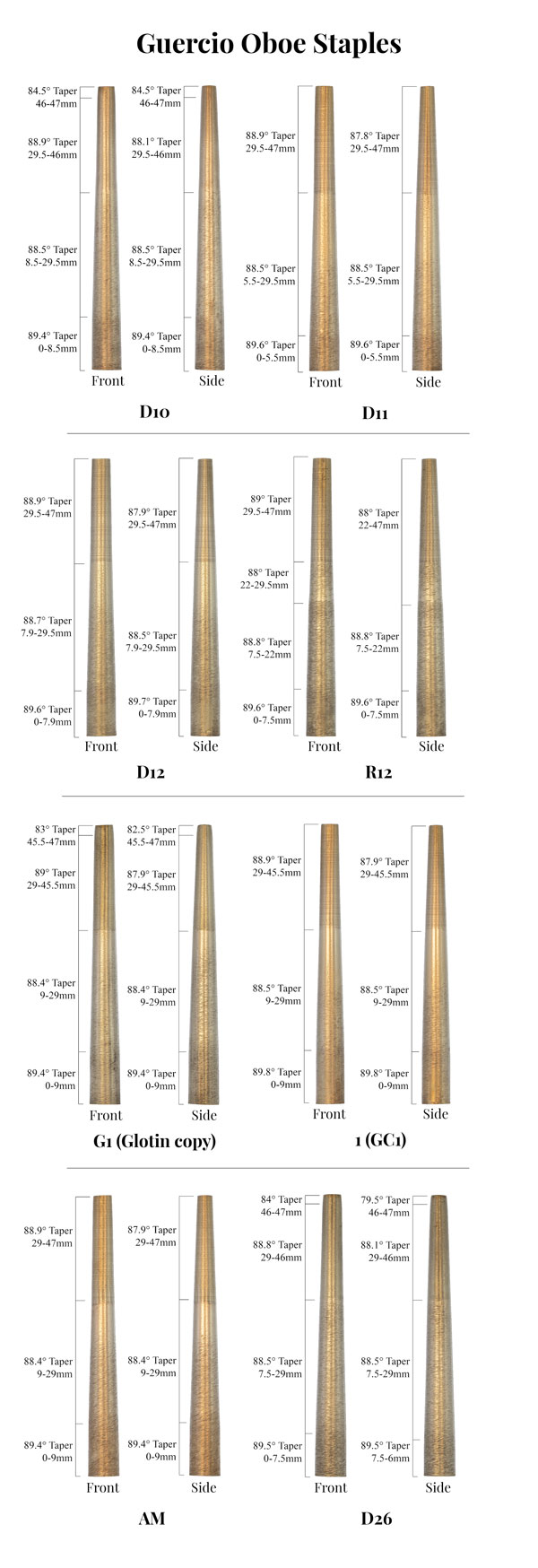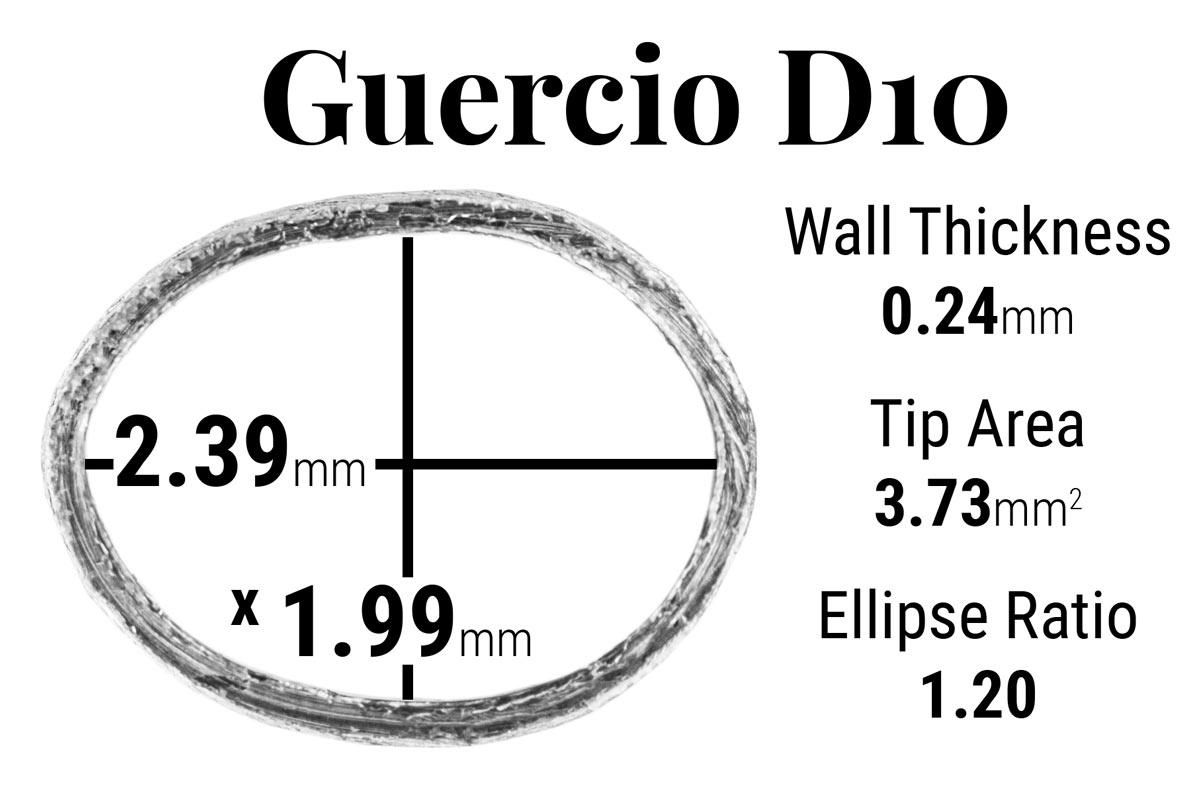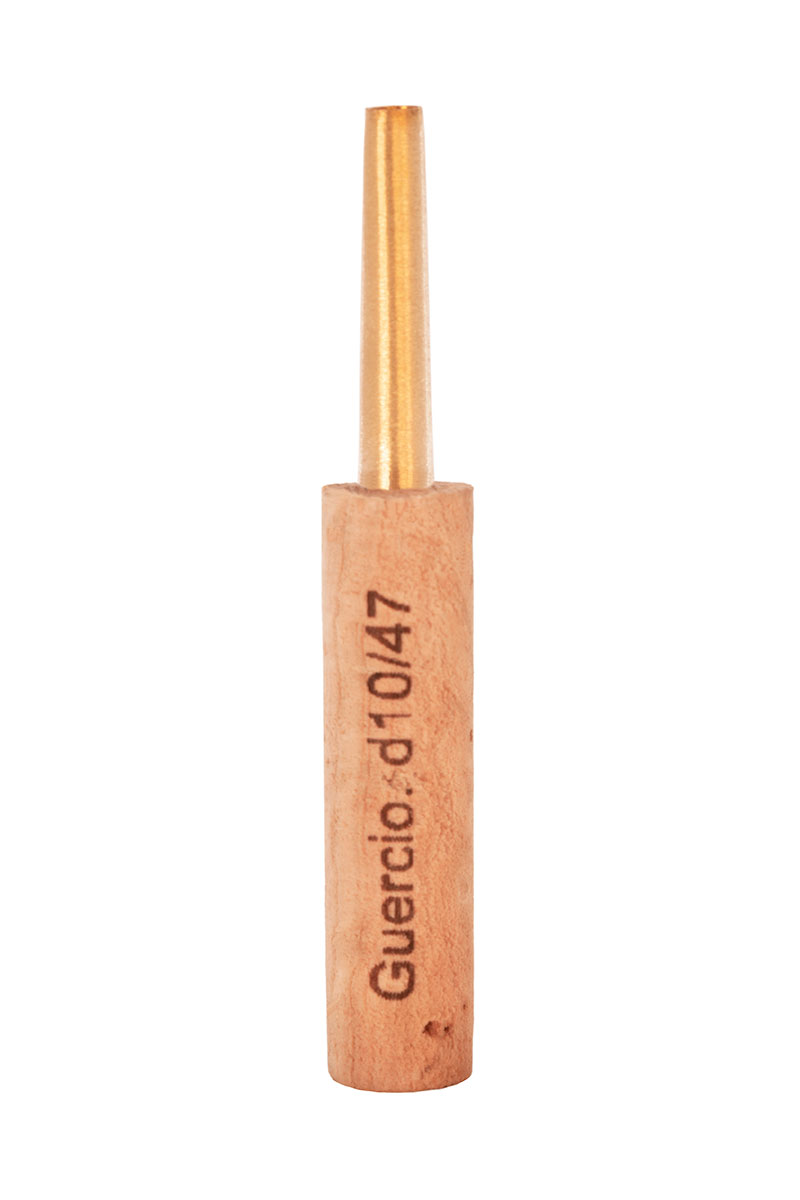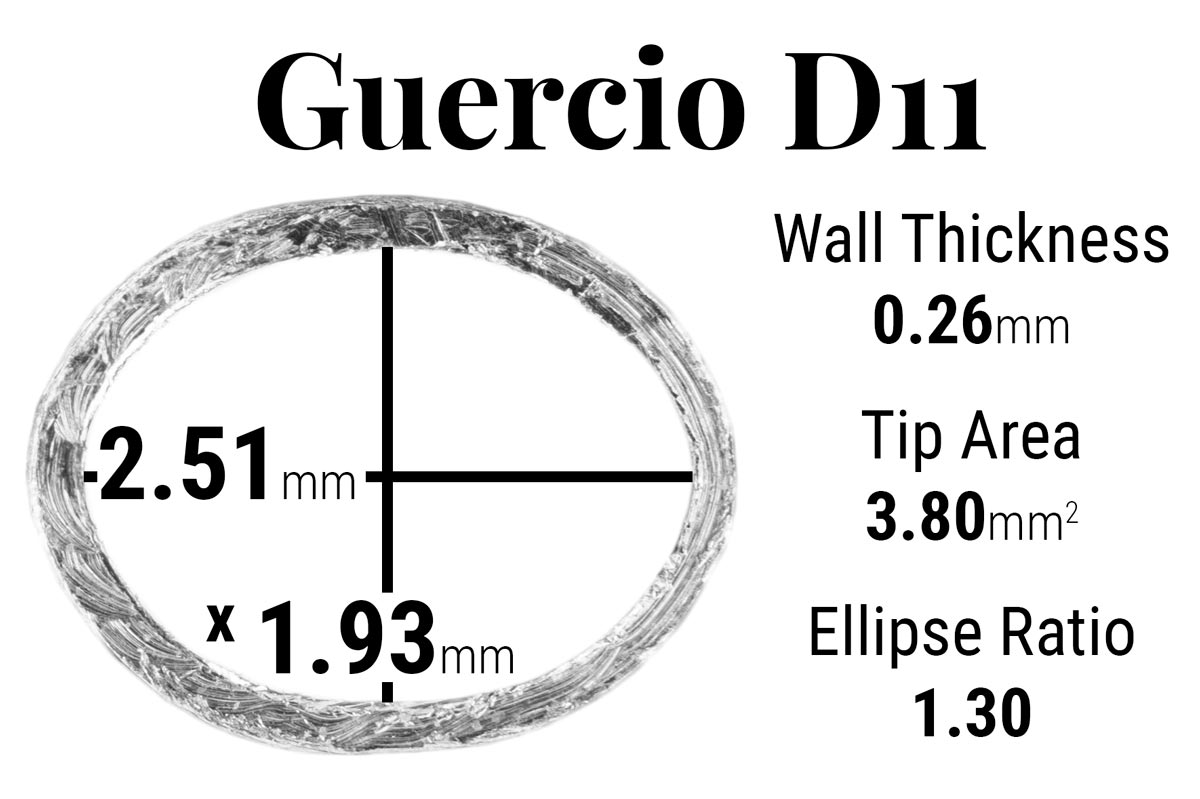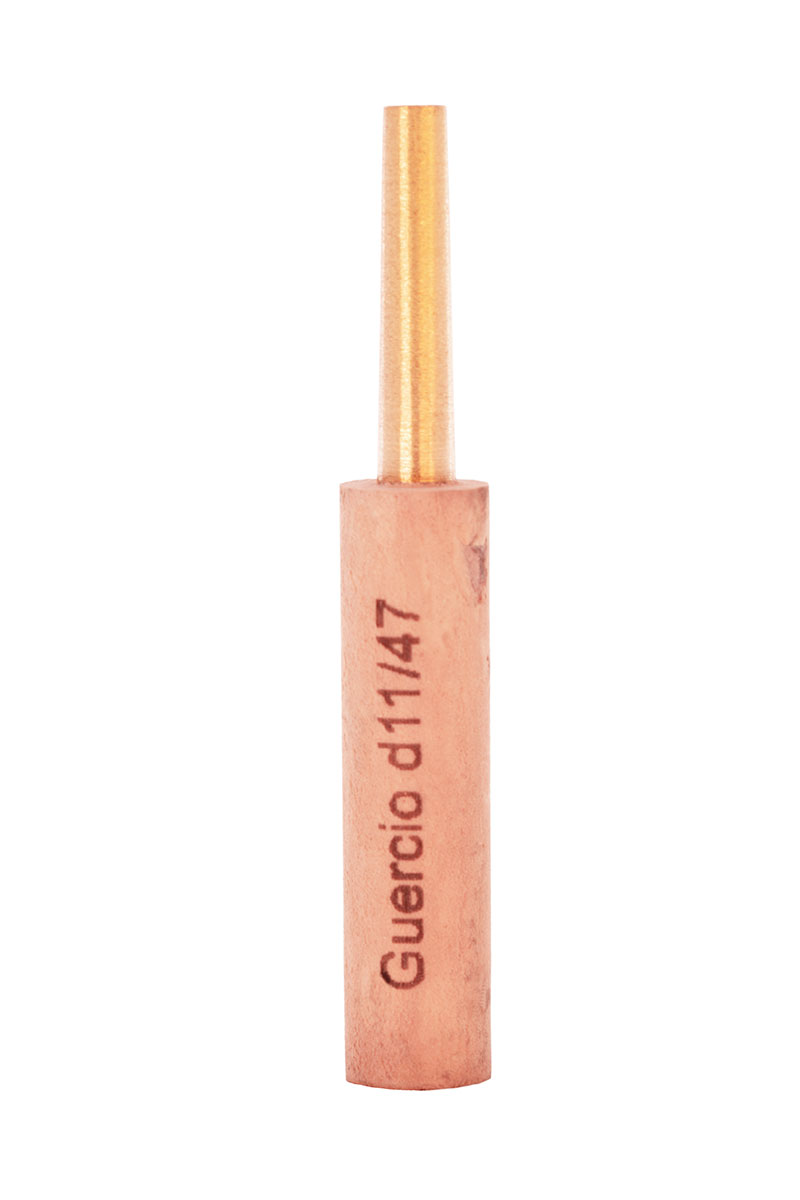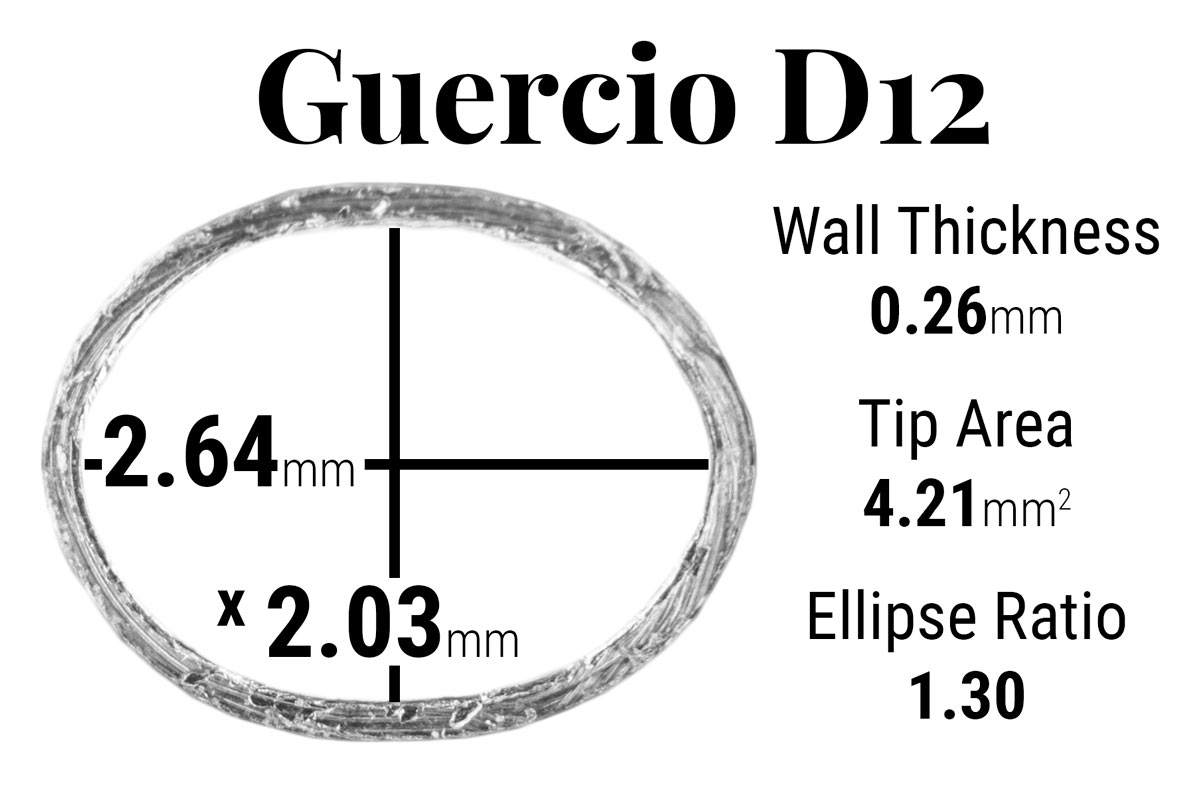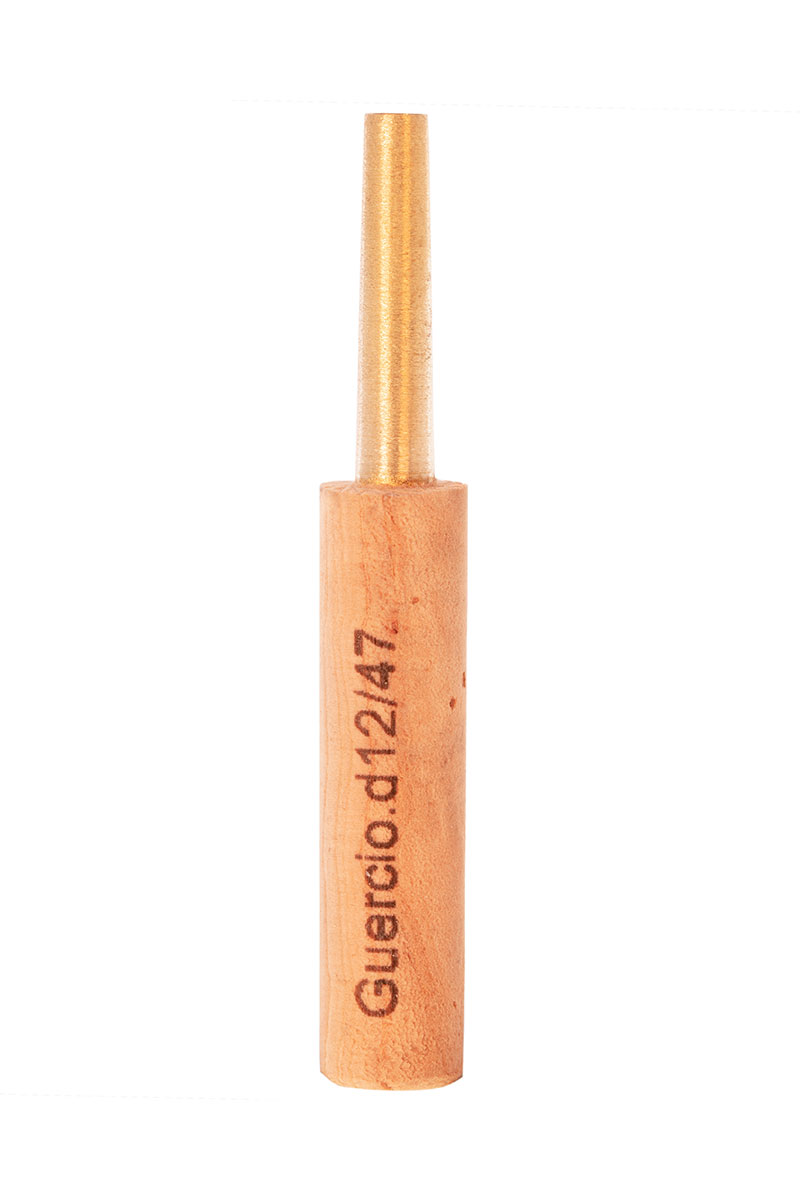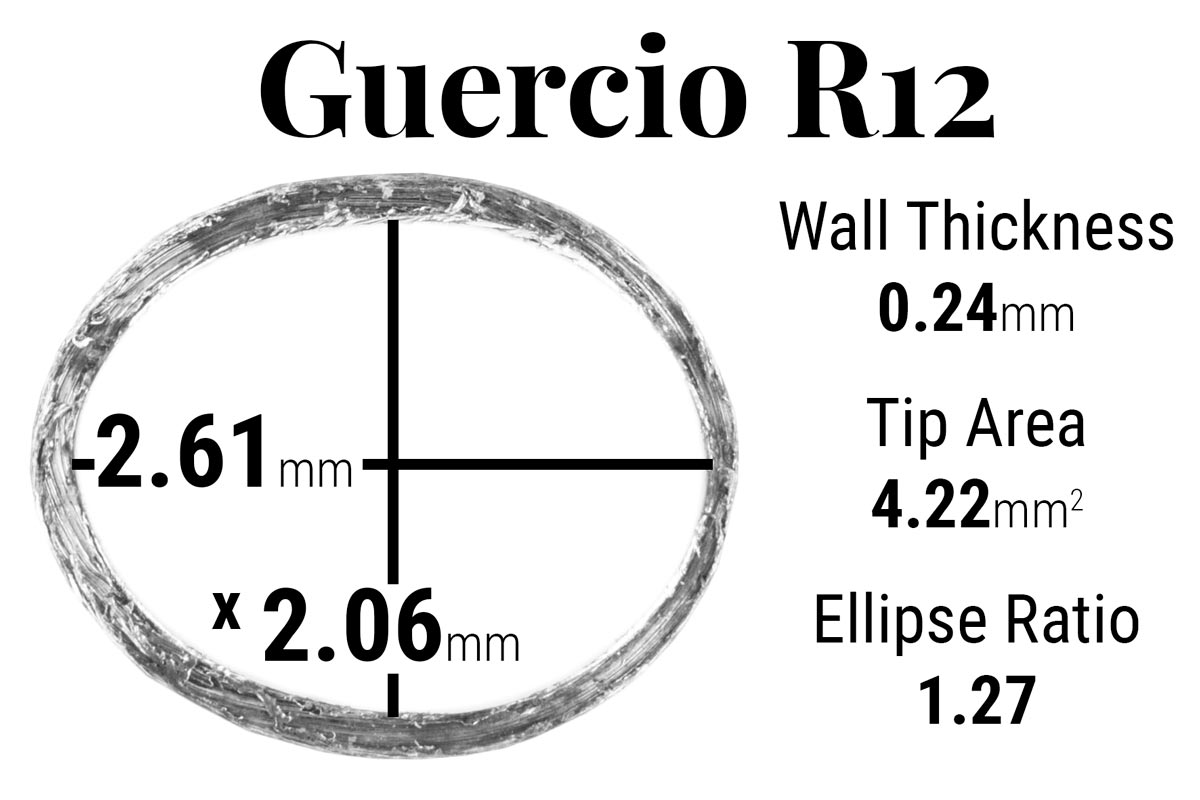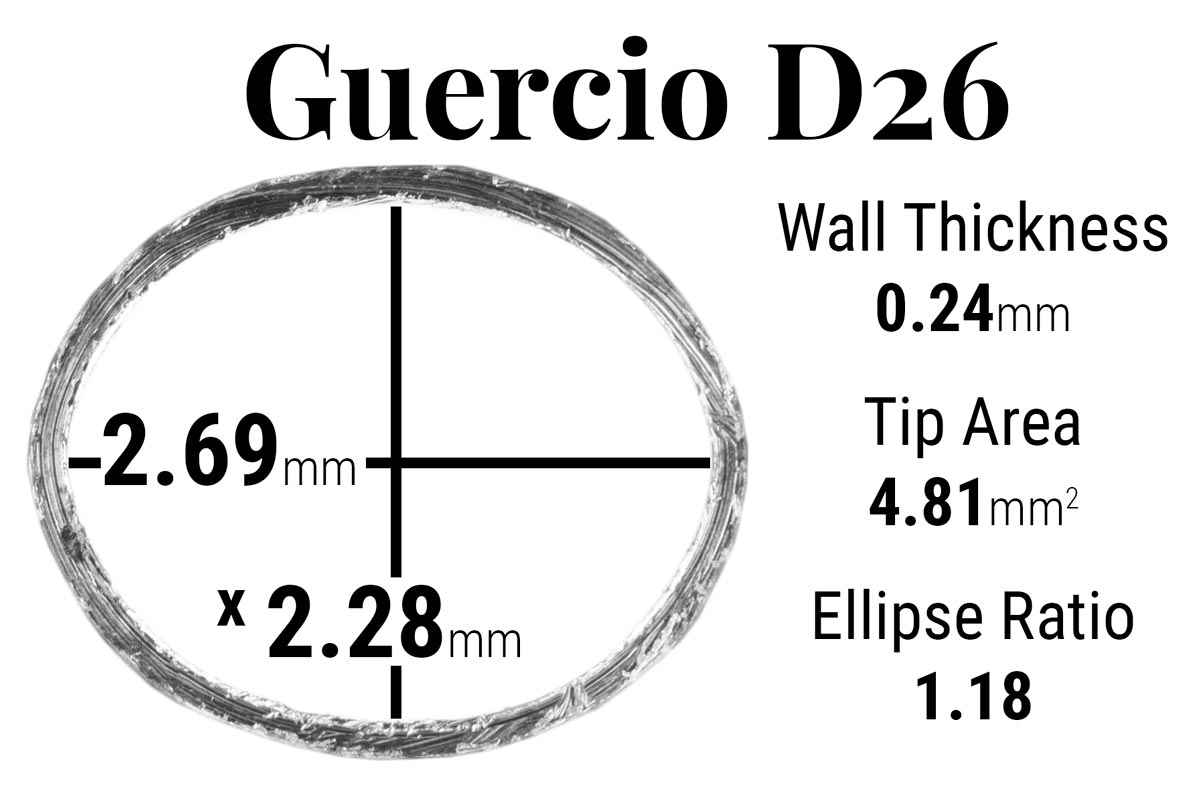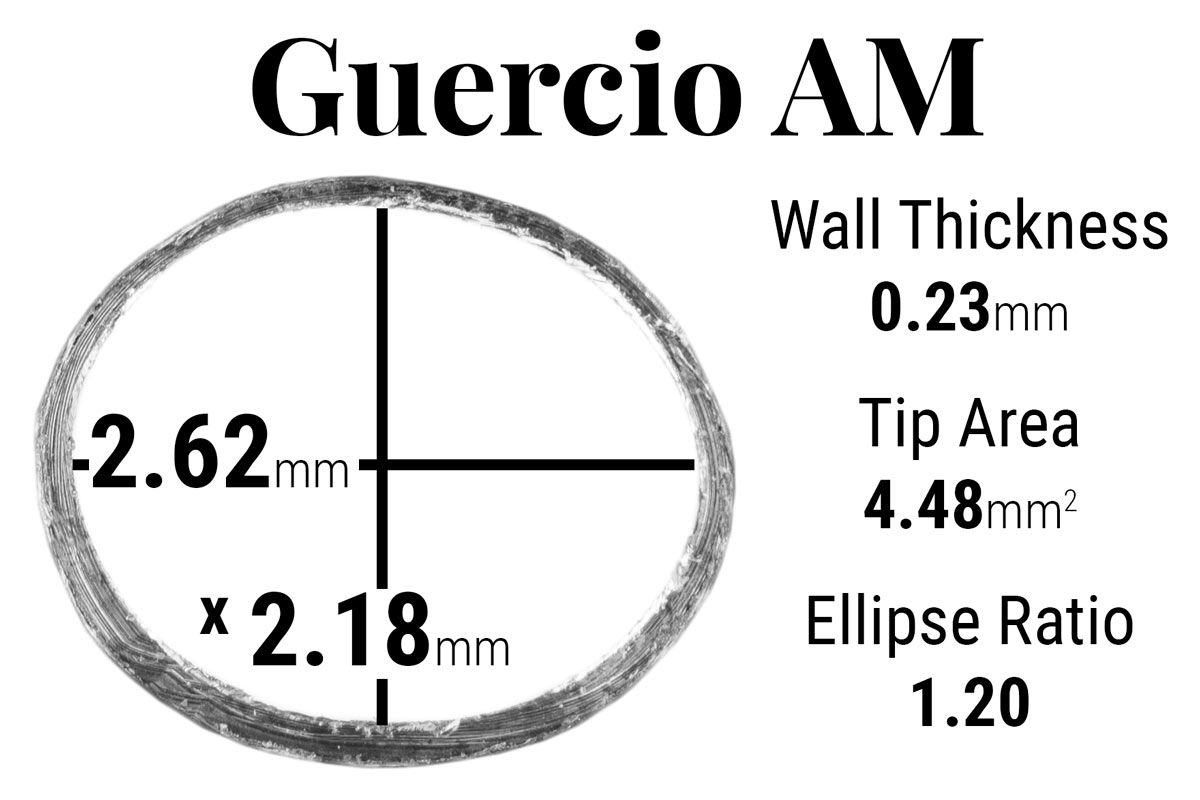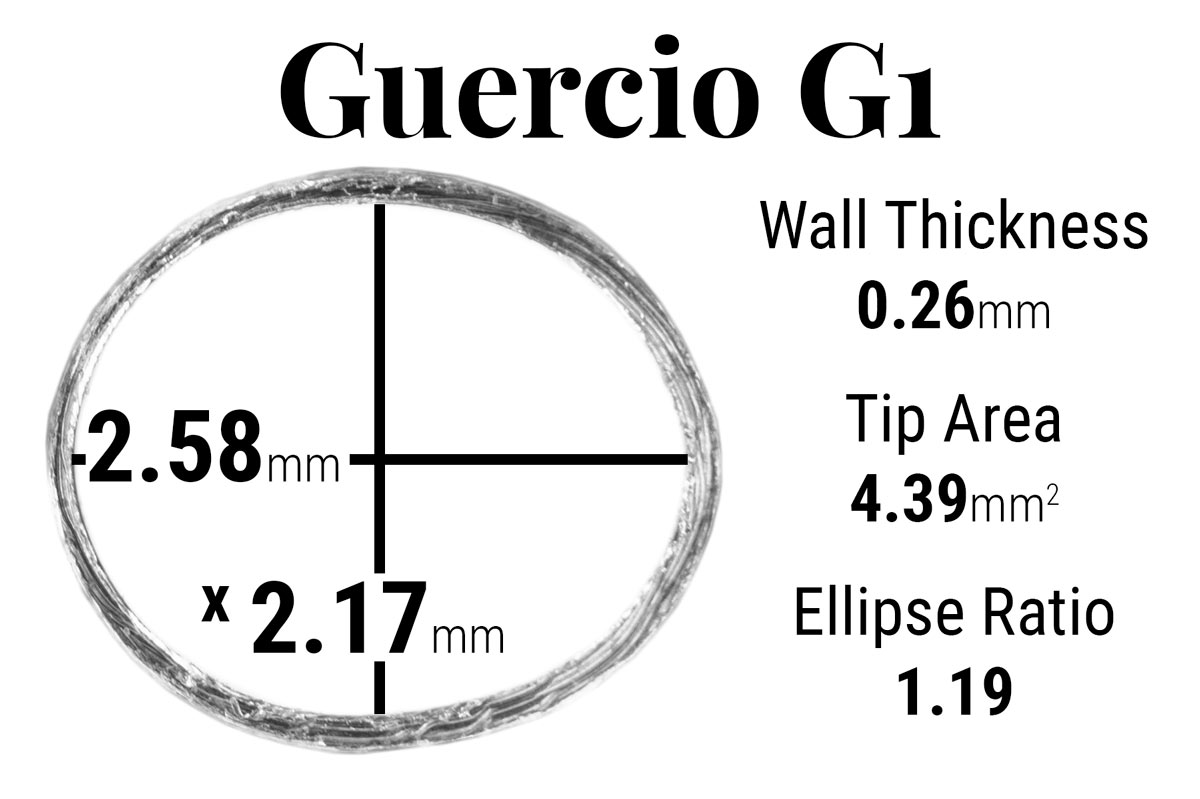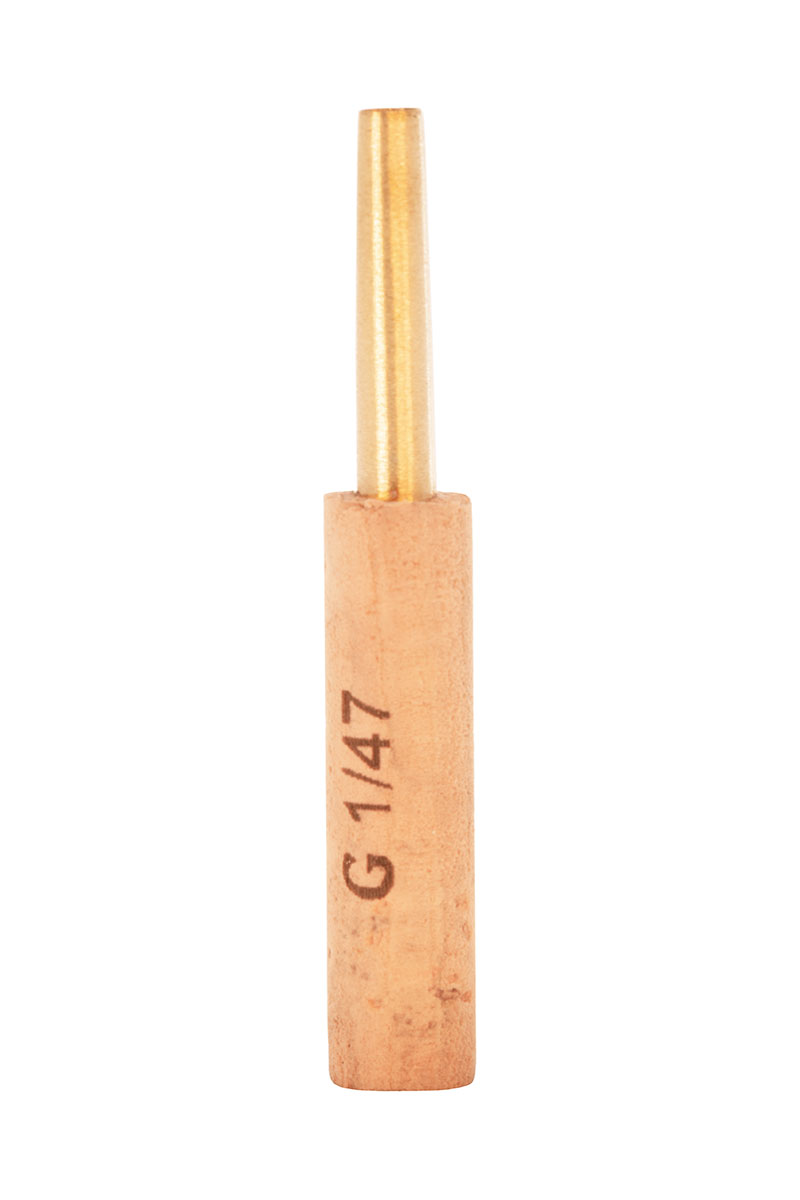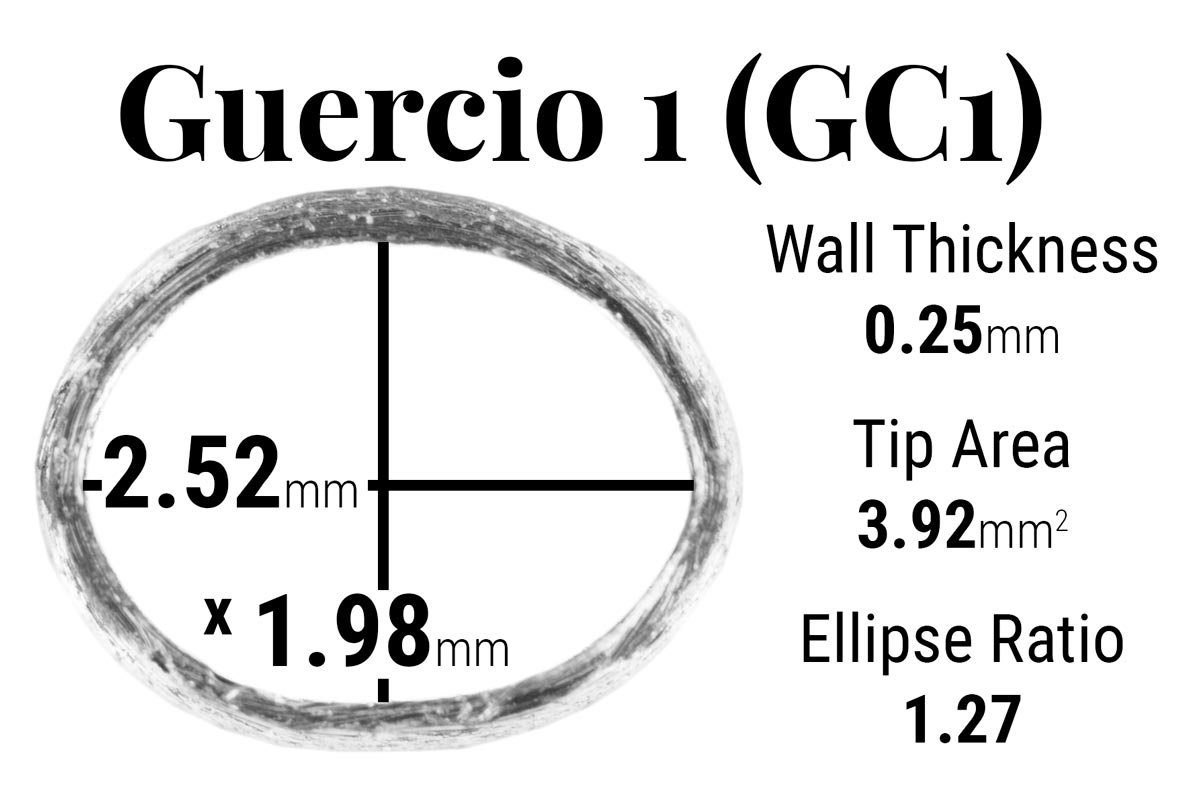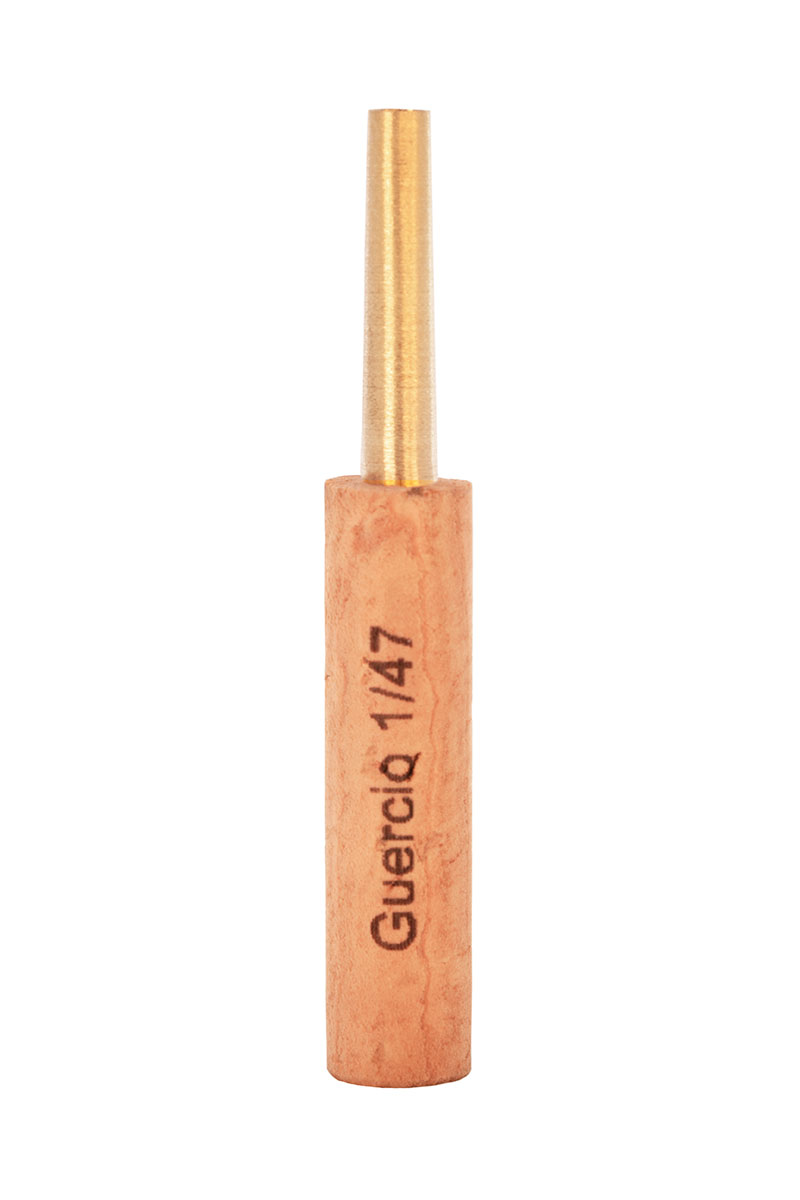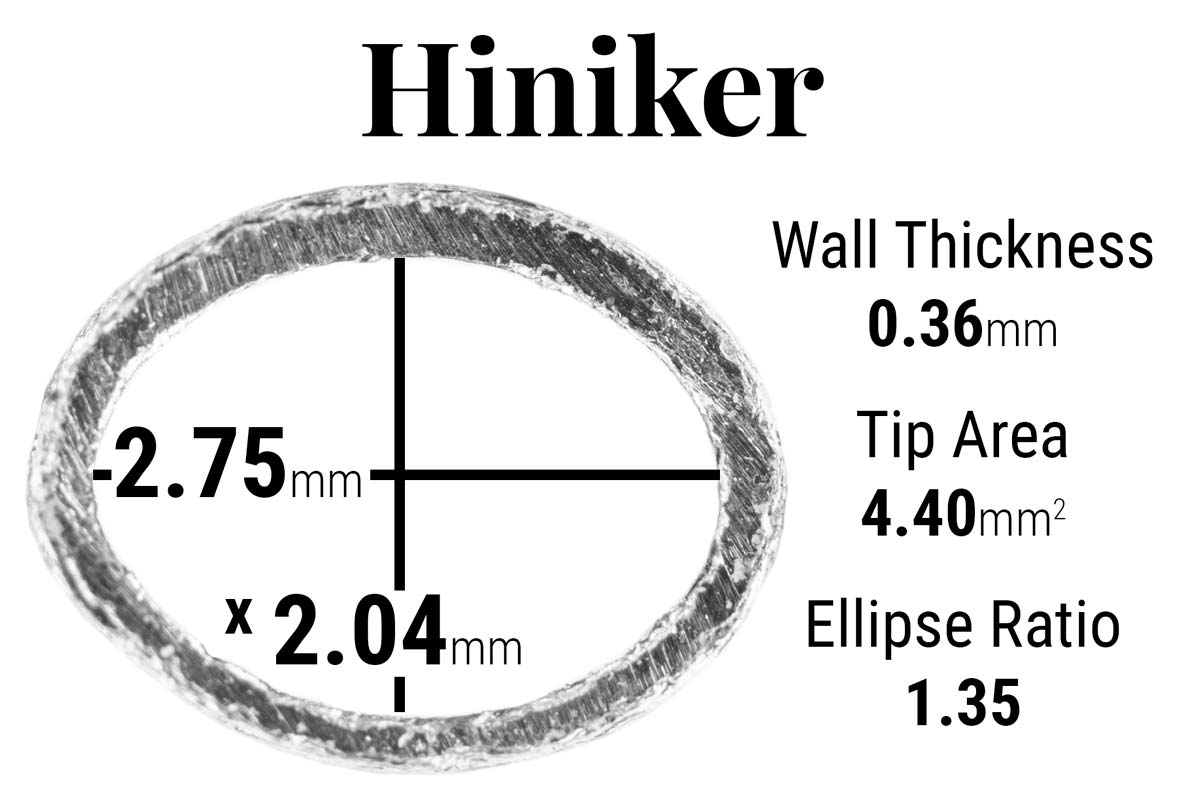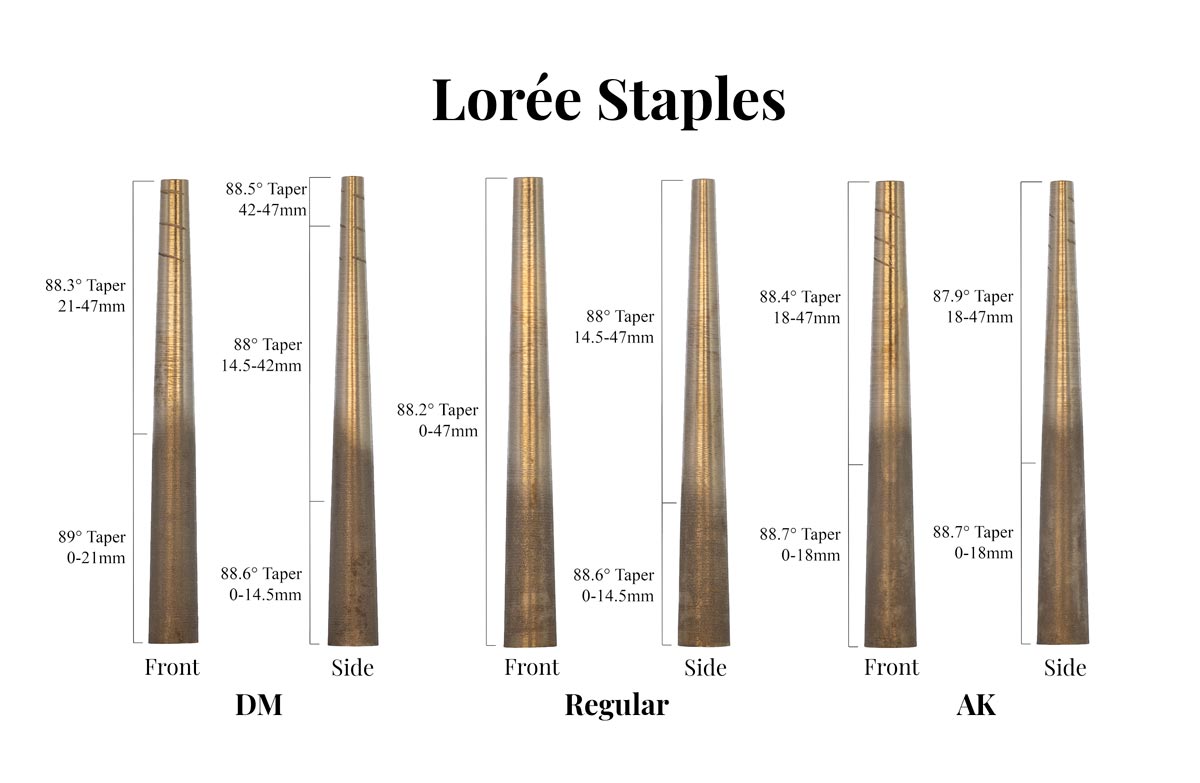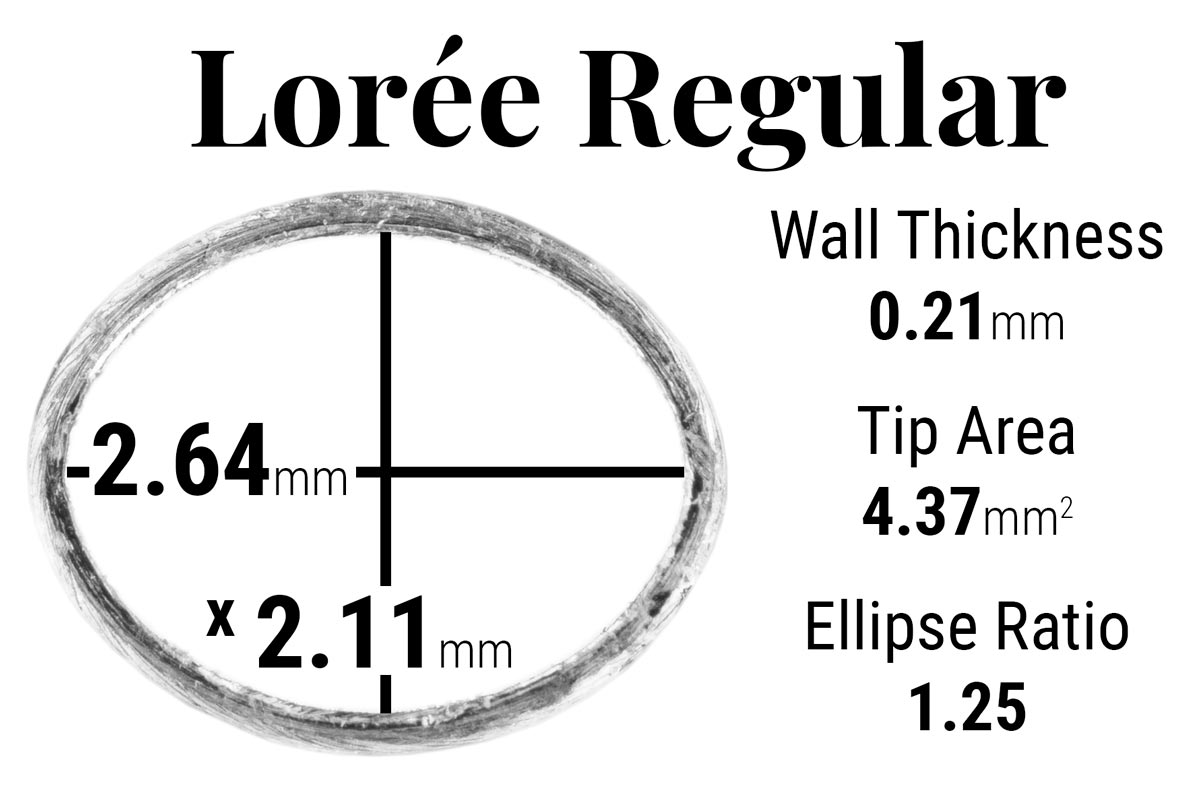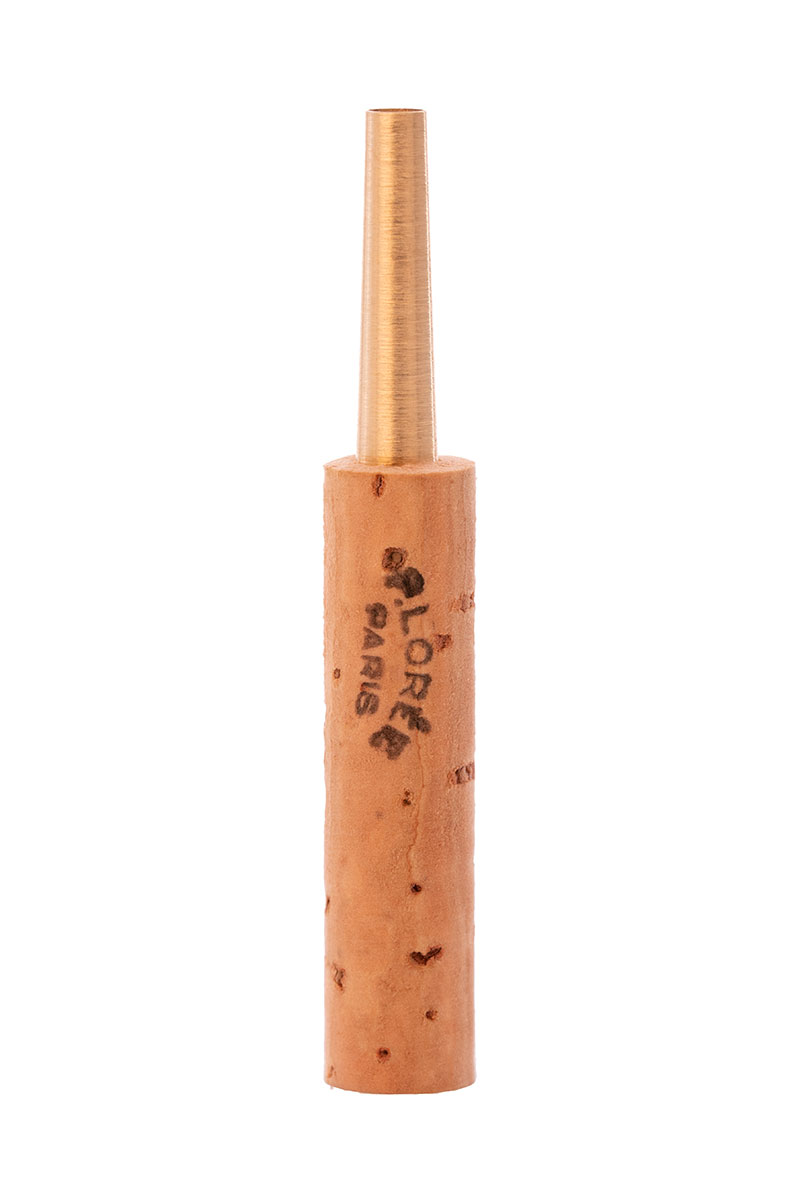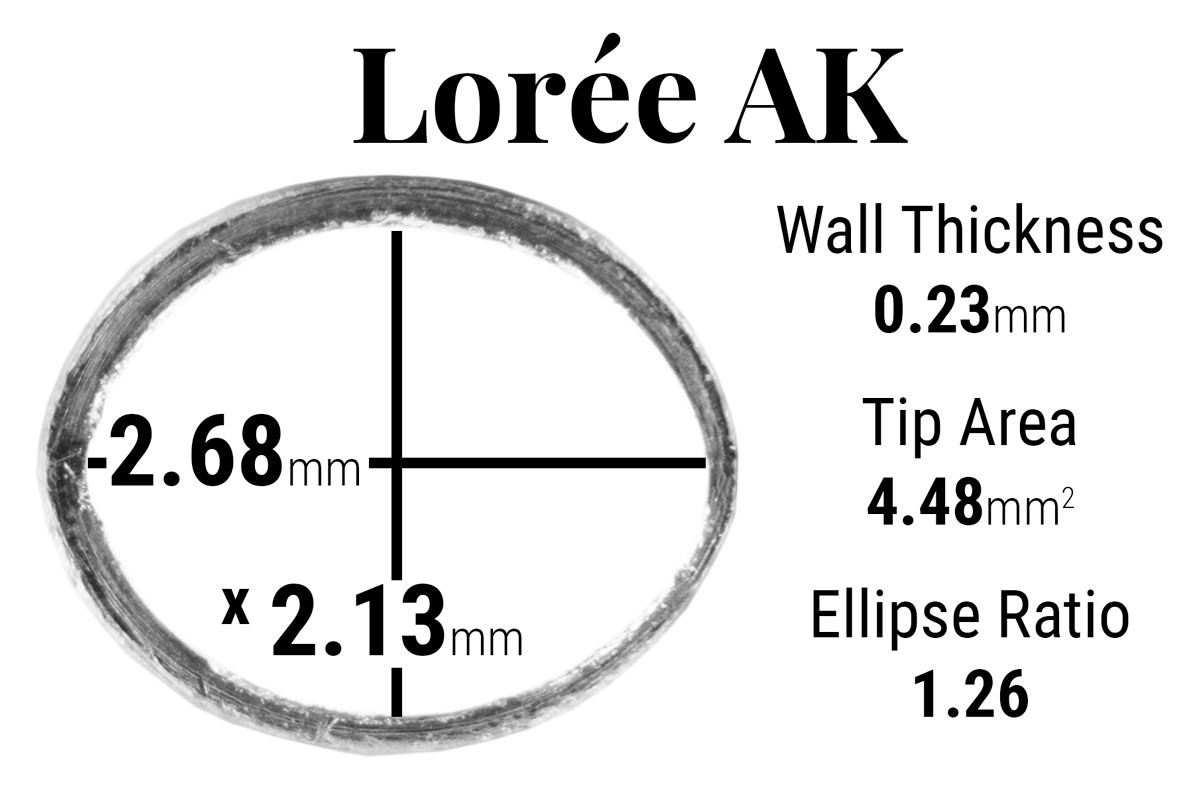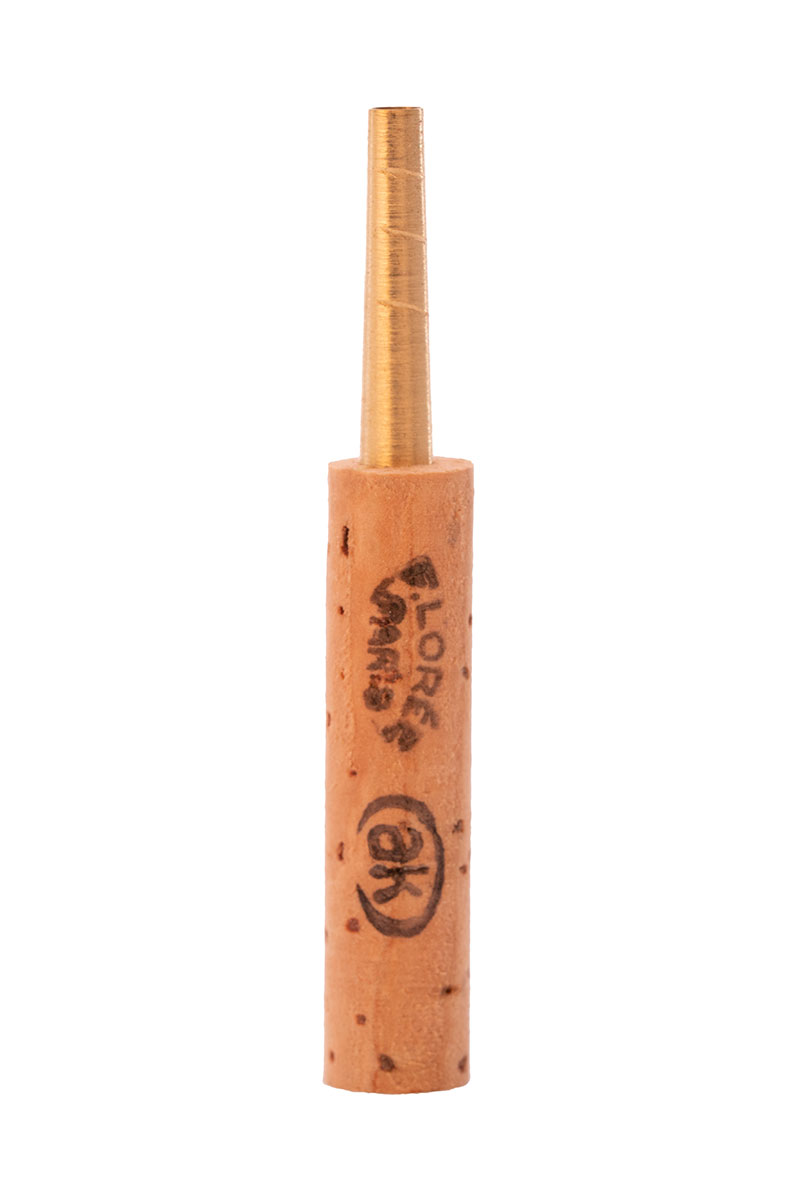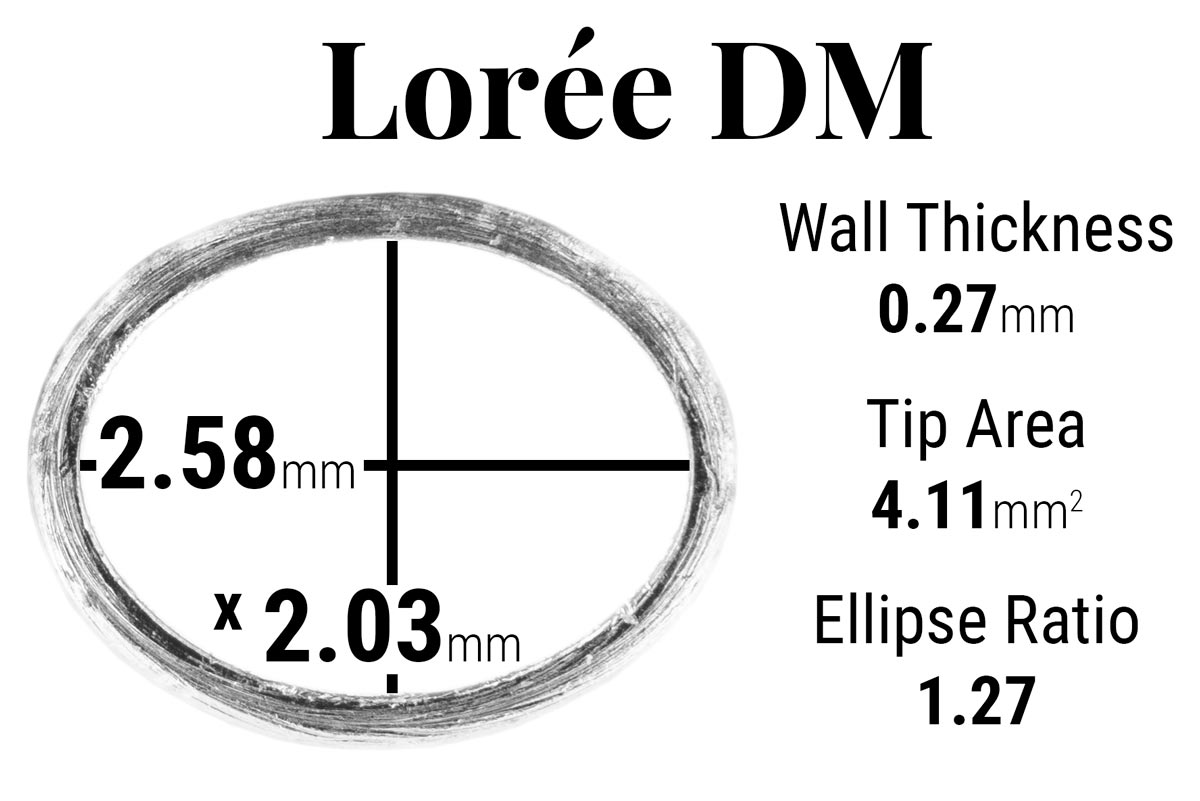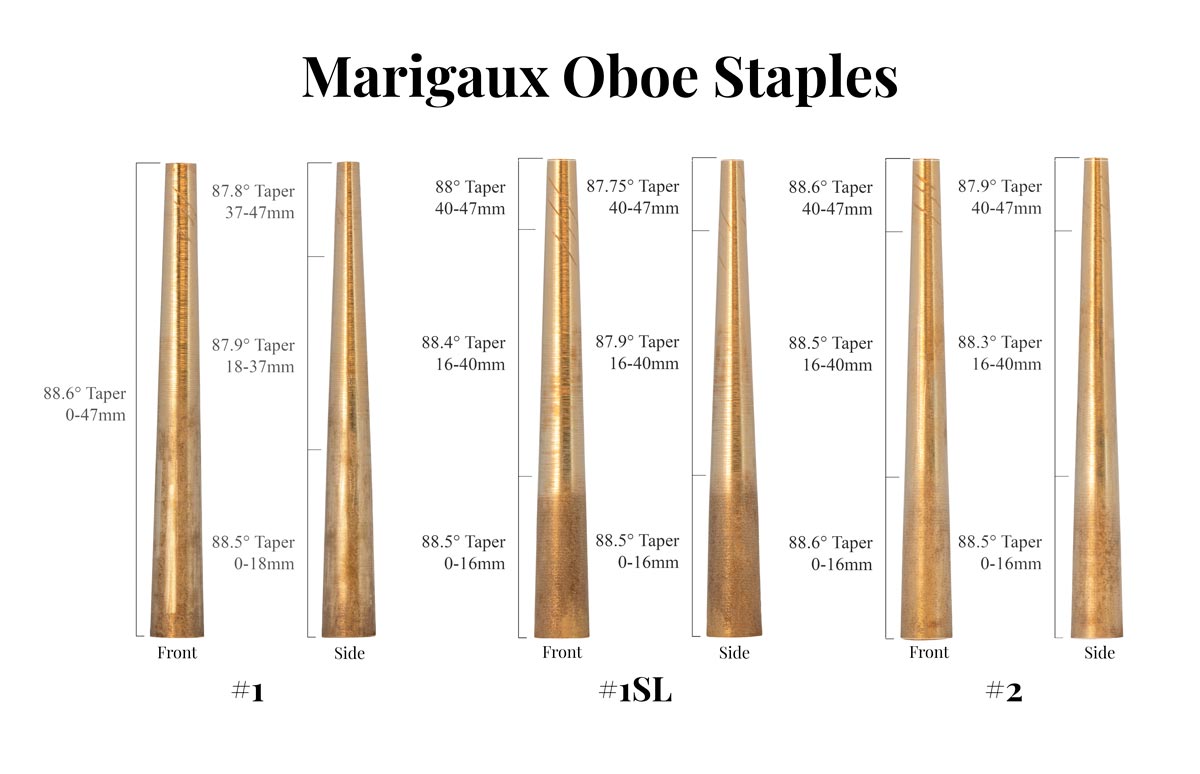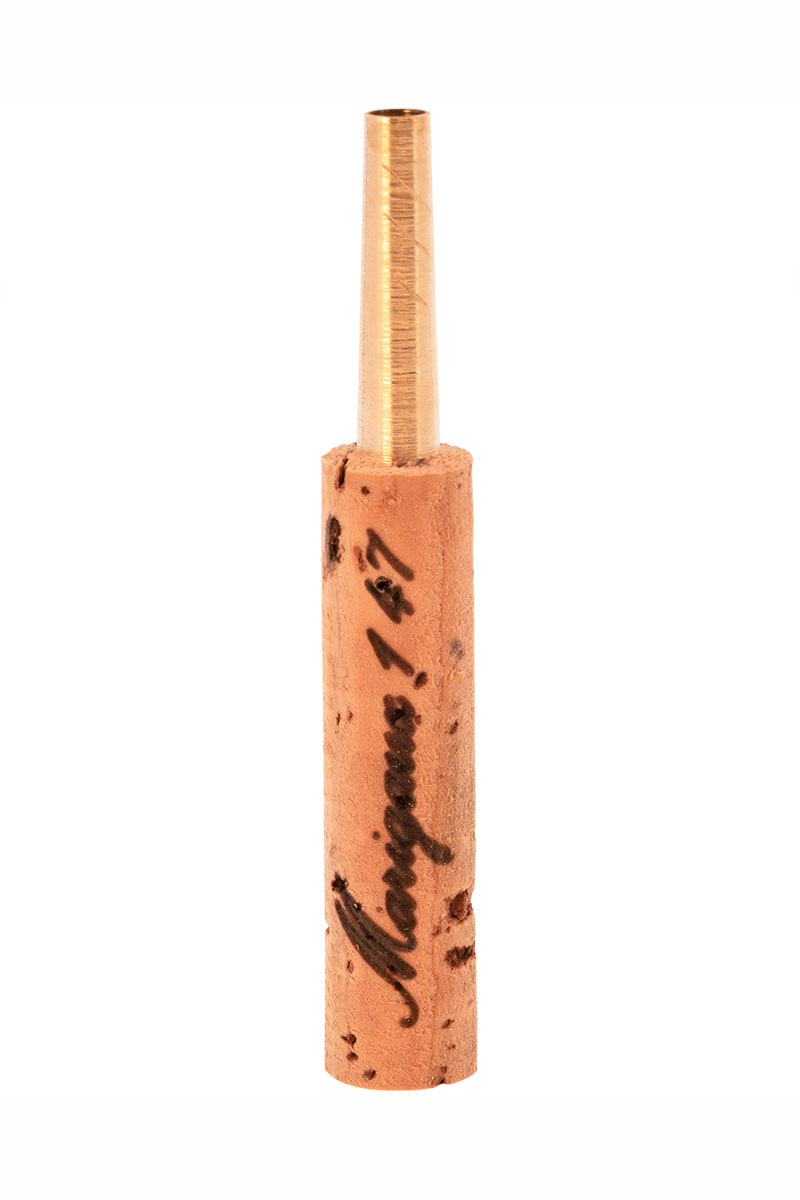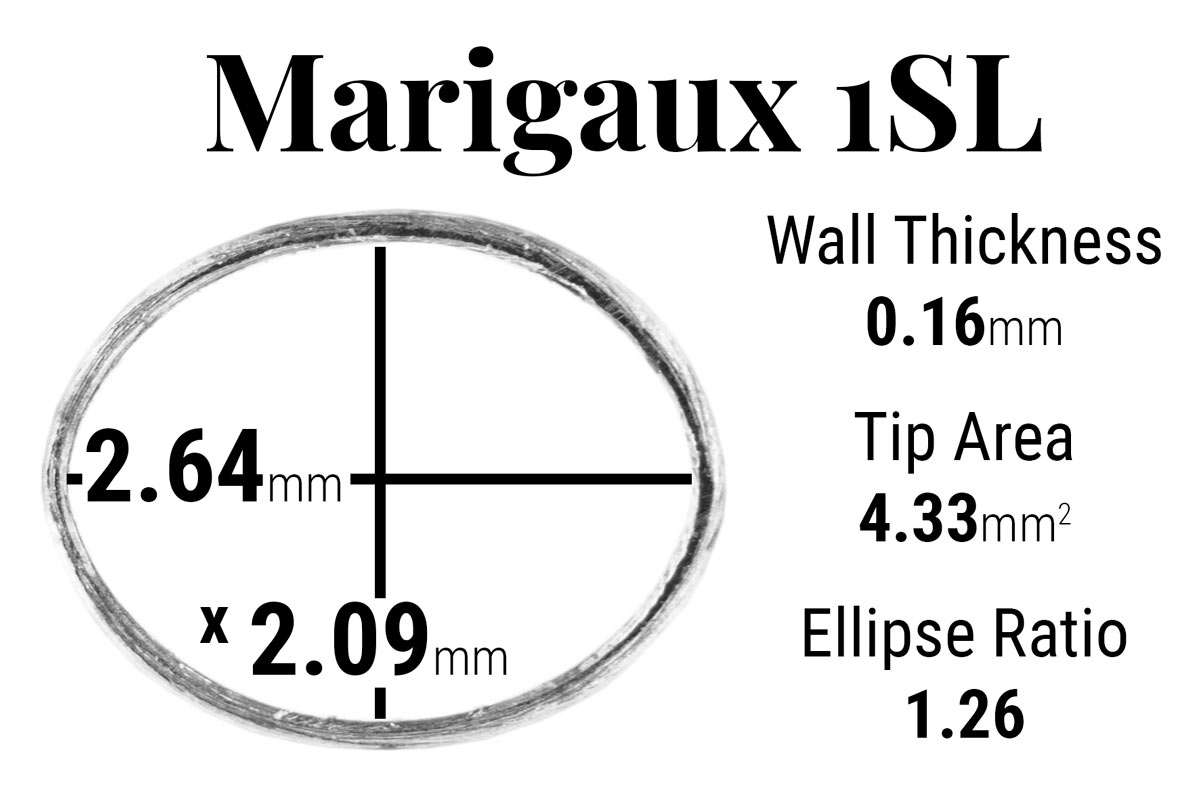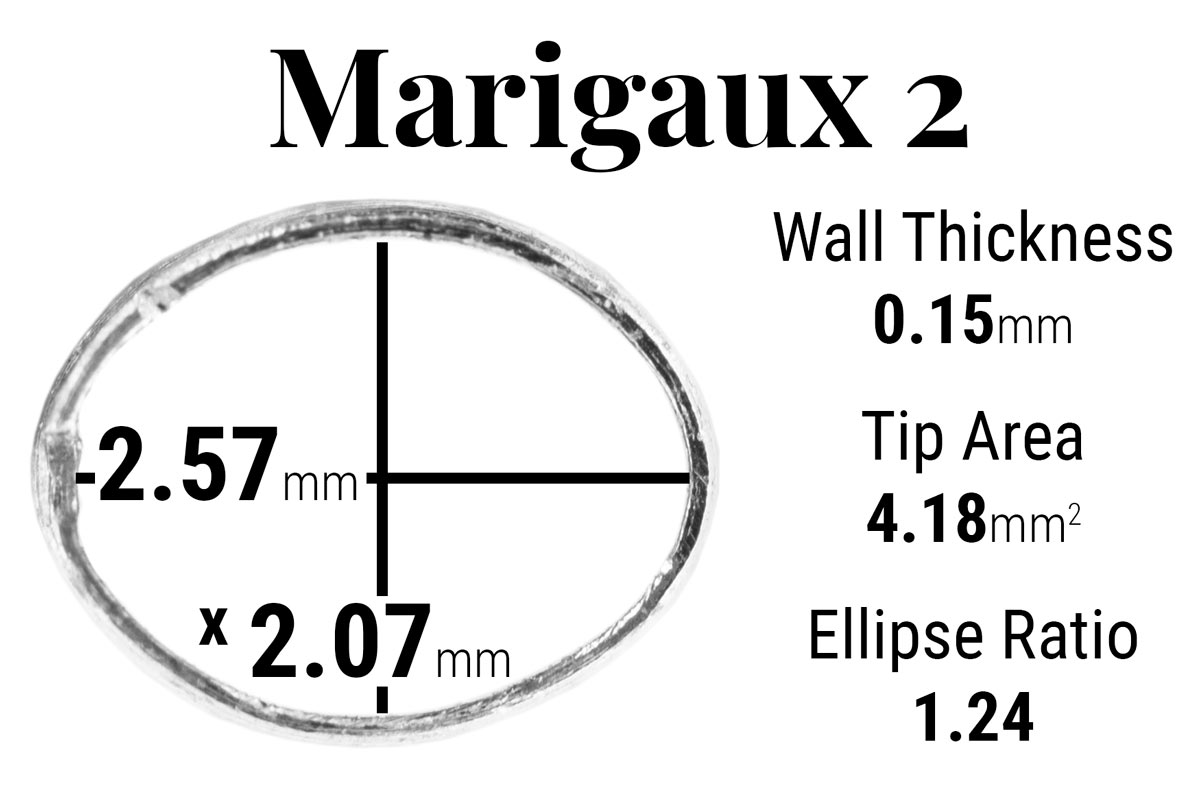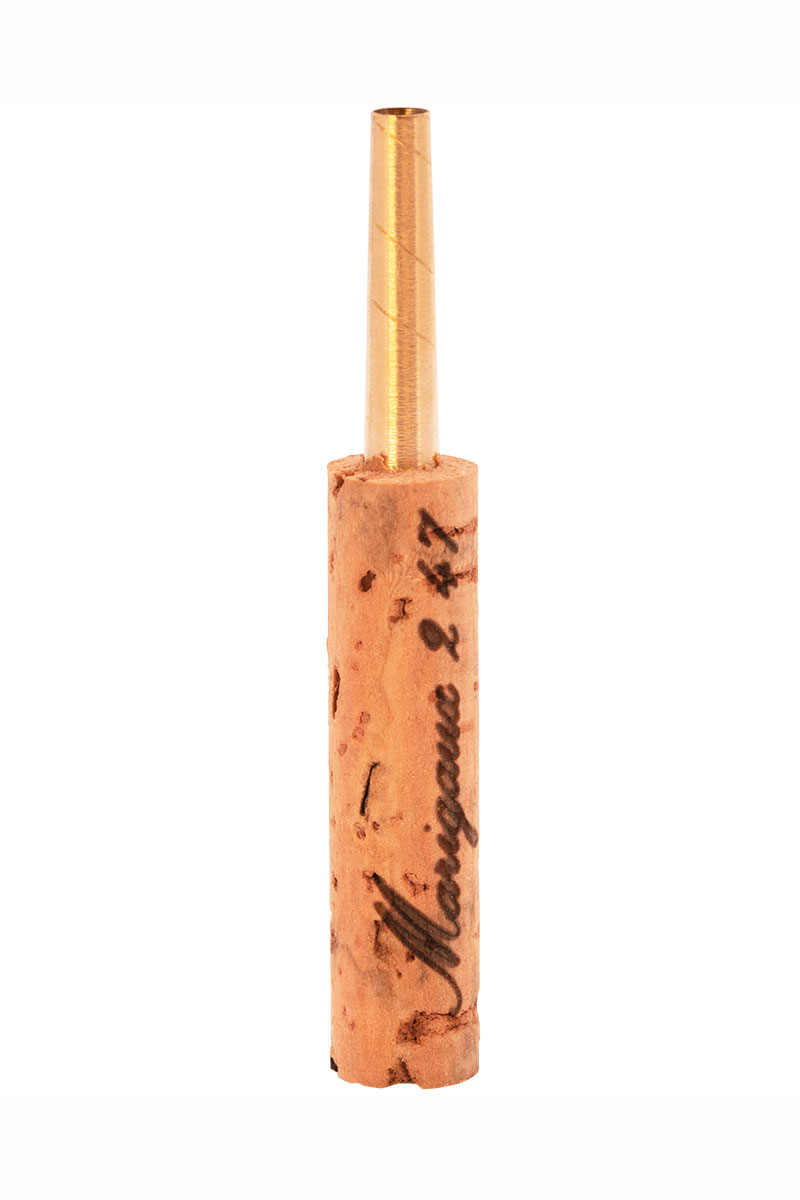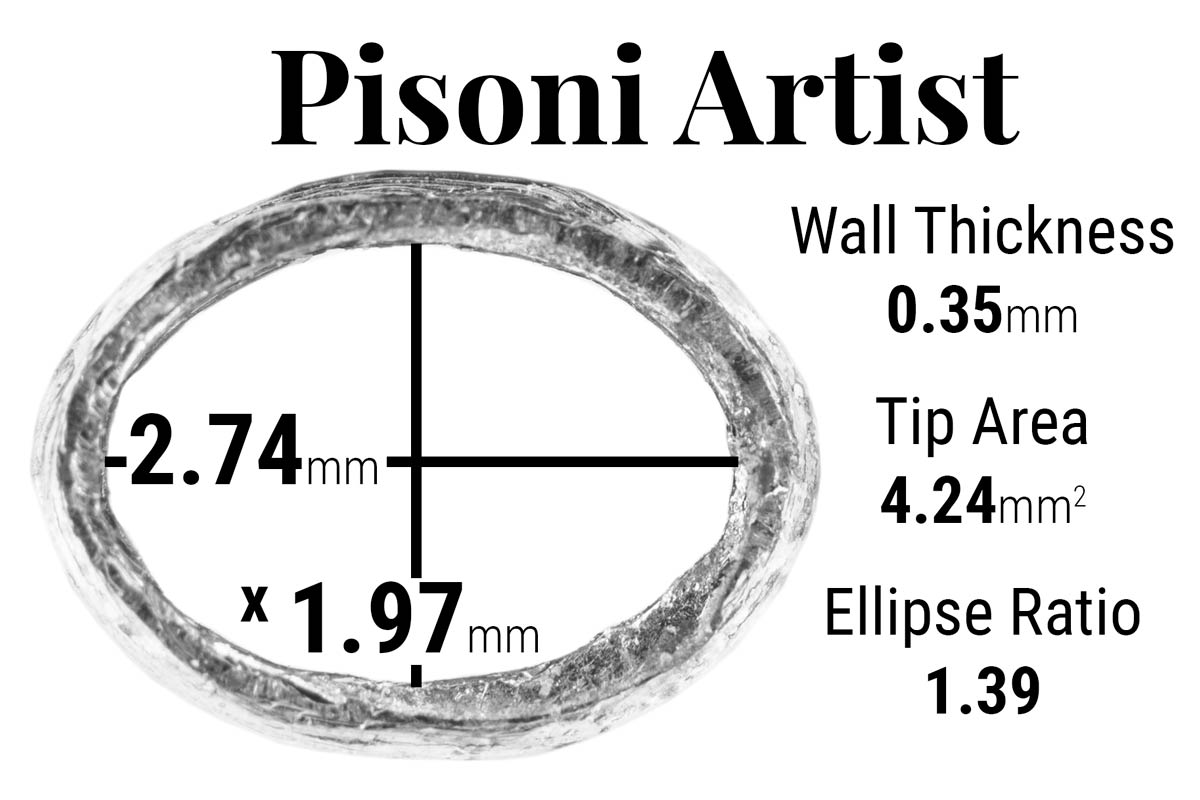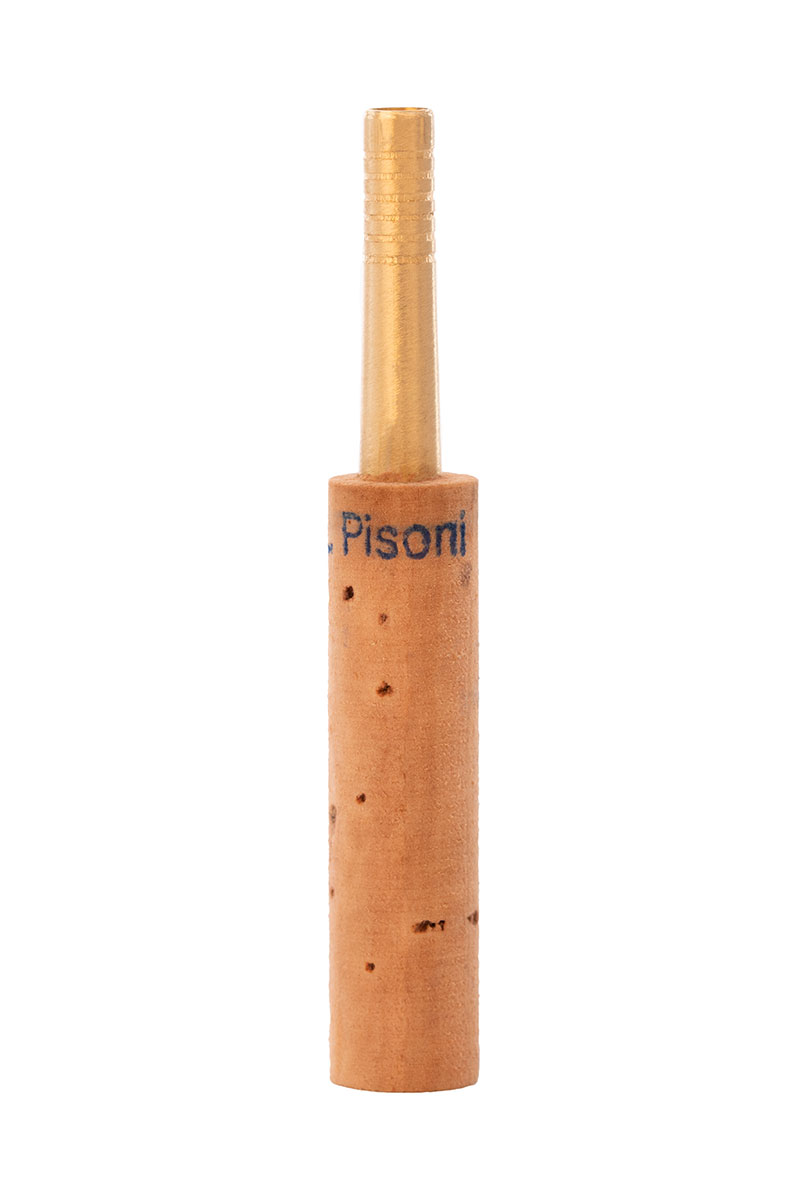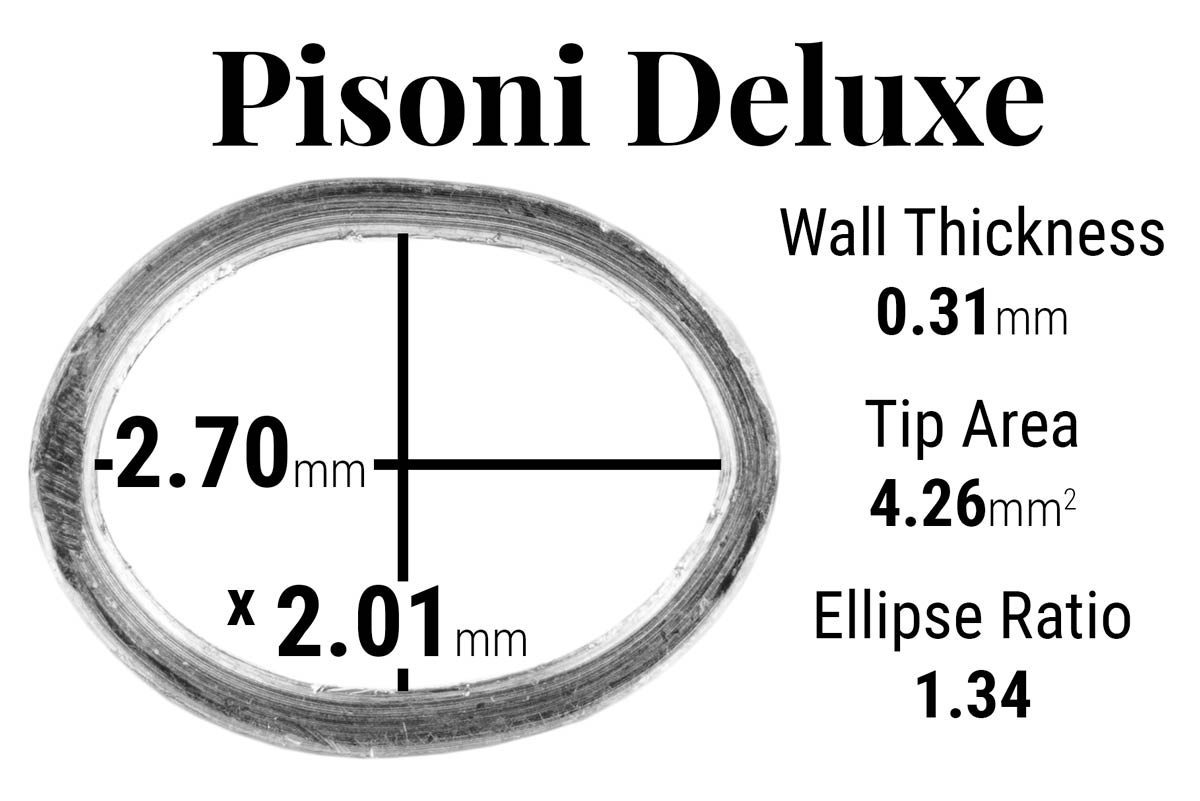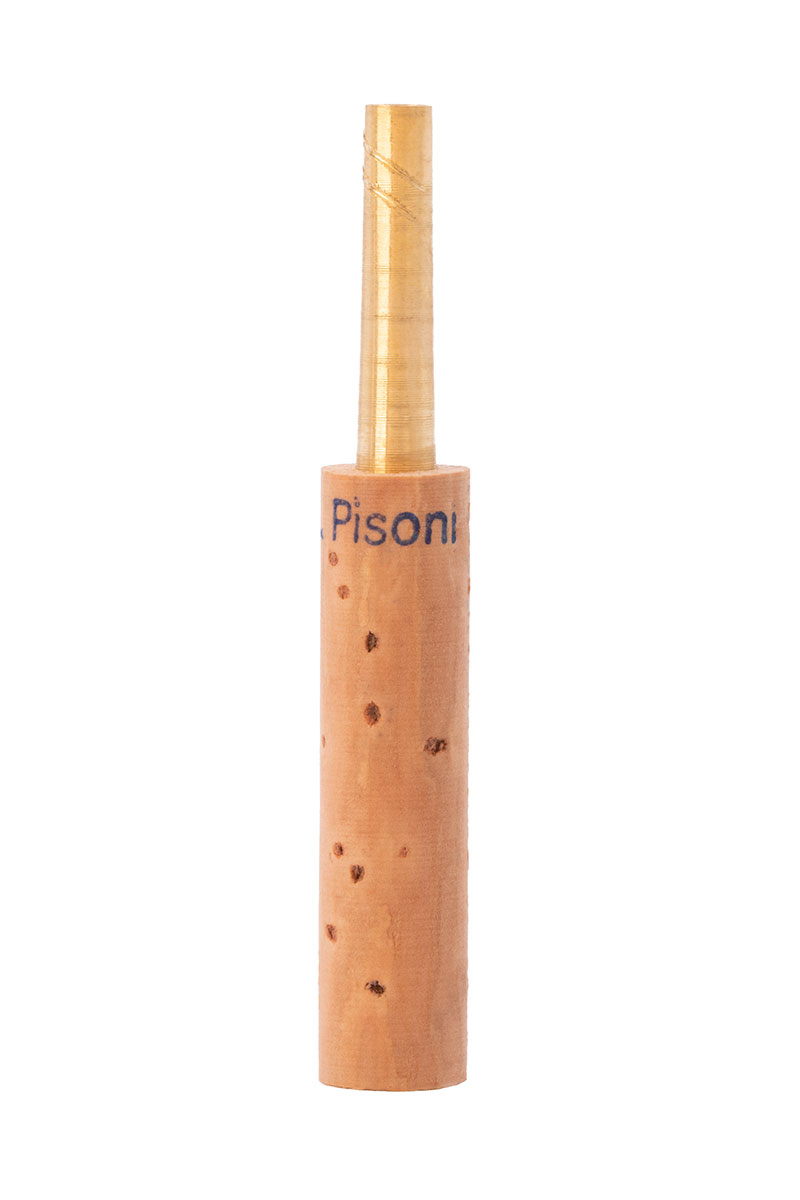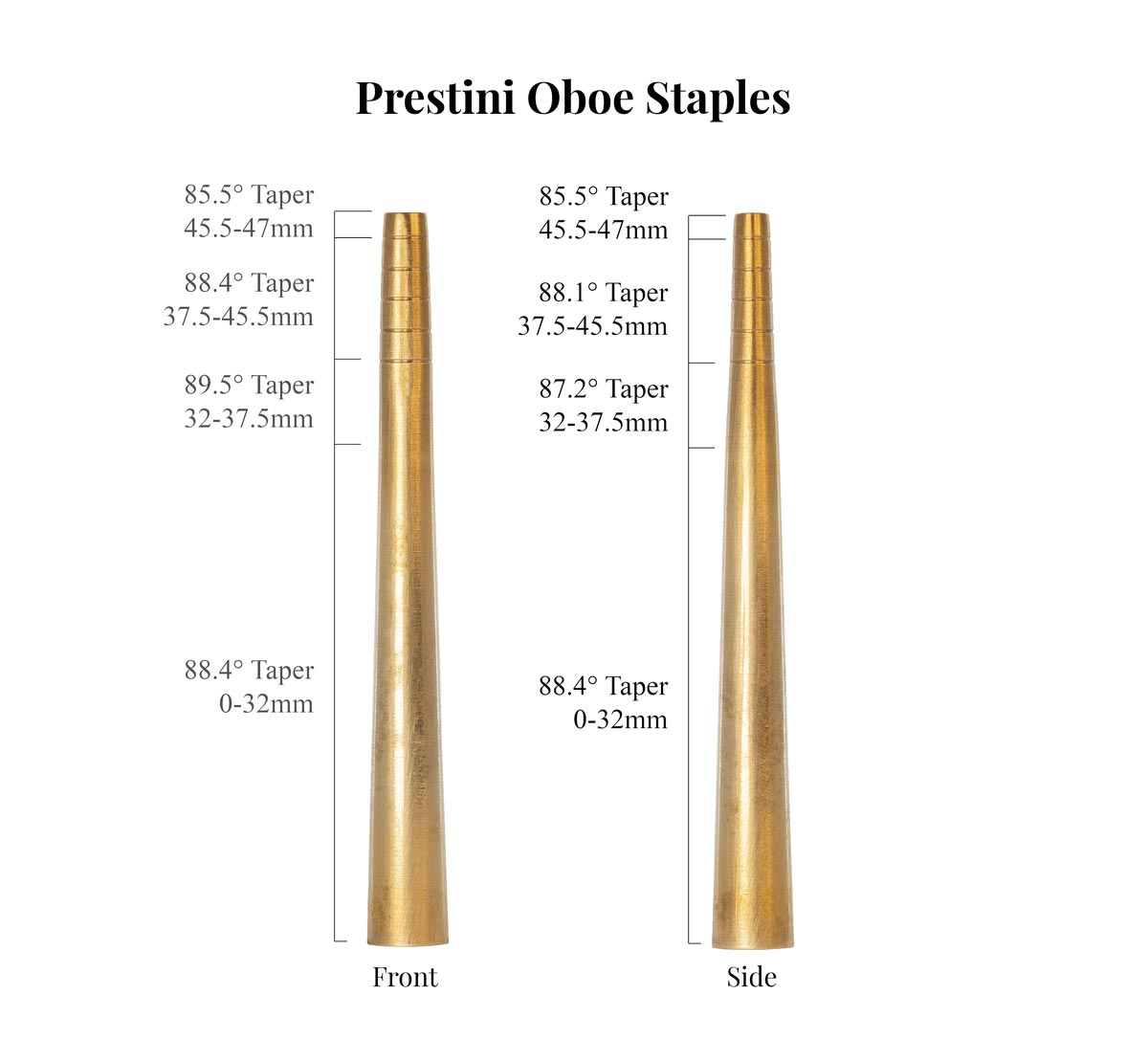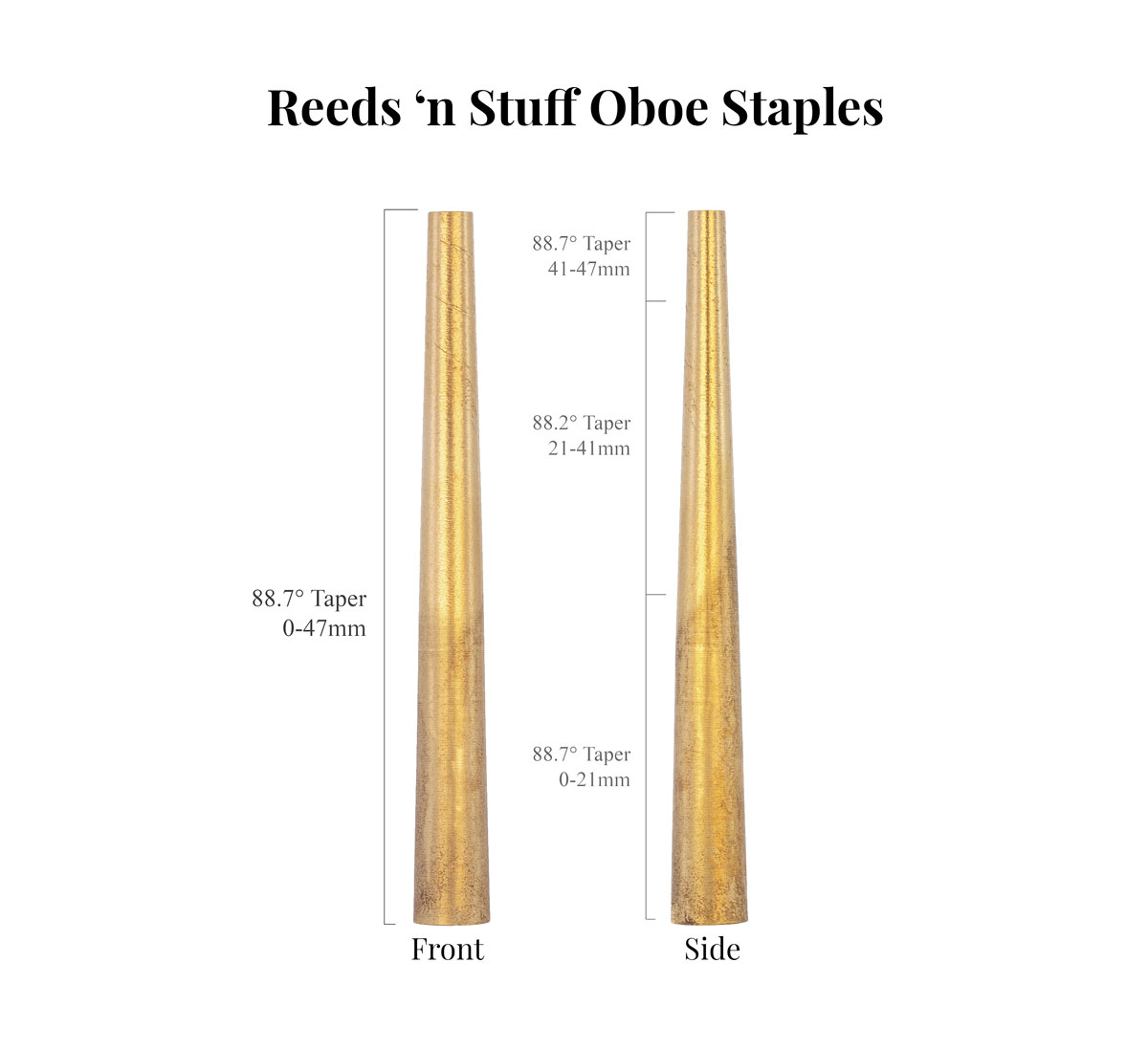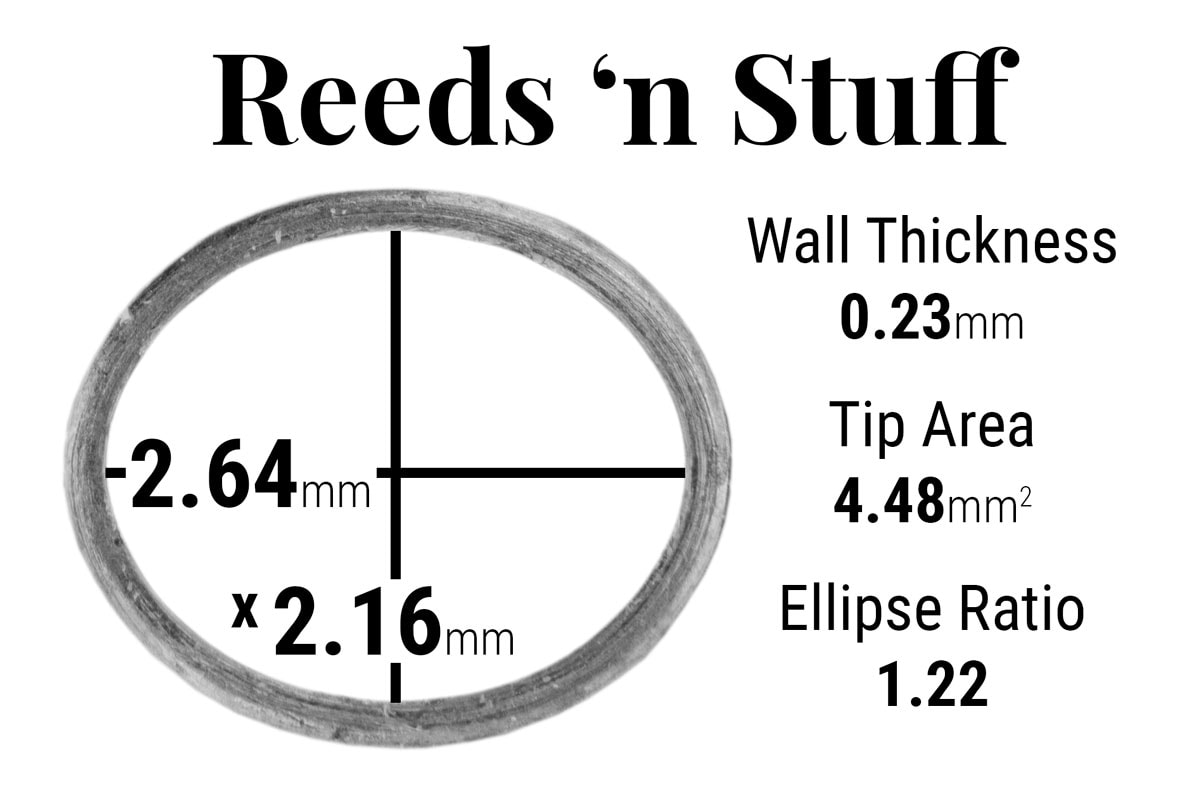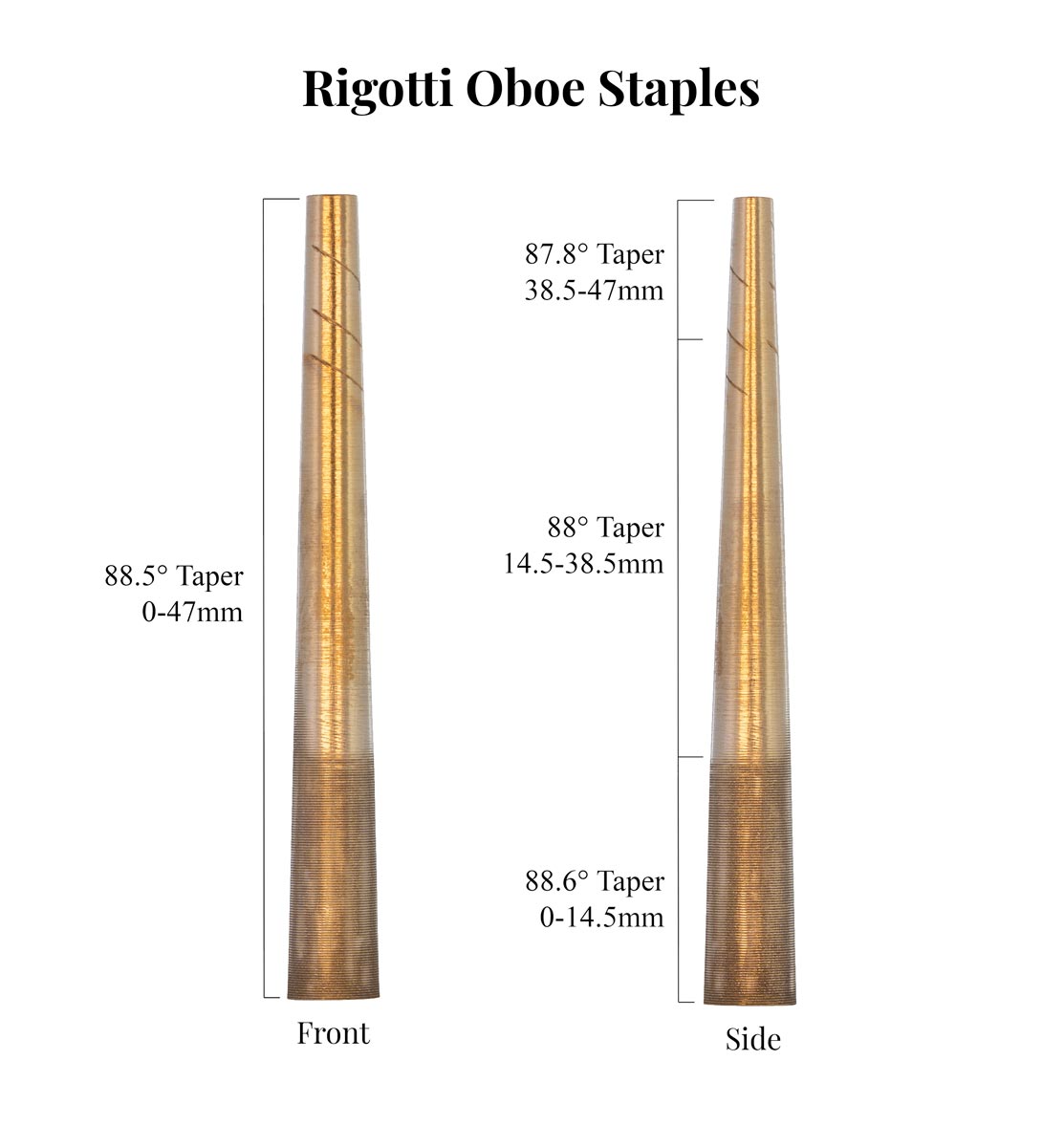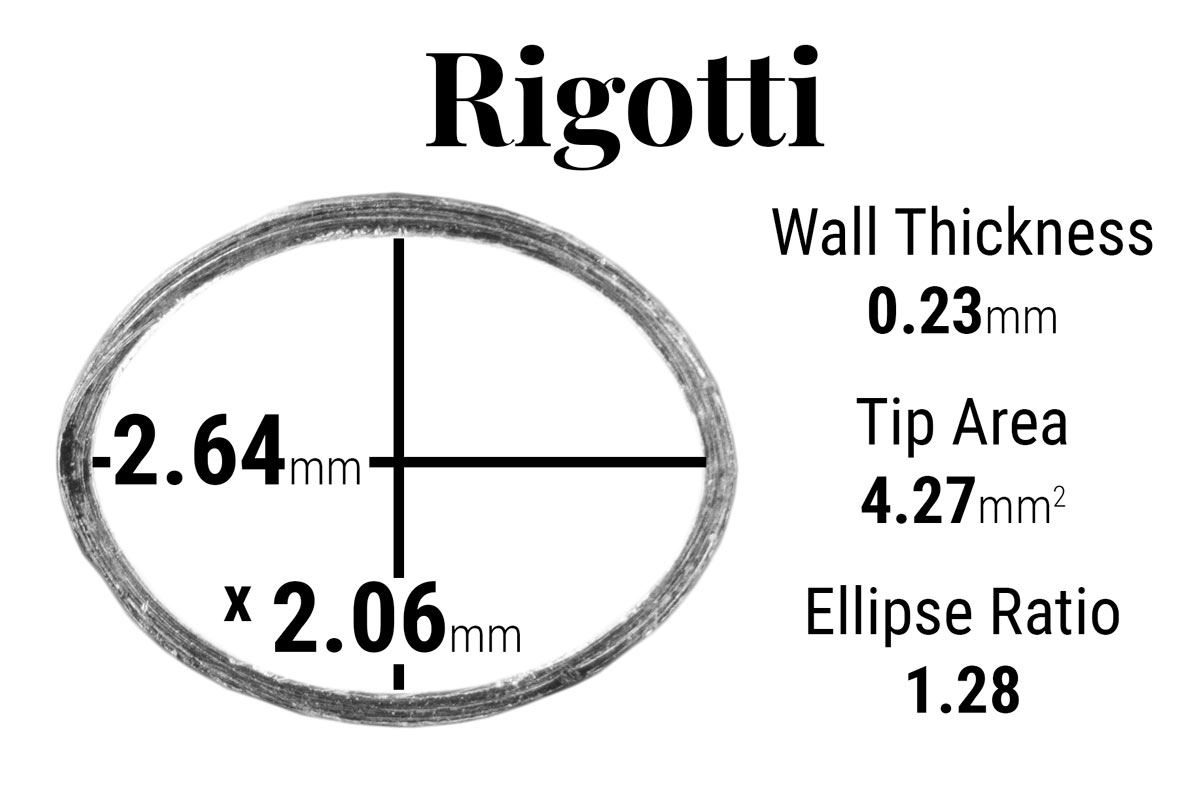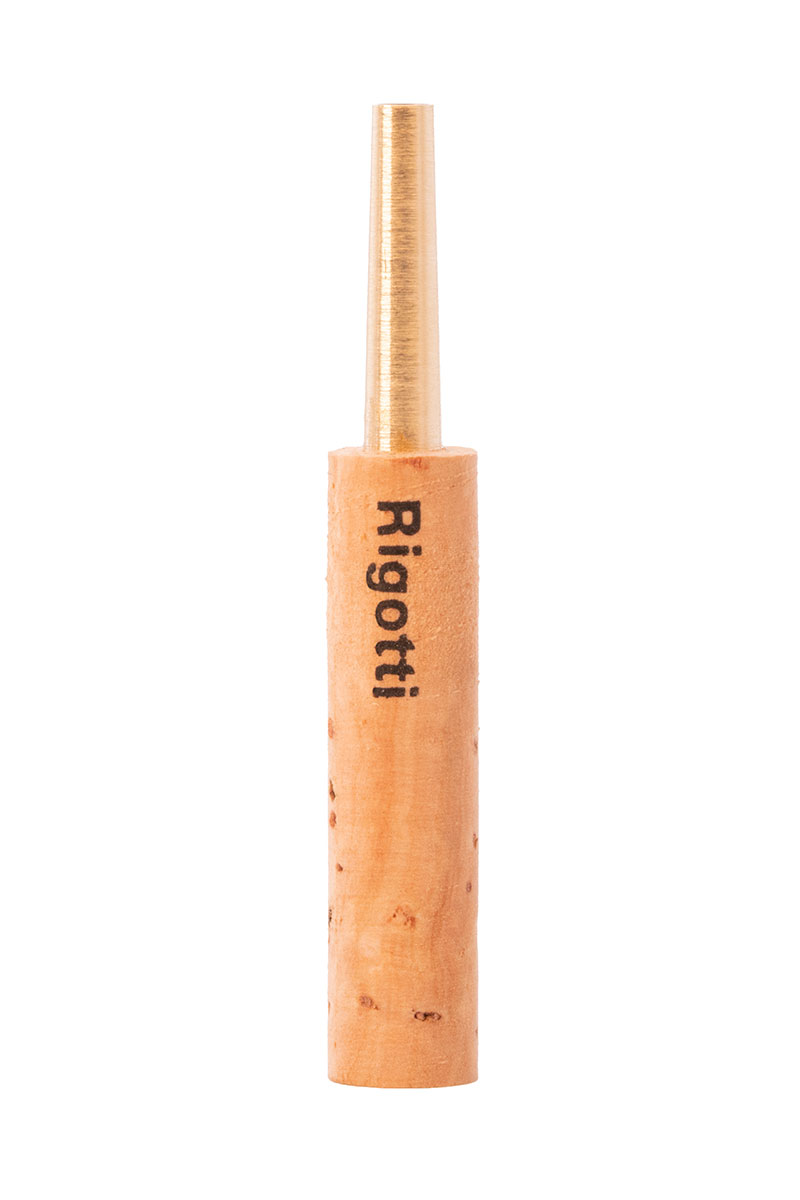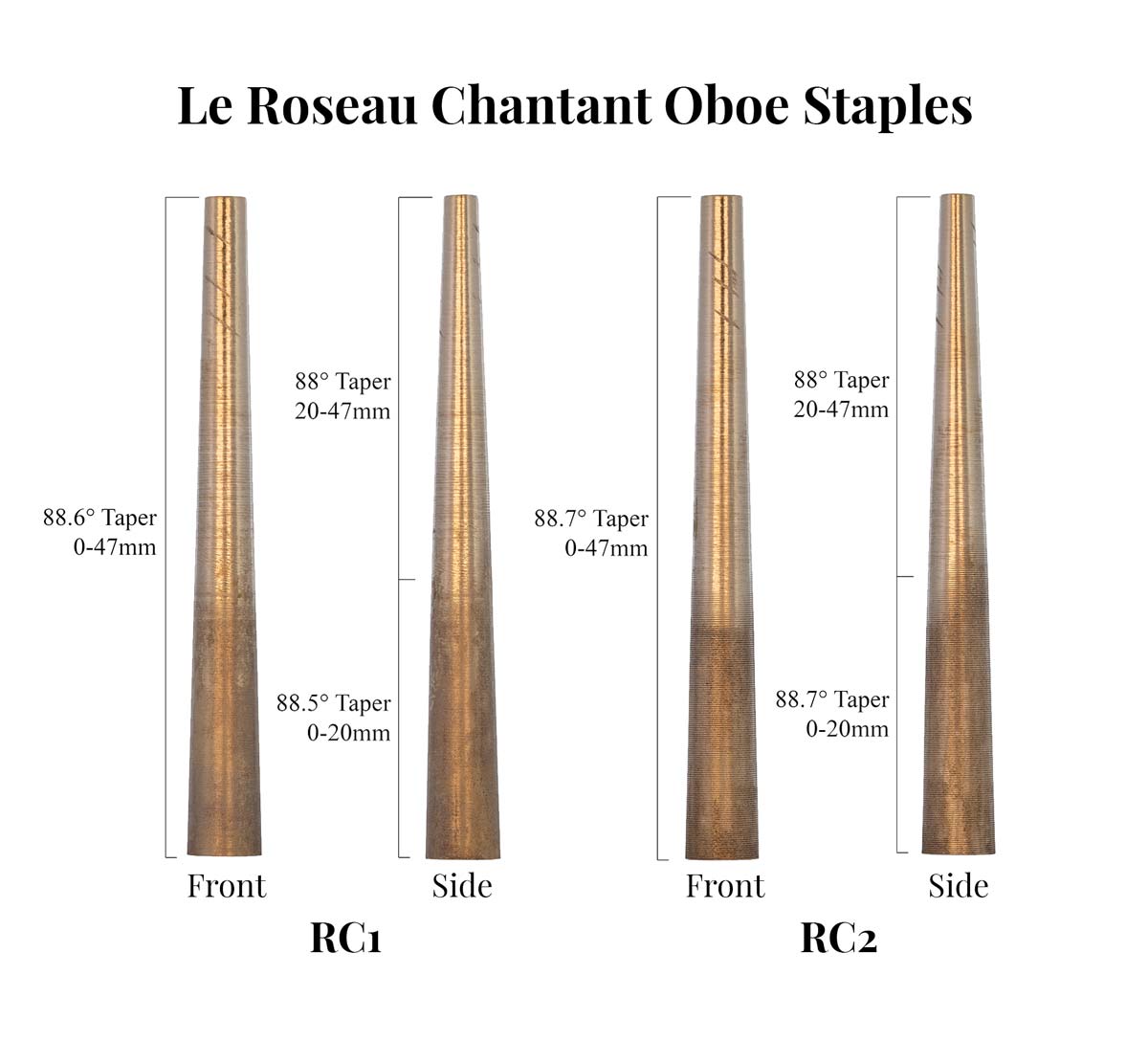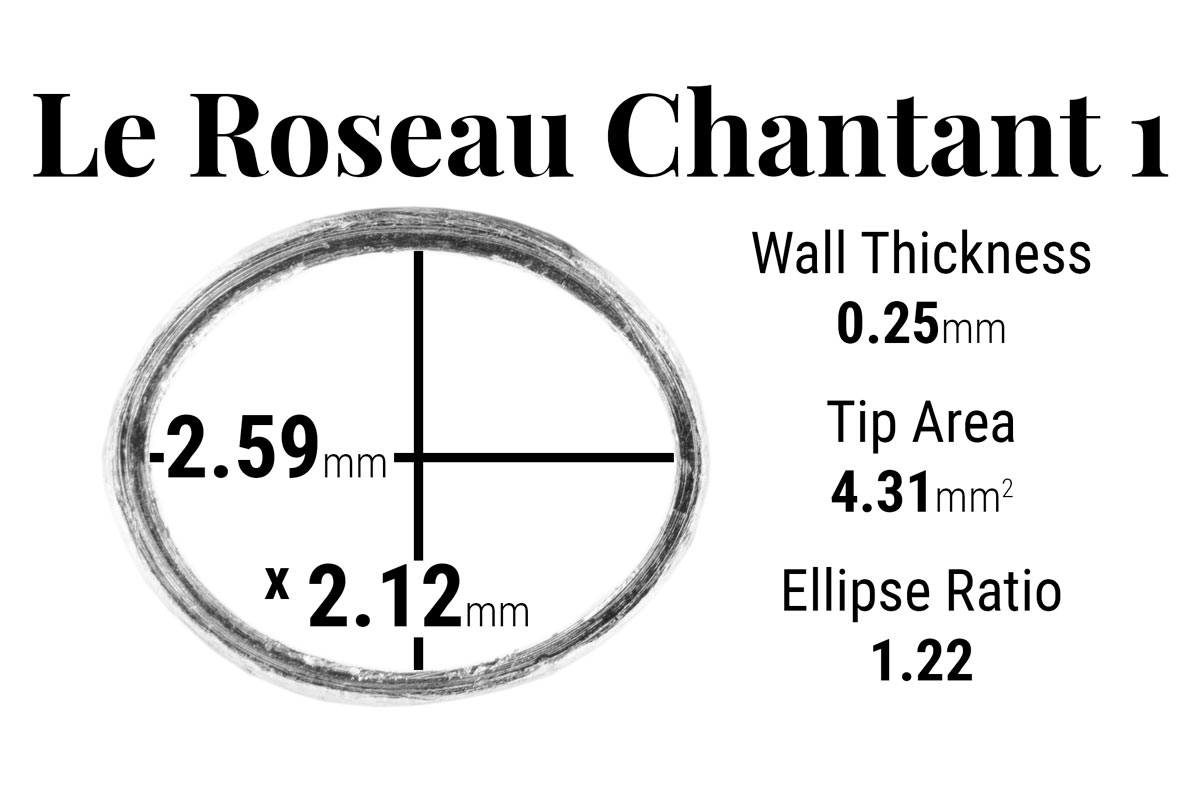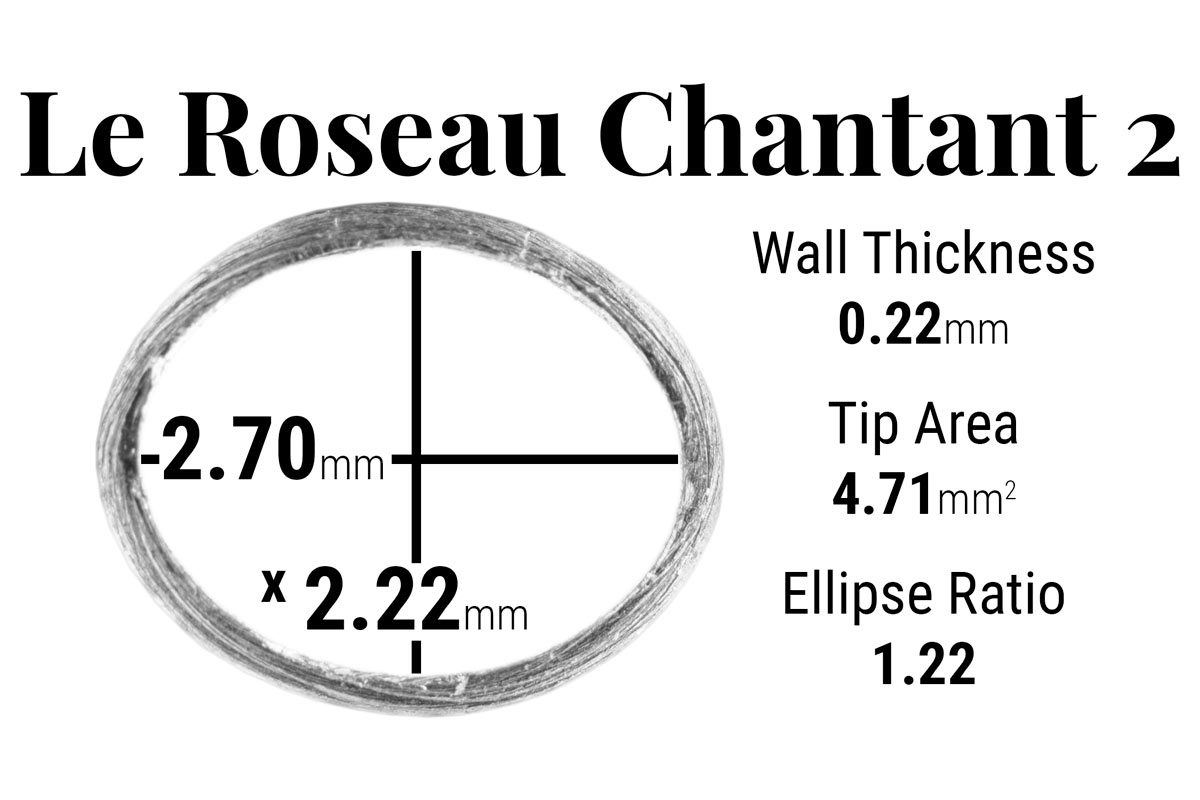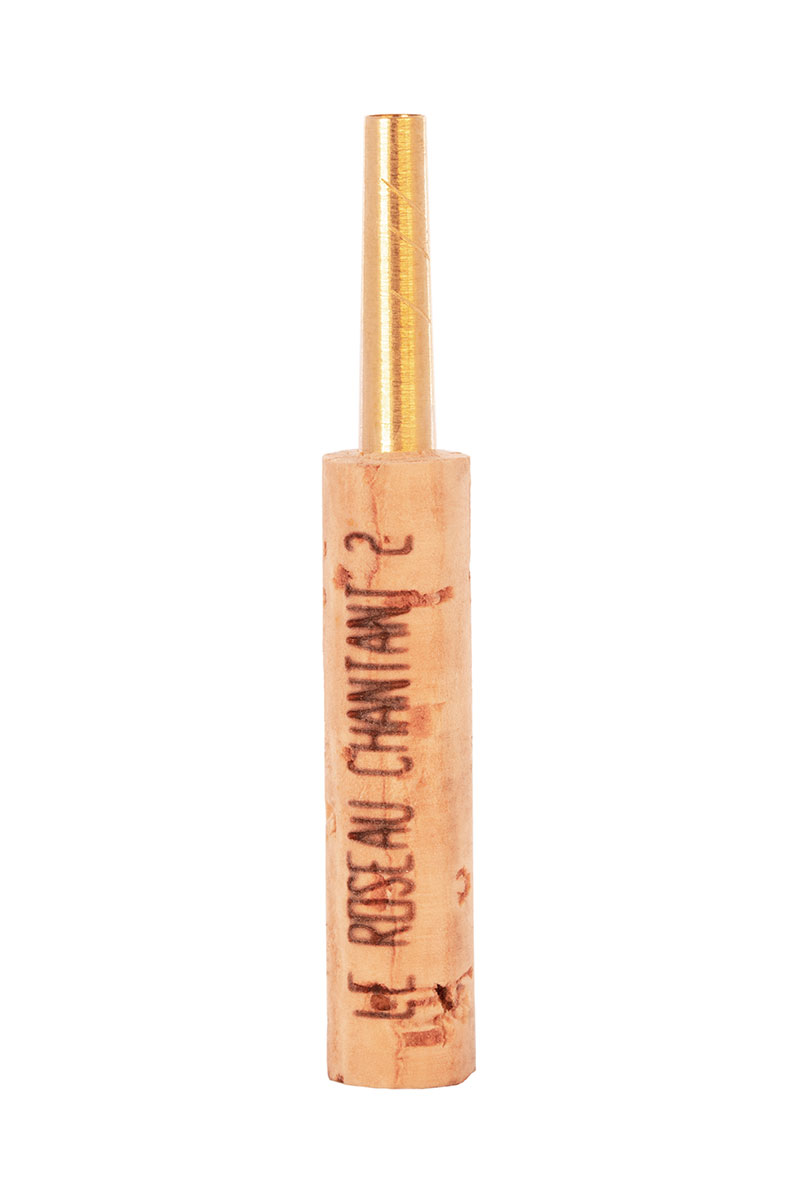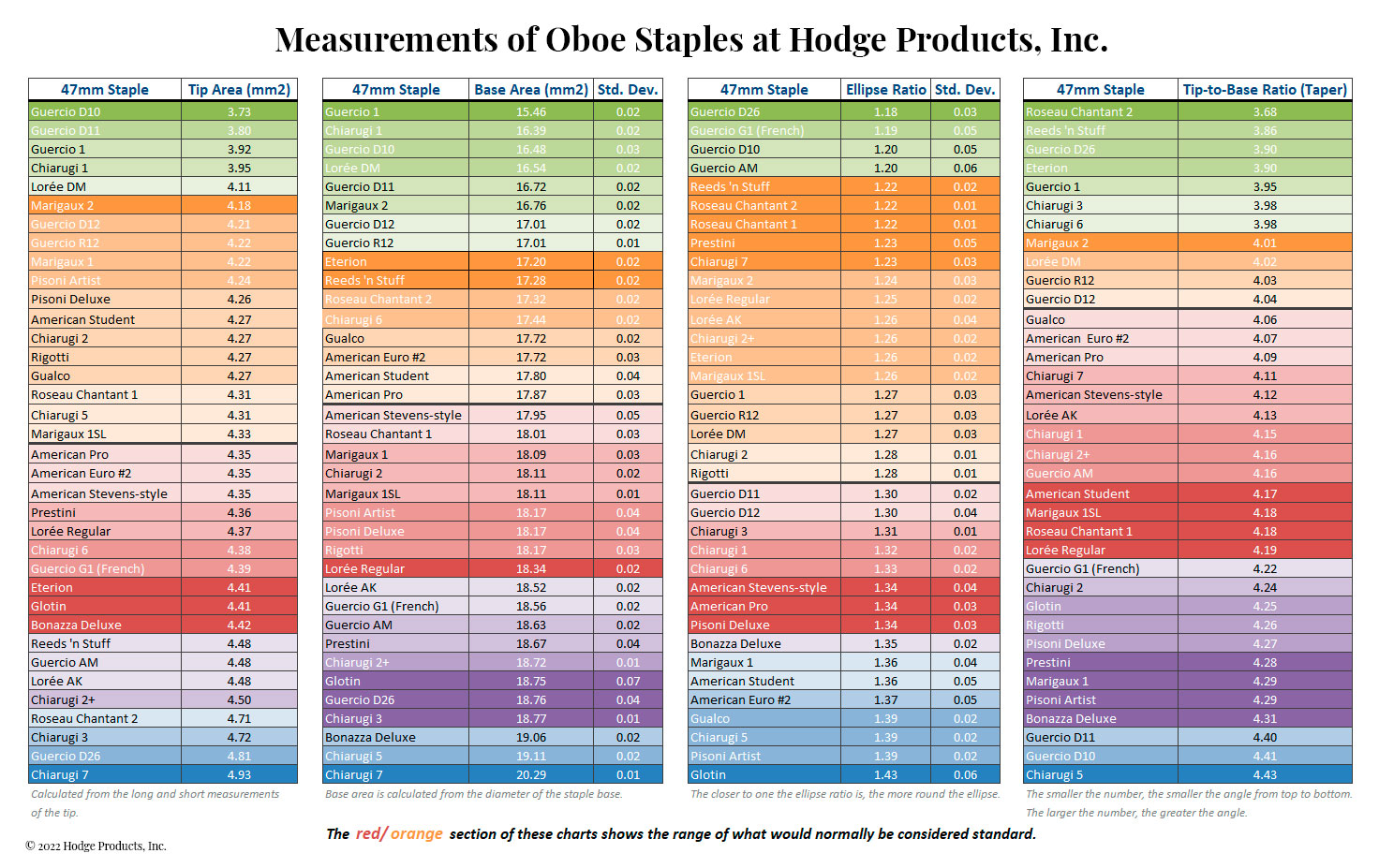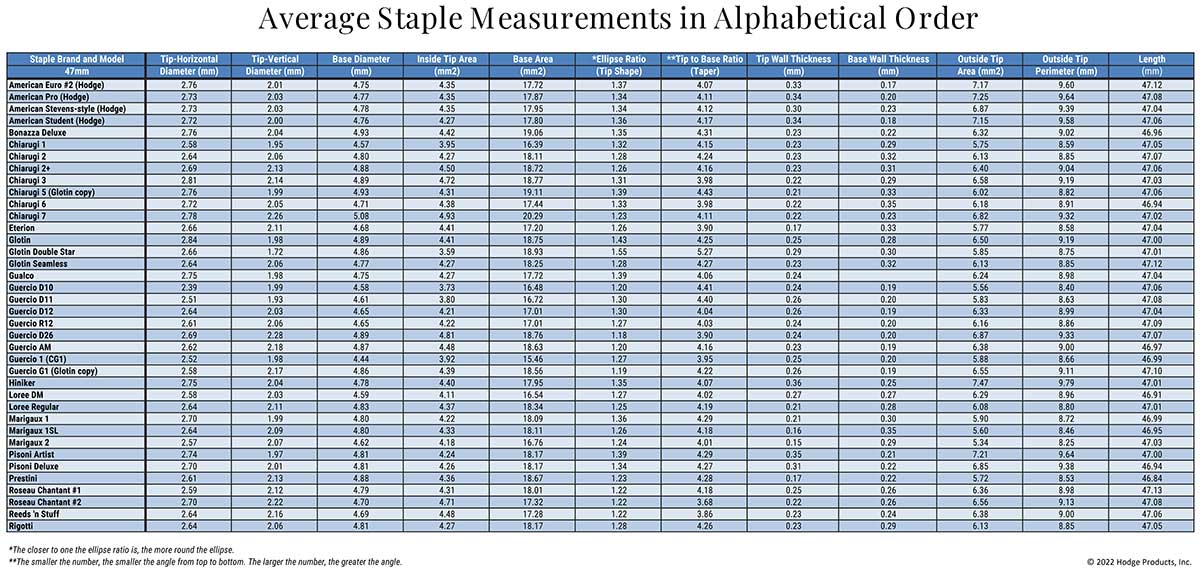15 Oboe Staple Brands
Posted by Ann Hodge on Mar 14th 2022
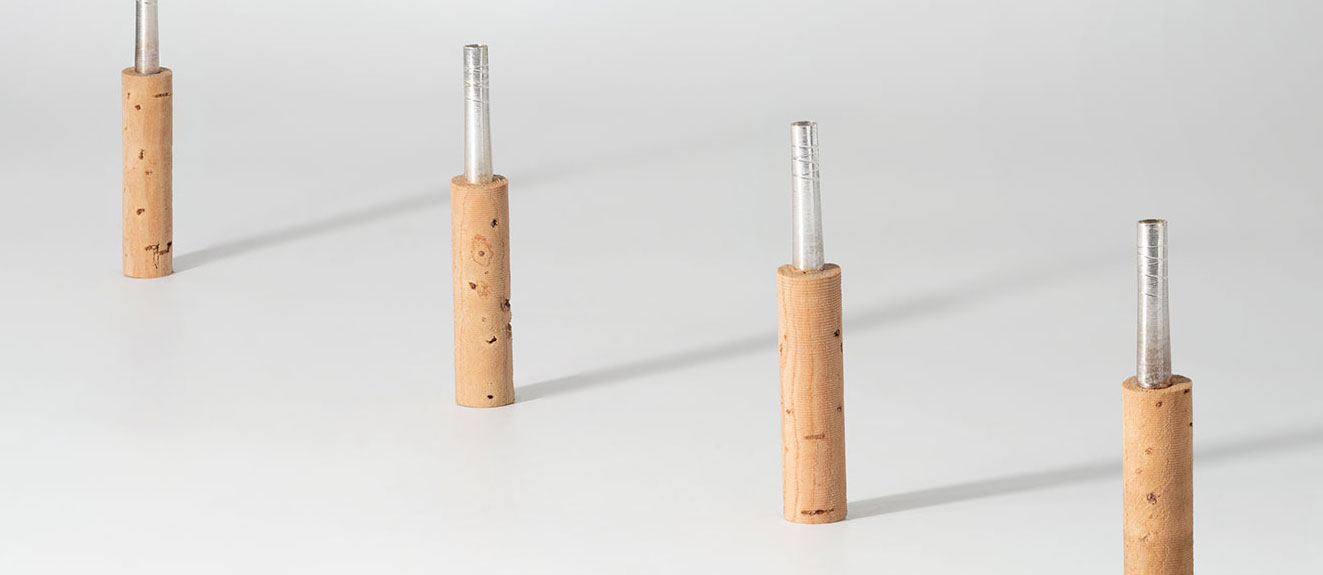
Chapters
- How to Select Your Oboe Staple
- Introduction
- Chapter 2
- 10 Characteristics of Oboe Staples
- Chapter 3
- 15 Oboe Staple Brands
- Chapter 4
- Oboe Mandrels
- Conclusion
- Oboe Staple Selection Tool
Chapter 3
15 Oboe Staple Brands
Staple Brands
Being an oboe specialty shop puts us in the unique position to test, measure, and analyze literally thousands of staples from more than a dozen brands. We have the largest selection of oboe staples in North America, with nearly 100 oboe staple options alone and adding more regularly.
This variety is overwhelming.
How do I navigate the myriad of options and choose the staple that works best for me?
Spend time studying the information provided in Chapter 2 - 10 Characteristics of Oboe Staples to understand how small changes in your staples affect your reeds. Use the charts to determine what staples might make the changes you want. Then look at the detailed information on the staples you are interested in, which is provided in the following blog, or view our product descriptions on each product page. But first a quick overview of what we offer in our shop.
The following is a detailed dive into the characteristics of each staple model along with helpful graphics. In alphabetical order by brand, each staple has a list of characteristics compared to other well-known staples for a starting point.
1. American (Hodge Brand)
- Country – made in America
- Manufacturing Process – made using the old school method of hammer-forging with equipment that dates back to the turn of the 20th century.
- Cork – synthetic and natural cork options
- Wall Thickness – Thick walls that get thinner at the base (.30-34mm decreasing to .17-.23mm)
- Metal Type – brass or nickel-silver
- Metal Finish – various finishes and scoring provide grip for the cane
- Tip Area – similar to Bonazza and Lorée
- Base Area – slightly smaller than RC1 and Chiarugi 2
- Tip Shape – on the flatter side
- Mandrel – no mandrel (other brands recommended below)
- 4 Models
American Student
- Cork – synthetic cork beveled at the end to make it easier to insert it into the reed well, 30-31mm long
- Metal Finish – polished finish
- Markings – spiraled down to the cork for good cane and thread grip
- Tip Area – average, same as Chiarugi 2 and close to Pisoni Deluxe
- Base Area – 17.8mm2 (4.76mm diameter), average, close to Chiarugi 2 and Pisoni
- Tip Shape – flatter, same as Bonazza Deluxe and close to Pisoni
- Volume – small-average, similar to Lorée regular
- Taper – similar to Lorée regular
- Mandrel – fits best on a Pisoni mandrel
American Pro
- Cork – synthetic cork with flat bottom, 30-31mm long
- Metal Finish – beautifully polished metal and finished tip
- Markings – spiraled down to the cork for good cane and thread grip
- Tip Area – average, slightly bigger than student version, closer to Lorée regular
- Base Area – 17.87mm2 (4.77mm diameter), average, close to Chiarugi 2 and Pisoni
- Tip Shape – flatter, same as Pisoni
- Volume – large-average, same as Bonazza Deluxe
- Taper – average, a little straighter than Lorée AK
- Mandrel – fits best on a Pisoni mandrel
American Stevens-Style
- Cork – natural cork, 30-31mm long
- Metal Finish – sanded finish
- Markings – double hand-scored diagonal lines
- Tip Area – average, close to Lorée regular, less than Stevens #2 staple
- Base Area – 17.95mm2 (4.78mm diameter), average, close to Chiarugi 2 and Pisoni, less than Stevens #2 staple
- Tip Shape – flatter-average, same as Pisoni Deluxe and Stevens #2 staple
- Volume – average, similar to a Chiarugi 2+ and Lorée AK
- Taper – average, close to Lorée AK and close to the Stevens #2 but a little smaller and without the inside bevel on the tip
- Mandrel – fits best on a Pisoni mandrel
These staples are the closest to the popular Stevens #2 staples in taper and shape of the tip, but the tip size and base are a little smaller than the Stevens #2 and don’t include an inside bevel on the tip.
American Euro #2
- Cork – natural cork, 31-32mm long
- Metal Finish – polished finish, beveled and polished tip
- Markings – none
- Tip Area – average, close to Lorée regular
- Base Area – 17.72mm2 (4.75mm diameter), average, close to Chiarugi 2
- Tip Shape – flat, close to Pisoni
- Volume – average, same as Lorée AK
- Taper – straighter-average, straighter than Lorée AK
- Mandrel – fits on Chiarugi 2, Lorée, and Rigotti mandrels
As its name implies, these staples are very similar to the traditional European Chiarugi #2 / Lorée / Rigotti staples.
2. Bonazza Deluxe
- Country – made in Italy
- Cork – natural cork, 29-30mm long
- Wall Thickness – medium-thin walls stay the same from top to bottom (.23mm)
- Metal Type – only available in silver-plate (a small amount of brass left at our shop)
- Tip Area – almost the same as Glotin staples and close to Guercio AM
- Base Area – 19.06mm2 (4.93mm diameter), same as Guercio AM
- Tip Shape – on the flatter side
- Mandrel – no Mandrel (Fits on Rigotti, Le Roseau Chantant 1, and Marigaux 1)
These mandrels are all quite different from each other. It appears that the Bonazza Deluxe staple has an interior section that holds each of these mandrels so that the top of the staple is flush with the tip of the mandrel. While they look like they fit, the fit is not precise. Additionally, the Le Roseau Chantant 2 fits snuggly, but it will round the staple tip a bit.
3. Chiarugi
- Country – made in Italy
- Manufacturing Process – CNC Lathe
- Cork – natural cork from Portugal covering 2/3rds of staple, 30-30.5mm long
- Wall Thickness – medium-thin walls that get thicker at the base (.22-.23mm increasing to .29-.35mm)
- Metal Type – available in brass or some models also available in nickel-silver, #2 available in superstaple designs
- Tip Area – varies by staple model
- Base Area – varies by staple model
- Tip Shape – very nicely shaped oval except the Chiarugi 5 which is flatter because it’s a copy of the flat-tipped Glotin
- Mandrel – mandrels available for each size
- 7 Models
In general, Chiarugi makes all their staples with a single taper angle down the sides of the staple and two angle changes down the front/back of the staple. The top angle shift occurs 8.5mm from the top of the staple. The lower angle shift varies, anywhere between 14mm – 22mm from the bottom.
Chiarugi #1
- Tip Area – small, similar to Lorée DM
- Base Area – 16.39mm2 (4.57mm diameter), small, similar to Lorée DM
- Tip Shape – average ellipse, not as round as Lorée DM
- Volume – smallest of all brands
- Taper – average
Chiarugi #2
- Tip Area – average, similar to Lorée regular
- Base Area – 18.11mm2 (4.8mm diameter), average, similar to Lorée regular
- Tip Shape – average ellipse, not as round as Lorée regular
- Volume – lower-average, similar to Lorée regular
- Taper – average
This staple is also available in brass in all three superstaple designs, “E” (Excavated), “S” (Solid), and “M” (Solid Midway).
Chiarugi #2+
- Tip Area – larger-average, almost identical to the Lorée AK
- Base Area – 18.72mm2 (4.88mm diameter), larger-average, almost identical to the Lorée AK
- Tip Shape – average ellipse, identical to the Lorée AK
- Volume – higher-average, identical to the Lorée AK
- Taper – average
Chiarugi 2+ and Lorée AK are, according to Mark Chudnow, the same as the Chudnow and Sierra staples, all of which are made by Chiarugi. Howarth also claims that the staples with their name on them are Chiarugi 2+. (We don't carry Howarth staples at this time.) The Oboe Shop @ Cgrid-wrap_2thers in the UK recommends the Chiarugi 2+ for both the Howarth and Rigoutat oboes.
Chiarugi #3
If you are having issues with flatness in the upper notes of the second octave and you usually use a Chiarugi 2+ or Lorée AK staple, the Chiarugi 3 would be a good substitute since the base diameter is similar to the 2+ but the tip area is increased. See Section 2 (Tip Area) in Chapter 2, 10 Characteristics of Oboe Staples blog post.
Le Roseau Chantant recommends this staple for more closed-bore instruments like the Lorée 125 or Royal AK, Laubin, or Yamaha (41-series, North American models).
Chiarugi #5
- Tip Area –average, between Chiarugi 2 and Lorée regular
- Base Area – 19.11mm2 (4.93mm diameter), large, very close to the Bonazza Deluxe
- Tip Shape – flatter ellipse, similar to but not quite as flat as the modern Glotin
- Volume – large, almost the same as the Bonazza Deluxe
- Taper – most angled or conical shape offered at Hodge Products
The Chiarugi 5 is a copy of the Glotin staple though it is not clear which version. The most similar characteristic to the current version is that it has a flatter ellipse than other Chiarugi staples but not quite as flat as the Glotin is now. I must note, however, that the mandrel is a little bit rounder and tends to round out the staple so that the tip is similar to the Chiarugi 6, though the base is still much bigger than a Chiarugi 6.
The Oboe Shop @ Cgrid-wrap_2thers in the UK recommends this staple for the Lorée, Marigaux, and Buffet oboes.
Chiarugi #6
- Tip Area –average, between Chiarugi 2 and Lorée regular
- Base Area – 17.44mm2 (4.71mm diameter), smaller-average, much smaller than the Lorée regular
- Tip Shape – average ellipse, similar to Lorée regular and other Chiarugi staples
- Volume – smaller-average, smaller than the Lorée regular
- Taper – straighter, the same as Chiarugi 3
Compared to the Lorée regular staple, the Chiarugi 6 will lower the pitch progressively through the entire upper octave (D5-C6) because the base is smaller than the Lorée.
Chiarugi #7
- Tip Area – huge
- Base Area – 20.29mm2 (5.08mm diameter), huge
- Tip Shape – rounder side of average ellipse
- Volume – huge
- Taper – average
This is the largest staple we offer at Hodge Products. The Chiarugi 7 was designed for Dutch oboists who make very short reeds with a long scrape. They also use very short staples (42mm) which offsets the large bore. We only recommend this staple to American oboists who use an extremely wide shape such as the RDG 2. First, we suggest trying the 46mm before trying the more extreme 47mm option. Surprisingly, I made a decent reed on a 47mm staple with a Joshua +2 shape (which is relatively nargrid-wrap_2) that played at 440 Hz. The blades needed to be well slipped to work.
4. Eterion
- Country – made in Italy by Chiarugi
- Manufacturing Process – CNC Lathe
- Cork – natural cork from Portugal covering 2/3rds of staple, 30-30.5mm long
- Wall Thickness – thin walls increasing to a much thicker base (.17mm increasing to .33mm)
- Metal Type – available in brass only
- Tip Area – large-average, same as Glotin
- Base Area – 17.20mm2 (4.66mm diameter), smaller-average, in between Guercio D12 and Roseau Chantant #2
- Tip Shape – average ellipse, same as Chiarugi 2+
- Volume – same as Reeds 'n Stuff
- Taper – fairly straight, same as Guercio D26
- Mandrel – Eterion mandrel available
The Eterion staple was developed by Oboe-Shop.de, together with famous oboists David Walter, Ramon Ortega and Nick Deutsch.
By reducing the thickness of the brass and by changing the staple's geometry, the Eterion plays more comfortably than conventional staples. The intonation is well balanced and the sound more rounded.
According to Oboe-Shop, the staple is especially suitable for Marigaux and Josef oboes and all oboists who like the Guercio D12, Chiarugi 2 or Glotin staples.
5. Glotin
- Country – made in France
- Manufacturing Process – formed from a flat sheet around a proprietary shape with a silver-brazed seam
- Cork – natural cork, 30.5 - 31mm long
- Wall Thickness – medium-thick walls that get slightly thicker at the base (.25mm increasing to .28mm)
- Metal Type – available in brass or nickel-silver
- Tip Area – large side of average
- Base Area – 18.75mm2 (4.89mm diameter), large
- Tip Shape – one of flattest ellipses we have
- Mandrel – mandrel available
They also make a seamless version out of brass only. Typically, a seamless staple is made out of a tube that is then formed to the correct shape. We have recently added some to our stock but it turns out their seamless staple is just a Chiarugi 2 staple.
Glotin has changed their staples over the years and the flatter shape that is available now is not necessarily their consistent goal. The standard deviation in a Glotin staple is fairly high as they are not terribly consistent. You can find beautiful elliptical shapes if you’re able to dig through them or take a chance on what you order.
John Ferrillo, principal oboe of the Boston Symphony Orchestra, spends extra time looking for staples that match his 1960’s Glotin mandrel, describing the staples he’s looking for as,
the opening at the top has a lovely elliptical shape - not too round, not too small, not too large. This is needed to create the Goldilocks situation where the tubes are not so large as to cause noise and sharpness, and not so small as to cause choked, flat upper registers.
Due to the flatness of the tip shape, some players have noticed that their F tends to be louder than other notes. See Air Flow in Flatter Staples in Chapter 2 - 10 Characteristics of Oboe Staples.
Glotin also now offers a smaller, flat staple called the "Double Star". It turns out this staple is a staple of extremes. It has the smallest tip area of any of the staples discussed here, yet the base area is fairly large. This staple is even flatter than the standard version, making it the flattest staple here. These characteristics also make it the most angled staple by a significant amount.
- Country – made in France
- Manufacturing Process – formed from a flat sheet around a proprietary shape with a silver-brazed seam
- Cork – natural cork, 30.5 - 31mm long
- Wall Thickness – medium-thick walls that get slightly thicker at the base (.29mm increasing to .30mm)
- Metal Type – available in brass only
- Tip Area – Very small
- Base Area – 18.93mm2 (4.86mm diameter), large
- Tip Shape – the flattest ellipse we have
- Mandrel – no mandrel available at this time
6. Gualco (Superstaple)
- Country – made in Germany
- Manufacturing Process – CNC Lathe - an ebony core is inserted in the bore of the middle section
- Cork – none (Excavated metal with 3 rubber rings, 27.3mm long)
- Wall Thickness – medium-thin walls at the tip
- Metal Type – available in brass, copper-plated brass, and silver-plated brass
- Tip Area – average, same as Chiarugi 2
- Base Area – 17.72mm2 (4.75mm diameter), smaller side of average, a little smaller than Chiarugi 2
- Tip Shape – flatter side, same as Chiarugi 5
- Mandrel – no mandrel, Roseau Chantant #1 recommended
Generally, this staple is very similar to the measurements of the excavated Chiarugi 2. The wood insert is meant to help with the vibrations in the large amount of metal that must vibrate, and to help sweeten the tone.
7. Guercio
- Country – made in Germany
- Manufacturing Process – a rolling process with seamless tubes following the Klopfer model
- Cork – natural cork, approx. 29mm long
- Wall Thickness – medium-thick walls that get thinner at the base (.23-26mm decreasing to .19-.20mm)
- Metal Type – available in brass, nickel-silver, special brass alloy, solid silver, gold-plate, palladium-plate
- Tip Area – varies by staple model
- Base Diameter – varies by staple model
- Tip Shape – varies by staple model
- Mandrel – mandrel available for each model
- 8 Models
Guercio uses a taper style that produces more volume than most other staple manufacturers with a similar top-to-bottom ratio. Their staples have two places where the angle changes and they also "pinch" the top on some staples (D10, D26, G1). To increase the volume, they add a shoulder in the middle to the R12.
For example, Guercio’s smallest staples, D10, D11, and Guercio 1, which have the smallest tip area and nearly the smallest base area of any other staples we have measured, have more volume than other brand staples with slightly more tip areas and base areas. Also, their wall thickness at the tip, which is in the medium range, gets thinner toward the bottom, more like the thick-walled staples made by Pisoni and the American staples.
The various Guercio models that start with D are all variations on the old, well-liked Klopfer staples which Gottfried Möckel sorted into sub-sections. A couple of other Guercio models have been influenced by current great European oboists such as Albrecht Mayer of the Berlin Philharmonic and Carlo Romano of l’Orchestra Sinfonica Nazionale della RAI in Tourin, Italy.
Guercio D10
The smallest Klopfer model; best paired with German-style oboes such as Ludwig Frank, Mönnig, Springer, and Josef. It has a pinched almost round tip creating a very small tip, but it still has good volume in the rest of the staple to produce a refined sound.
Guercio D11
- Tip Area – small, just slightly larger than Guercio D10
- Base Area – 16.72mm2 (4.61mm diameter), small, just slightly larger than Guercio D10
- Tip Shape – average oval
- Volume – small, just slightly larger than Guercio D10
- Taper – very angled, about the same as the D10
This model has a more oval, small tip and is not pinched (the main differences between it and the previous staple), so there is less resistance or back pressure. As with all small tips, the cane will need to be tied longer than on a larger-tipped staple. This staple will help close down a reed.
Guercio D12
Somewhat similar to standard staple measurements, this staple matches well with the French-style oboes such as Lorée Royal, Marigaux, Buffet, Rigoutat, and Howarth. German players have also especially liked these staples because they offer a "greater dynamic range with freer response, if less refinement or sweetness" than the D10 and D11. (Salter, p.445)
Guercio R12
- Tip Area – smaller average, about the same as the D12
- Base Area – 17.01mm2 (4.65mm diameter), small, same as the D12
- Tip Shape – average oval, same as the D12
- Volume – large, much bigger than the D12
- Taper – straighter average, about the same as the D12
The R12 is a staple made in collaboration with the Italian oboist, Carlo Romano. It has the same basic measurements as the D12 but a larger internal volume created by a shoulder section about 7.5 mm long in the middle of the taper, keeping the sound more stable.
Guercio D26
The D26 is the largest Klopfer model. It has a significantly larger base area and the tip is larger and more round than the other Guercio/Klopfer models. Additionally, it has a huge internal volume due to the pinched tip. This gives it slightly higher pressure at the beginning but a nice, clear sound going into the oboe. We recommend using this staple with a wider cane shape. The large tip will cause the cane to be more open at the wrap point. Overall, this staple tends to play sharper than standard-sized staples.
Guercio AM
- Tip Area – large, but less than the Guercio D26
- Base Area – 18.63mm2 (4.87mm diameter), large, almost the same as the D26
- Tip Shape – rounder, yet not as round as the D26
- Volume – large, but not quite as much as the D26
- Taper – average, unlike the D26 which is quite straight
This staple is based on the Guercio/Klopfer model D26. Albrecht Mayer designed this to match with his eponymous oboe, manufactured by German instrument maker Gebrüder Mönnig. He reduced the tip area and removed the "pinched tip" to reduce the internal volume of the staple. Even though the AM is a bit smaller than the D26, both are large compared to most other staples. "The Guercio AM offers an ideal match to the generous bore of the Josef ‘20th G.S’ oboe." (Salter)
Guercio G1 (Glotin Copy)
- Tip Area – large-average, close to the Lorée regular
- Base Area – 18.56mm2 (4.86mm diameter), large, same as the Lorée AK
- Tip Shape – quite round
- Volume – large
- Taper –average, similar to the Lorée regular
This is a copy of an old Glotin staple which many have come to love, but different from a contemporary Glotin staple and also from Chiarugi's Glotin copy. The Guercio Glotin copy has a rounder tip compared to the other two. However, it has much more volume due to its "pinched" tip.
Guercio 1 (GC1)
- Tip Area – small, similar to Chiarugi 1, smaller than Marigaux 2
- Base Area – 15.46mm2 (4.44mm diameter), the smallest that we offer, similar to Chiarugi 1, smaller than Marigaux 2
- Tip Shape – average, same as the Lorée DM
- Volume – small-average, close to the Guercio D11, larger than the Marigaux 2
- Taper – straight, same as the Marigaux 2
This staple is a recent design by Carmelo Guercio and, according to Oboe-Shop.de in Germany, is made especially to suit Marigaux oboes. Though the overall size is smaller than the Marigaux staples, it has the exact same tip-to-base ratio as the Marigaux 2 staple. Due to a straighter angle at the base, the Guercio 1 also has more volume than the Marigaux 2 despite the tip-to-base ratio being the same.
8. Hiniker
- Country – made in America
- Manufacturing Process – made using the old school method of hammer-forging with equipment that dates back to the turn of the 20th century.
- Cork – natural cork
- Wall Thickness – Very thick walls that get thinner at the base (.35mm decreasing to .25mm)
- Metal Type – brass or nickel-silver
- Metal Finish – smoot finish with strong scoring to provide improved grip for the cane
- Tip Area – similar to Bonazza and Lorée
- Base Area – slightly smaller than RC1 and Chiarugi 2
- Tip Shape – on the flatter side
- Mandrel – no mandrel (other brands recommended below)
These are oboe maker, Thomas Hiniker's, favorite staples. He has specified a number of external characteristics that are important for matching with his oboes. Specifically, these include:
- Thick natural cork
- Cork glued solidly the entire length
- Thick wall
- No chamfering of the top
- Thick scoring for holding the cane securely
9. Lorée
- Country – made in Italy by Chiarugi
- Manufacturing Process – CNC Lathe
- Cork – natural cork, 30.5 – 31mm long
- Wall Thickness – medium walls with similar base wall thickness
- Metal Type – available in brass or nickel-silver
- Tip Area – varies by model
- Base Area – varies by model
- Tip Shape – average oval
- Mandrel – mandrels available for all models
- 3 Models
Lorée staples, made by Chiarugi, are designed by Lorée to match the different bore models of their instruments. However, they work great in many different instruments and with many different reed styles.
Lorée Regular
- Tip Area – large-average, more than Chiarugi 2
- Base Area – 18.34mm2 (4.83mm diameter), large average, more than Chiarugi 2
- Tip Shape – rounder-average, more round than Chiarugi 2
- Volume – average, same as Chiarugi 2
- Taper – average, slightly more straight than Chiarugi 2
These staples have become the gold standard among American oboists. Although not precisely average, they are what most American oboists consider to be the standard staple design. Made for the regular Lorée oboe bore, they are very similar to the Chiarugi 2, with a slightly larger base diameter and a rounder larger tip area, which creates slightly less back pressure.
Lorée AK
- Tip Area – large, almost the same as Chiarugi 2+
- Base Area – 18.52mm2 (4.86mm diameter), large, almost the same as Chiarugi 2+
- Tip Shape –average, the same as Chiarugi 2+
- Volume – average, same as Chiarugi 2+
- Taper – average, almost the same as Chiarugi 2+
The ‘AK’ staples were designed to match the ‘AK’ bore instrument models that began to be produced in the late 1980s, copying the bore of the late 1930’s AK series produced just before WWII. These have a larger tip area but with almost the same base diameter as the regular Lorée staple. This would be a good change to make if you are using the regular size and struggling with your A5-C6 being flat. The Chiarugi 2+ is essentially the same as the Lorée AK, but less expensive.
Lorée DM
- Tip Area – small, almost the same as Chiarugi 1
- Base Area – 16.54mm2 (4.59mm diameter), small, similar to the Chiarugi 1
- Tip Shape – average, similar to the Chiarugi 1
- Volume – small, almost the same as Chiarugi 1
- Taper – straight side of average, straighter than the Chiarugi 1
The 'DM' oboe is often referred to as having a German-style bore with a darker sound but that is debatable by some. Produced in the 1980s for about ten years, the ‘DM’ oboe benefited from a thicker-walled smaller-bore staple which is still sold today and used for various reed styles. The Chiarugi 1 staple is very similar to the Lorée DM but is less expensive.
The overall pitch of the 'DM' is lower than larger staples, and it has a very round, dark, centered, stable sound. It tends to open any reed in comparison with a Chiarugi 2, and can correct some challenges to intonation around Upper-A5. This pairs well with a bright instrument or one that tends to be sharp.
10. Marigaux
- Country – made in Italy by Chiarugi
- Manufacturing Process – CNC Lathe
- Cork – natural cork, approx. 30.5mm long
- Wall Thickness – thin walls increasing to a thick base (.15-.21mm increasing to .29-.35mm)
- Metal Type – available in brass only
- Tip Area – varies by model
- Base Area – varies by model
- Tip Shape – average oval
- Mandrel – mandrels available for two of the models
- 3 Models
Marigaux has designed staples that match well with several of their instrument models. There is more variation than one might expect between the measurements of the Marigaux 1 and 1SL staples, but they are still similar staples. The staple walls are all considered thin, but the 1SL and 2 are extra thin. All Marigaux staples have thick base walls, however. Marigaux only makes brass staples.
Marigaux 1
- Tip Area – smaller-average, same as the Pisoni Artist
- Base Area – 18.09mm2 (4.8mm diameter), average, same as Chiarugi 2 and Pisoni Artist
- Tip Shape – flatter-average, same as Pisoni Deluxe
- Volume – average, same as Chiarugi 2
The Marigaux 1 staple is Marigaux's standard staple to fit any Marigaux instrument, although it is particularly recommended for the Model 901. The tip shape tends to be flatter than the other Marigaux staple models, even the 1SL which is designed to be the same shape. Due to the flatter shape, the tip area is smaller than the 1SL. This, along with the thicker walls, gives it a feeling of more resistance and back pressure than the 1SL. The mandrel that is made for both the Marigaux 1 and 1SL fits the shape of the 1SL better and therefore conforms the Marigaux 1 to a more analogous shape. Marigaux derived this staple from the Chiarugi 1 staple but the Marigaux 1 is larger overall.
Marigaux recommends the Marigaux 1 and 1SL for the 901 / 2001 ranges of their instruments.
Marigaux 1 SuperLeggera (1SL)
- Tip Area – average, same as the Chiarugi 5, a little bigger than the Marigaux 1
- Base Area – 18.11mm2 (4.8mm diameter), average, same as Marigaux 1
- Tip Shape – average, almost the same as Chiarugi 2+
- Volume – low-average, only slightly less than Marigaux 1
- Taper – average, slightly straighter than Marigaux 1
The Marigaux 1 SuperLeggera is supposed to display the same dimensions as the Marigaux 1, but it tends to have a rounder tip and a larger tip area. Wall thickness is supposed to be the defining characteristic of this staple. SuperLeggeras are designed to be very thin, which allows the staple to start vibrating very quickly, reducing the effort required to play. It is particularly suited to players who like the Marigaux 1 staple dimensions but are looking for a lighter, more airy feel.
Marigaux 2
- Tip Area – smallest-average, close to a Lorée DM
- Base Area – 16.76mm2 (4.62mm diameter), small, same as Guercio D10 and close to a Lorée DM
- Tip Shape – round-average, close to the Guercio D10
- Volume – small, close to Guercio D10 and Lorée DM
- Taper – straight, a little straighter than Lorée DM but opposite to Guercio D10
The Marigaux 2 staple was developed specifically for the M2 Model. Even with a small tip area, which usually produces more back pressure, this staple is light to play on. It has the same thin walls of the Marigaux 1SL, and is well-balanced and even.
11. Pisoni
- Country – made in Italy
- Manufacturing Process – hammer forging
- Cork – natural cork, 29.5 – 30.5mm long
- Wall Thickness – thick walls decreasing to a thin base (.31-.36 decreasing to .20-.23mm)
- Metal Type – available in brass or nickel-silver
- Tip Area – average
- Base Area – larger-average
- Tip Shape – average oval
- Mandrel – mandrels available, not a great fit
- 2 Models
Pisoni brand products come from the Italian company, Music Center SRL, owned by Luciano Pisoni.
Pisoni Artist
- Tip Area –average, same as Marigaux 1 but not far from Chiarugi 2
- Base Area – 18.17mm2 (4.81mm diameter), larger-average, very close to Marigaux 1 and Chiarugi 2
- Tip Shape – flat, close to the Glotin
- Volume – large
- Taper – angled (high end of average), close to the Marigaux 1, rounded outside bevel at the tip
Pisoni Artist staples are the thickest-walled staples we carry. They can be recognized by the inscribed parallel lines around the top of the staple.
Pisoni Deluxe
- Tip Area –average, close to the Chiarugi 2, includes an inside bevel
- Base Area – 18.17mm2 (4.81mm diameter), larger average, very close to Marigaux 1 and Chiarugi 2, not uniformly round
- Tip Shape – flatter average, same as the Marigaux 1
- Volume – large
- Taper – angled (high end of average), close to the Marigaux 1 and Chiarugi 2
Deluxe staples are nearly identical to the artist models. However, they have an internal bevel on the tip of the staple. This will tend to reduce some of the resistance and back pressure that may be felt in the Artist version. The deluxe staple can be recognized by the diagonal lines at the top of the staple.
12. Prestini
- Country – made in America by Prestini International Corporation
- Manufacturing Process – CNC Lathe, not extruded
- Cork – natural cork from Portugal, 29.5 – 30.5mm long, synthetic cork, same variation
- Wall Thickness – average at .22mm from top to bottom
- Metal Type – available in brass or nickel-silver
- Tip Area – average, very close to Lorée regular
- Base Area – 18.67mm2 (4.83mm diameter), larger-average, smaller than Chiarugi 2+ and larger than Lorée AK
- Tip Shape – round-average, similar to Lorée regular
- Volume – large-average, same as Chiarugi 5 and similar to Lorée AK
- Taper – angled (high end of average), very similar to Pisoni
- Mandrel – these are made to fit a Lorée or Rigotti mandrel
Started in 1890, the Prestini brand is now in its third generation. Giuseppe Prestini II took over the company in 1981 and established the U.S. location in Nogales, AZ. Though their measurements don’t line up perfectly, they are intended by Prestini to fit perfectly onto Lorée mandrels, and they do appear to fit well. These are also available directly from Prestini with quantity discounts for batches of 100 or 1000, and are likely a common staple used in commercially-made reeds. Having relatively thin walls gives them lower resistance which is desirable for student reeds.
13. Reeds 'n Stuff
- Country – made in Italy by Chiarugi
- Manufacturing Process – CNC Lathe
- Cork – natural cork from Portugal covering 2/3rds of staple, 30-30.5mm long
- Wall Thickness – average wall thickness from tip to base (.23mm to .24mm)
- Metal Type – available in brass only
- Tip Area – large, same as Lorée AK
- Base Area – 17.28mm2 (4.69mm diameter), smaller-average, almost the same as Roseau Chantant #2
- Tip Shape – average ellipse, same as Roseau Chantant #1 and #2
- Volume – same as Eterion
- Taper – fairly straight, very close to Guercio D26
- Mandrel – Reeds 'n Stuff mandrel available, however we have found that the mandrel isn't fitting well. The Eterion mandrel is a better fit.
The Reeds 'n Stuff staple is in between the Eterion and Roseau Chantant #2 in the tip size while the base of all three are essentially the same. They all work well with Marigaux oboes but their slight differences in tip size affect the pitch and intonation slightly. The Reeds 'n Stuff staple also has thicker sides than the other two if you prefer a little more resistance.
14. Rigotti
- Country – made in Italy by Chiarugi
- Manufacturing Process – CNC Lathe
- Cork – natural cork, approx. 30.5mm long
- Wall Thickness – average walls increasing to a slightly thicker base (.23mm increasing to .29mm)
- Metal Type – available in brass or nickel-silver
- Tip Area – average, same as Chiarugi 2
- Base Area – 18.11mm2 (4.8mm diameter), larger-average, very close to Chiarugi 2
- Tip Shape – average oval, same as Chiarugi 2
- Volume – average, very close to Chiarugi 2
- Taper – angled (high end of average), very close to Chiarugi 2
- Mandrel – mandrel available
Rigotti, a large farm ggrid-wrap_2ing, harvesting, and processing arundo donax for reed instruments, also sells other products for double reeds under their name. Many of their products are made for them by Chiarugi. Their regular oboe staples are essentially the same as a Chiarugi 2. They also now carry a 2+ and a nargrid-wrap_2 version which are not commonly seen in the U.S. The 2+ is obviously the same as the Chiarugi 2+ but we are not familiar with the nargrid-wrap_2 staple.
15. Le Roseau Chantant
- Country – made in Italy by Chiarugi
- Manufacturing Process – CNC Lathe
- Cork – natural cork, approx. 30.5mm long
- Wall Thickness – average to thin walls increasing to a slightly thicker base (.22-.25mm increasing to .26mm)
- Metal Type – available in brass or nickel-silver
- Tip Area – varies by model
- Base Area – varies by model
- Tip Shape – rounder average
- Mandrel – mandrels available
- 2 Models
Le Roseau Chantant began in 1998 in Montreal, Canada. They spent 11 years in Lyon, France before coming back to Montreal in 2018. Besides ggrid-wrap_2ing cane from the Camargue region of France, they have developed a number of products for the oboe reed including proprietary staples and shapers. They have two varieties of staples to address different notes on certain oboes.
RC1
- Tip Area – average, same as Marigaux 1SL
- Base Area – 18.01mm2 (4.79mm diameter), average, very close to Marigaux 1 and 1SL
- Tip Shape – round-average, same as Margaux 2
- Volume – average, close to Marigaux 1
- Taper – average, close to Marigaux 1SL
This staple is very similar to the Marigaux 1 and Chiarugi 2 staples in dimensions, though slightly less conical. According to Le Roseau Chantant, “it is very stable on more sensitive notes such as G4, C5, G5, and F#5. The sound is round and easy to produce, with good projection.”
Additionally, they recommend these staples for all French makes of oboe, as well as with Mönnig, at 47mm, 46mm, and 45mm lengths. Le Roseau Chantant also mentions that they work well with the Ludwig Frank and Josef instruments, but only at the 47mm length.
RC2
- Tip Area – large, very close to Chiarugi 3
- Base Area – 17.32mm2 (4.7mm diameter), smallest-average, very close to Chiarugi 6
- Tip Shape – round-average, same as Marigaux 2
- Volume – low-average, close to Marigaux 1SL
- Taper – very straight, nothing like it
According to Le Roseau Chantant, “the RC2 staple features a more rapid response and easier speaking at the octave. It is the most responsive of the wider staples, and retains beautiful tone and warmth in the sound.”
They developed it in 2009 specifically for the Marigaux oboe Model 901. At that time, the 901 had a slight tendency to be low at the octave – especially on the A5 and Bb5, so they decreased the angle of the taper, making the tip larger and the bottom smaller, which fixed the octave issues; then they made the wall thickness very thin, increasing the ease of response and air speed.
According to Le Roseau Chantant, this staple works well on Marigaux models 901 to 2001, and also on Rigoutat, Buffet Prestige, Lorée Royal and ‘AK’ bores, Howarth models XL and LXC, and Mönnig Am155. It is less effective for instruments such as the Lorée ‘DM’ model, Yamaha (31 series, European bore), Josef, and Ludwig Frank.
That covers all the staple brands we have in our store. As we get more, we'll update this blog. If there are specific staples you want, let us know and we will do our best to get them for you.
These final charts can be used to compare the staples in various areas all at once. Click to enlarge in a new tab.
A question that comes to mind at this point is about mandrels. With all those differently sized staples, can I still use my old mandrel with any that I try? We'll discuss that question and more in the next chapter on mandrels. Click on the button to go to Chapter 4.
Works Cited
Draving, Wolfgang. Air Flow Analysis of Oboe Reed Staples. IDRS Vol. 42 No. 2, 2019
Howarth. "Oboe Tubes (Staples)."Howarth London. https://www.howarthlondon.com/accessories.aspx?cat=42&accinst=5. Accessed 17 December 2021.
Marigaux. "Oboe Staples."Marigaux. https://accessories.marigaux.com/en/reed-making-tools/staples/. Accessed 18 December 2021.
The Oboe Shop @ Cgrid-wrap_2thers. "Chiarugi 47mm 2+ Brass Staple."Oboe Shop.https://oboeshop.co.uk/chiarugi-47mm-2-brass-staple/. Accessed 17 December 2021.
Oboe Shop GmbH. "Oboe Staple Guercio 1."oboe-shop.de. https://www.oboe-shop.de/en/oboe-staple-guercio-1.html. Accessed 18 December 2021.
Le Roseau Chantant. "Oboe Staples."Le Roseau Oboe. https://www.le-roseau-oboe.com/categorie-produit/accessoires-hautbois-cor-anglais/tubes/hautbois-tubes/. Accessed 17 December 2021.
Salter, Graham. Understanding the Oboe Reed. 2nd Edition, published by Graham Salter, 2021.

